It seems we can’t find what you’re looking for. Perhaps searching can help.
Sign Up for newsletter!
Subscribe to get the latest eBook!
Hotline






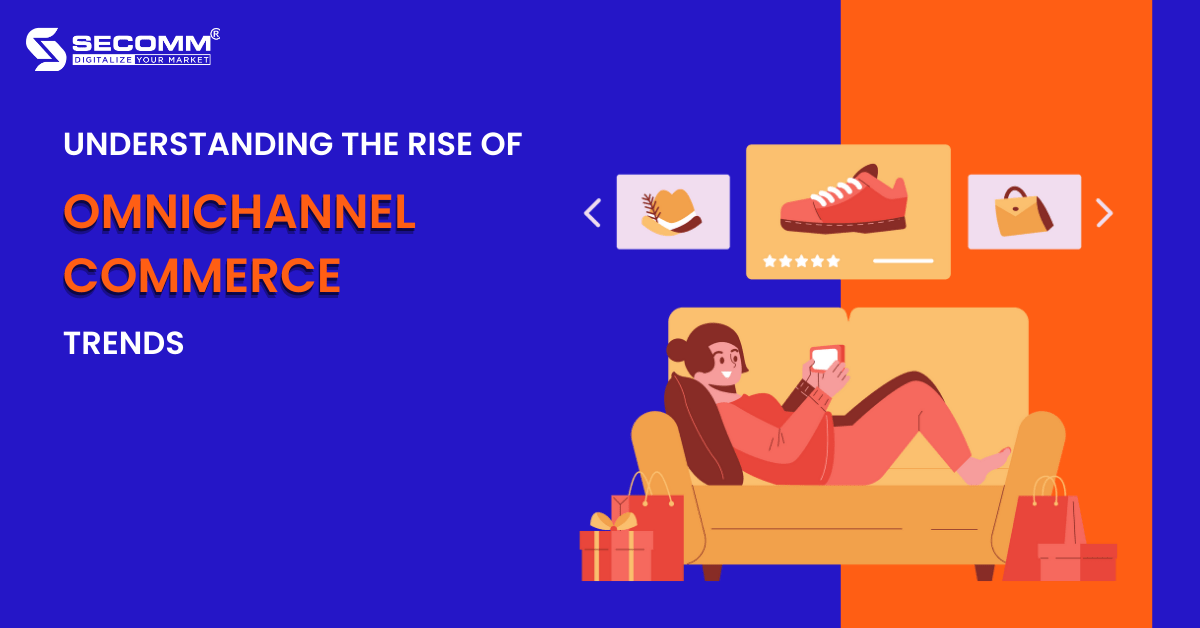
We are living in a world where the younger generation has taken the lead in setting ever-rising standards for digital experience. So, it’s important for businesses to quickly adapt to new trends for sustainable development to keep up with the shift.
Especially during a global pandemic, eCommerce has become one of the top priorities of every business owner. In order to thrive in a rapidly changing market and keep customers loyal, brick-and-mortar businesses have had to build an online presence and increase their eCommerce capabilities.
The term “Omnichannel Commerce” is defined as a “trend” that helps businesses achieve the aforementioned objectives and this trend is expected to continue to accelerate in the coming years.
Omnichannel Commerce is a multichannel approach that focuses on offering a seamless shopping experience by marketing and selling across all channels where potential customers are present including mobile devices, social networks, eCommerce websites, and brick-and-mortar stores.
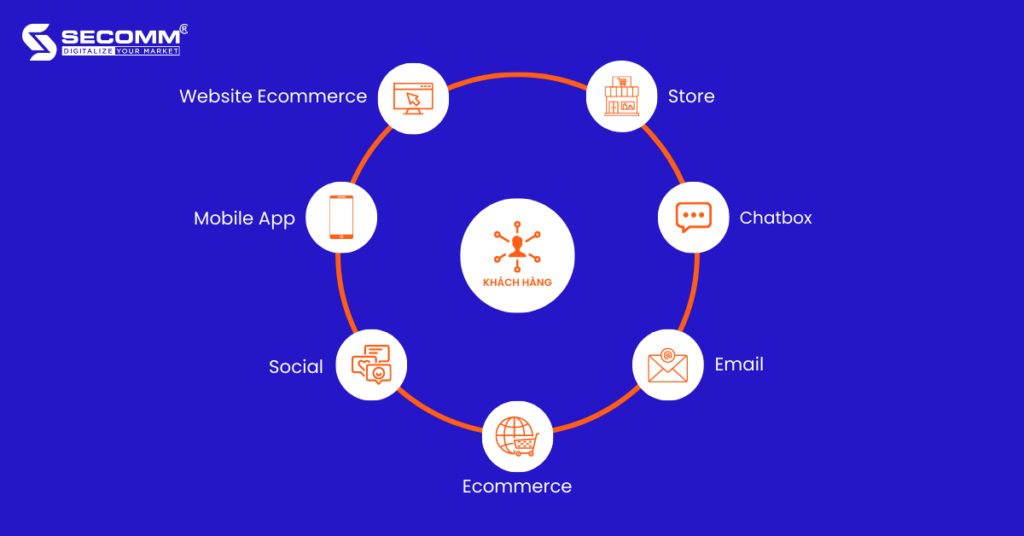
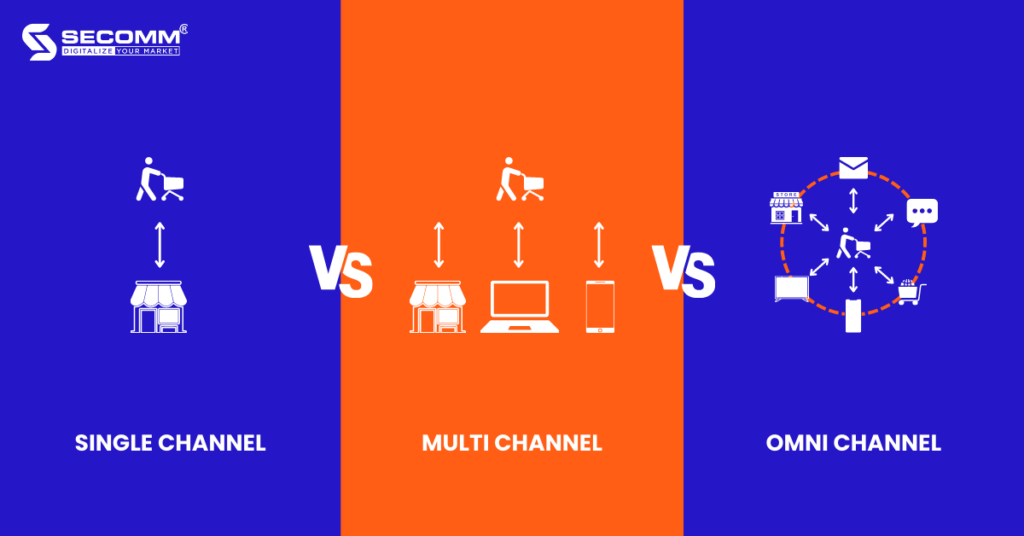
When a company sells its products or services only through one channel, that approach is known as single-channel commerce. It could be a physical store, an eCommerce website, or a marketplace like Shopee, Lazada, Tiki, etc.
Selling through a single channel could initially be quite successful, but if businesses desire to provide their customers with a richer shopping experience and increase brand awareness, they need to add multiple channels to showcase and sell their products or services.
When it comes to the Multichannel Commerce strategy, businesses will interact with customers and sell their products through both online and offline channels. This strategy makes use of touchpoints where customers can perform the same action at any available channel. These touchpoints, however, are independent and barely or not at all connected among channels. For example, a physical store with an eCommerce website has no inventory-sharing function.
Similar to Multichannel Commerce, Omnichannel Commerce enables a company’s marketing and sales efforts to be spread across numerous channels. The main distinction is that Omnichannel Commerce prioritizes the customer, connects all touchpoints, and creates a unified buying experience. But, Multichannel Commerce aims to reach as many channels as possible, with unique content for each and customers will interact with brands through their preferred channels.
An effective Omnichannel Commerce strategy includes effective operations of each sales channel that will be integrated in a seamless and consistent manner. Touchpoints should provide a unique but connected experience based on previous interactions. That experience takes customers to the end of the customer journey to get the business’s objectives.
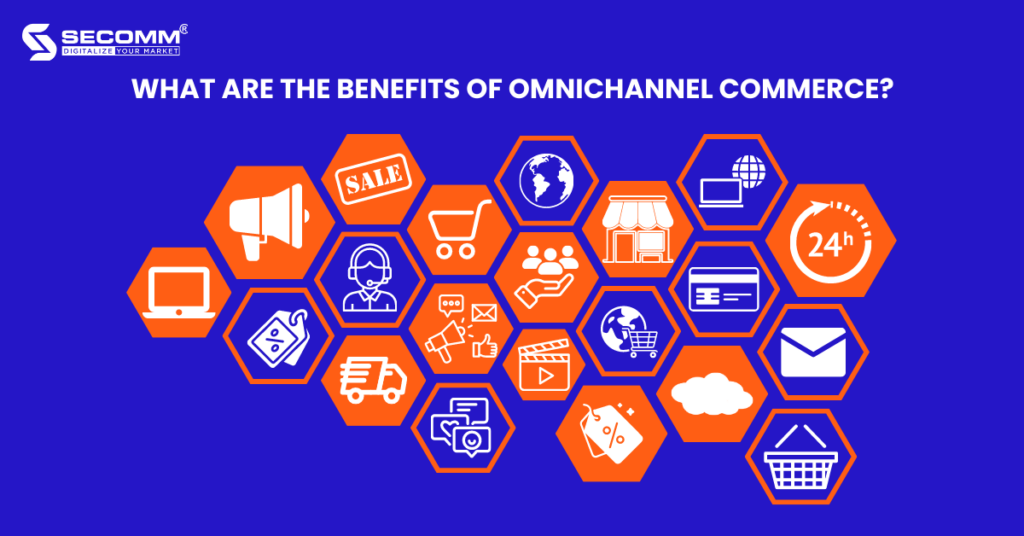
Imagine a man who wanted to buy a new washing machine. After seeing an attractive TVC with the merchant’s information, he used his laptop to begin searching on the Internet. He discovered the merchant’s eCommerce website, and his desired product is offered at a local physical store. He decided to add that product to his shopping cart after chatting with the customer service team.
He downloaded the merchant’s app, signed into his account, and accessed his cart before heading to the store because he wanted to see and check that washing machine in person before making a purchase. He checked the app to ensure the item is still in stock, its quantity, the best payment method, and any associated special offers.
When he arrived, he checked the product’s quality and checked out with the QR Code. The transaction is finished. Under the CRM system, his information and data would be saved for upcoming marketing campaigns and post-sale efforts.
Nowadays, consumers receive a ton of offers and messages from many brands day after day. This brings up many considerations when choosing a brand to engage with. Developing an Omnichannel strategy to connect with customers in a seamless manner across multiple channels will set a brand apart from the competition.
Omnichannel Commerce is a customer-centric model, connecting touchpoints and providing personalized experiences. This contributes to the company’s revenue increase as expected with cross-sell and up-sell opportunities.
Also, the branding strategy will be effective and successful, enhancing customer loyalty as well as the brand message will reach the right target audience thanks to the consistency of the Omnichannel Commerce model. It’s not only useful for increasing customer engagement but also for customer data evaluation.
Thus, businesses will have a bigger picture of the customer journey, the times and channels customers usually interact with, as well as the most effective and valuable marketing campaigns. All this data needs to be meticulously analyzed and reused in the next marketing campaigns.
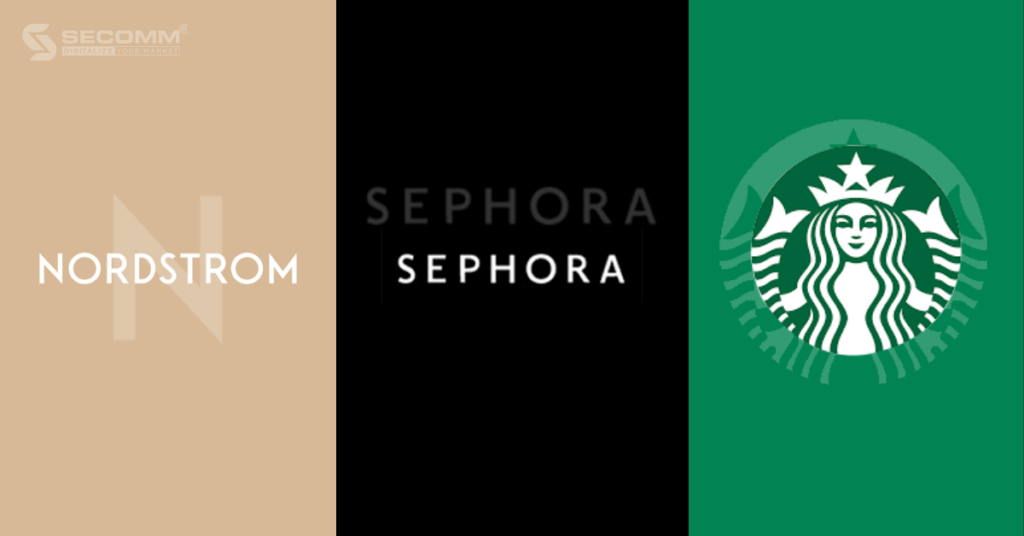
Omnichannel Commerce has long been a strength for Nordstrom. They created the Pincode feature that allows customers to use their smartphone to scan and access Pinterest to get a $100 Nordstrom giveaway while in the store. The brand also showcases in the store Pinterest’s best-selling products as an interesting suggestion.
In addition to Pinterest, it uses Youtube to create video tutorials for matching outfits and suggests its customers go to the physical store to meet a professional. At the store, they will receive valuable advice that may lead to a purchase decision.
Recently, Nordstrom has leveraged Instagram’s shoppable posts to inspire shopping and encourage customers to make quick decisions.

Sephora is one of the major brands in the beauty industry that is successful with Omnichannel Commerce. The company has established a strong connection between online and offline shopping experiences. Customers can access Sephora Beauty Bag’s personal account by using available tablets in its brick-and-mortar stores.
This account allows them to look up details of the items they are interested in and try them out using virtual reality. Additionally, Sephora’s benefits, like its in-store makeup tutorials and personalized gifts, have encouraged customers to make larger purchases.
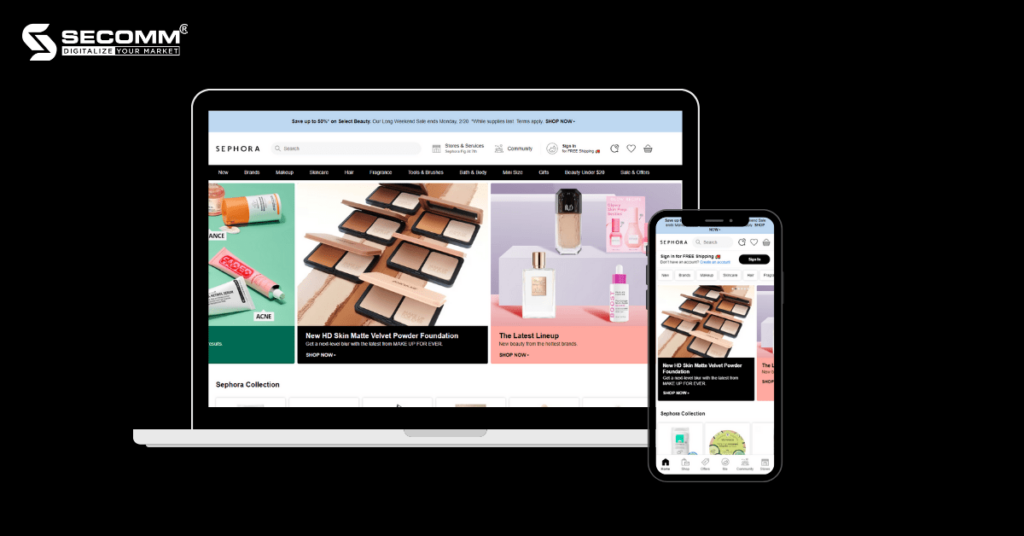
The world-famous beverage brand – Starbucks has launched the Starbucks Rewards App which is considered the pinnacle of Omnichannel Commerce. After creating an account, Starbucks fans can find a list of local stores, order drinks, and pay in advance so they don’t have to wait in line.
The app also regularly makes personalized recommendations for each customer based on previous orders, loyalty programs, weather, holiday seasons, or local store inventory.

Keeping up with the ever-changing business world is not easy. In fact, many big brands in the world have implemented Omnichannel Commerce early and have achieved great success. Plus, many other businesses are tending to gradually shift from Single-channel or Multichannel to Omnichannel and recognize this model as a bridge connecting customer experience between online and offline channels in a seamless way.
With many years of experience in successfully implementing eCommerce for many customers in many countries, SECOMM understands the difficulties when doing an Omnichannel Commerce strategy.
Contact our expert now to get a free consultation.
 2
2
 4,072
4,072
 0
0
 1
1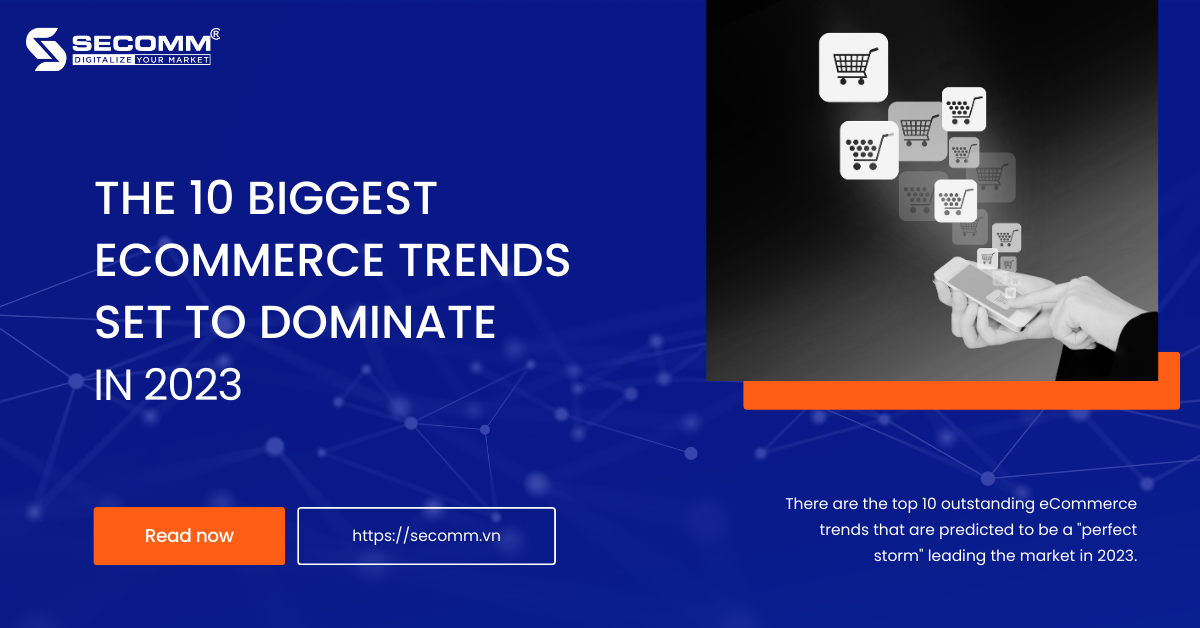
The eCommerce industry has a sizable market share in the Vietnamese economy and has shown impressive growth over the past two years due to the effects of the worldwide pandemic and social isolation.
After a year of society adjusting to the “new normal”, customers have started to buy at traditional stores again but the established trend of eCommerce consumption and the push from the wave of global digital transformation have encouraged businesses to change in order to suit the way the digital economy works.
Therefore, recognizing and anticipating the eCommerce trend of 2023 is extremely necessary for businesses’ New Year’s Marketing strategies to be implemented effectively and successfully.
Below is a list of 10 eCommerce trends that are forecast to “storm” the market in the next year.
Omnichannel is an omnichannel sales model that helps businesses reach customers through many channels such as eCommerce websites, social networks, eCommerce platforms, chain stores, and distribution agents but operating in just one management system.
Additionally, there is a second type of sales model called “Multi-channel” that differs from Omnichannel in that it allows for discrete marketing content, unlinked data, and independent channel operation.
When purchasing across numerous channels, continuous and seamless updates result in a heterogeneous and seamless customer experience.

Due to the lifting of social distance restrictions, consumers are beginning to return to in-store buying after two years of online shopping.
However, that doesn’t mean that eCommerce’s growth momentum is stagnant; on the contrary, it keeps exploding.
Businesses there make use of the current rise in popularity of online shopping to encourage the use of Omnichannel to improve the varied and efficient shopping experience.
As researchers have noted:
As a result, 2023 will still be recognized as a strong year for omnichannel in eCommerce.
Mobile Commerce or mCommerce is a business model that allows companies and individuals to deliver goods and services directly to consumers through handheld wireless devices such as smartphones and tablets.
According to Bankmycell, the number of smartphone users worldwide in 2022 is 6.648 billion, equivalent to 83.07% of the world population owning a smartphone.
Moreover, it is predicted that this number will increase to 7,516 billion by 2026. In addition, the percentage of global users participating in online shopping in 2022 accounts for 58.4%.
In Vietnam alone, interesting figures are listed in the Vietnam eCommerce White Book in 2022:
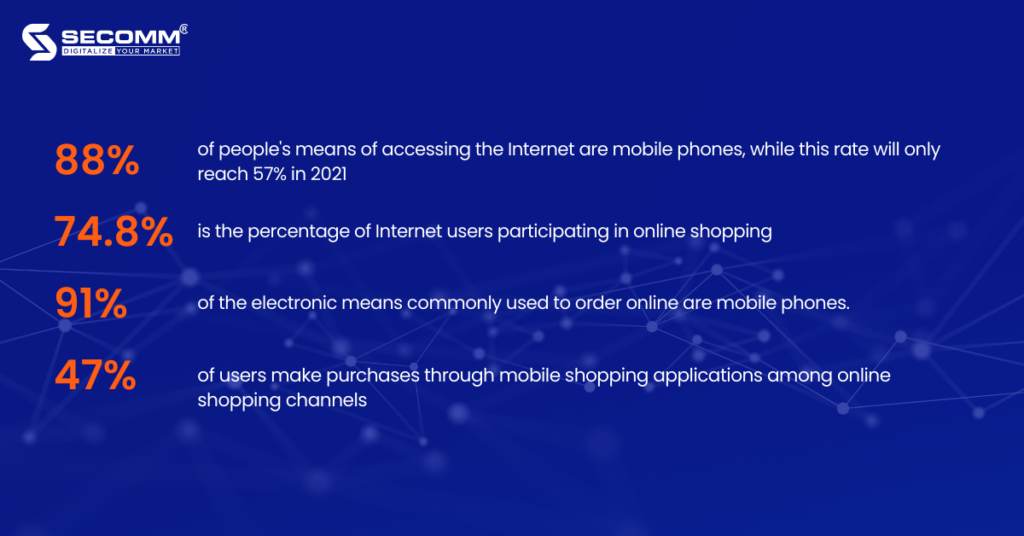
In upcoming years, the percentage of global people and Vietnamese people as well who own mobile devices and use them for online shopping is high and predicted to increase significantly.
Social commerce refers to the method through which companies advertise and sell goods and services online using social networking sites like Facebook, Instagram, TikTok, Youtube, Zalo, etc. In other words, this type of business combines eCommerce and social media.
The impact of social networks has grown significantly in recent years. Over 59% of the world’s population uses social media, it is not surprising that this percentage will continue to rise.
While in the past businesses used social media to raise brand awareness and draw in new customers, today eCommerce businesses boost sales by offering goods and services to clients online via social media.
As a result, it’s incredibly handy for customers to interact, exchange information, and search and shop online all in one location.
According to Statista, global social commerce sales will reach $992 billion in 2022 and are projected to reach nearly $3 trillion by 2026.
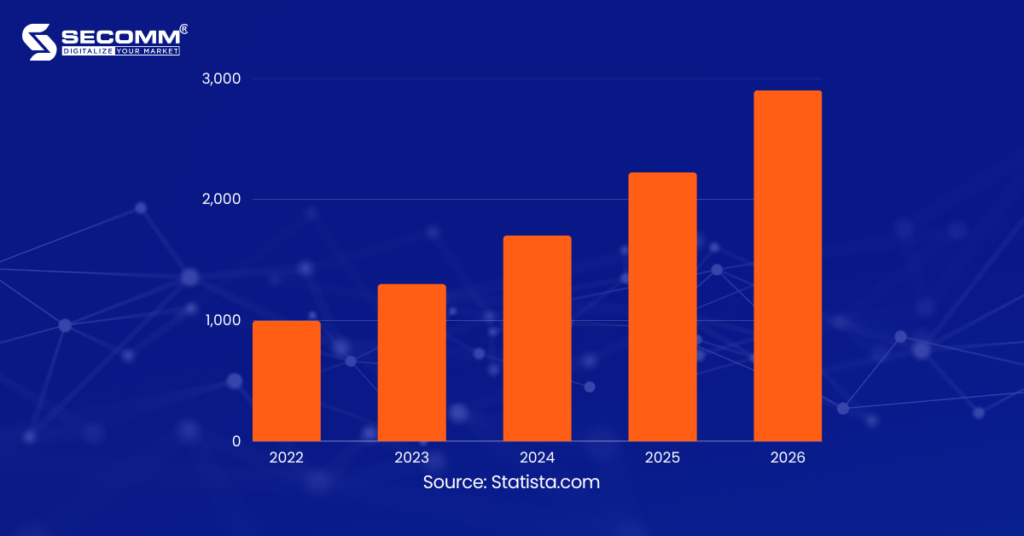
Thanks to the development of social networks, social commerce has had a strong acceleration and has become a magnet for brands to come to approach and analyze a large number of potential customers, and achieve marketing and sales goals.
As a result, failing to prioritize social commerce in enterprises’ marketing strategies in 2023 is probably to lead to a significant loss of competitive advantages in the eCommerce market.
Today, businesses have a lot of choices to build an eCommerce website, but basically, the structure of a website will include the following main parts:
For websites using a traditional structure, the frontend and backend will be operated on the same platform and from there will be closely connected with each other. Therefore, any changes on the website will be edited in two parts at the same time. However, with Headless Commerce, the backend and frontend will be decoupled from each other and operate independently on two separate systems.
The benefits of deploying Headless Commerce:
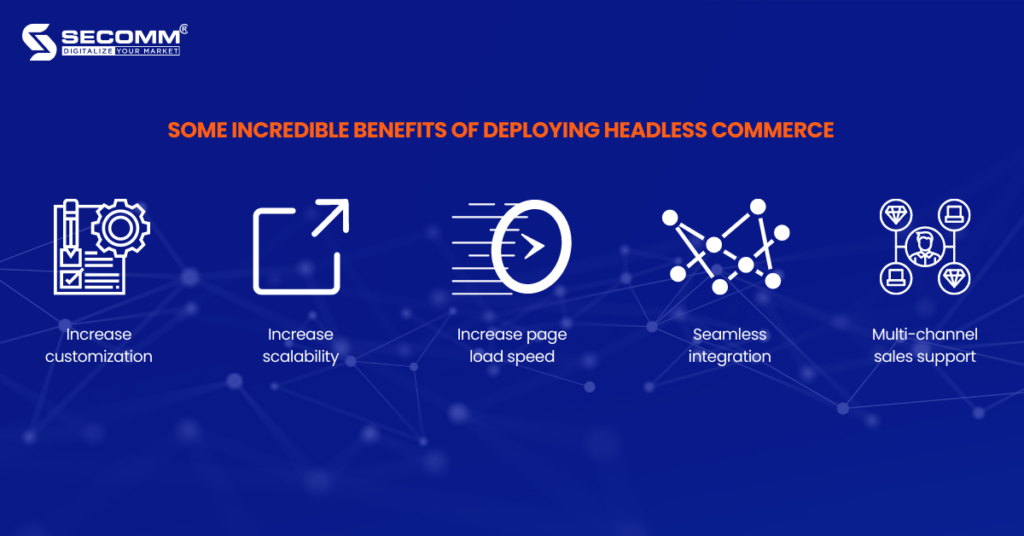
By using the Headless structure, Nike has become a brand with a much larger market share than Adidas – a formidable competitor of Nike.
Moreover, Nike’s website recorded more than 60 million pageviews in just 1 month. In addition, the proportion of direct purchases without intermediaries also increased significantly.
From Nike’s Case Study, one of the practical alternatives for companies looking to encourage eCommerce sales growth is Headless Commerce.
Shoppertainment is a form of shopping combined with entertainment that is used as a marketing strategy to encourage customer engagement with brands and consequently increase shopping demand. Moreover, it is used and takes over most of the online commerce in the era of digital transformation, when eCommerce is positioned at the forefront of contemporary business trends.
Some common practices of Shoppertainment trends:
These three practices all focus on entertainment and interaction. Then, the emotional element is aroused, leading to a series of unwise and unplanned shopping decisions. From a business perspective, this is beneficial for brands. TikTok‘s recent research proves it:
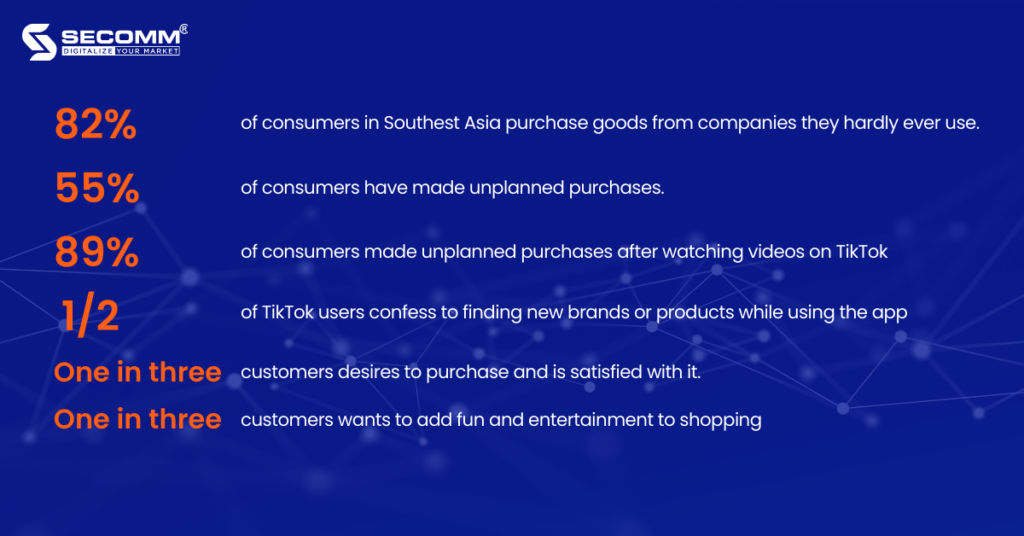
The growth of the Shoppertainment trend in recent years demonstrates the extreme demand for social interaction and connection following the period of Covid’s life.
Shoppertainment is the solution that businesses seek. This is a way to make the most of the customer’s biggest weakness – emotions.
When feelings of euphoria and joy are elicited during the shopping process, customers engage more, and purchase more unplanned products, conversion rates are higher, and sales follow.
Artificial intelligence now has a significant impact on eCommerce businesses in providing solutions to optimize the online shopping experience of customers.
The following statistics demonstrate the incredible influence of AI on the eCommerce market and businesses operating in this field:
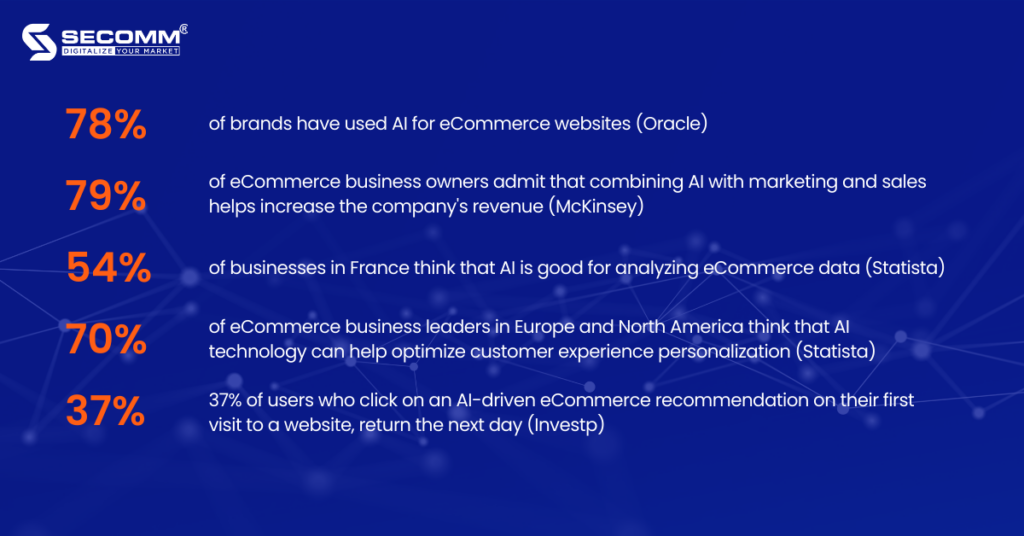
Currently, there are two applications of AI technology that are commonly used in eCommerce:
For eCommerce businesses, Chatbots will be like salespeople who can interact directly with customers 24/7. This helps businesses narrow the distance in terms of geography and time zones, helping the sales and customer services process to take place effectively without interruption.
By collecting customer data, AI can create tailored content and recommendations for each specific customer. To improve marketing campaigns and personalize the customer experience, AI can also predict purchasing behavior based on a user’s browsing and search history, when the data is legally available.
VR (Virtual Reality) is a modern technology that brings users into a simulated but still very realistic space with only 3D glasses (virtual reality glasses). The virtual world that the user sees is actually set up and controlled by a highly configurable computer system.
AR (Augmented Reality) is a new technology enhanced from VR technology. This technology has the potential to erase the boundary between the real world and the virtual 3D model. That is, users will experience virtual models in real space through smartphones or computers.
With a clear plan and the appropriate approach, Lazada has been in front of the augmented reality trend for a number of years and developed a certain competitive advantage in luring both consumers and sellers.

In particular, the VTO (Virtual Try On) function on Lazada includes a wealth of features to assist customers in freely selecting and trying goods like eyeshadow, eyeliner, foundation, and cushions whenever and wherever they like.
Since its launch, LazMall brand partners in the cosmetics sector have experienced tremendous success with the VTO function, which has helped to boost conversion rates by 3.1x and average order values by up to 11%.
The rapid growth of social networks and eCommerce has given marketing efforts a fresh and original breeze thanks to KOL/KOC. Although KOL and KOC have long existed in some form, they have truly taken off in recent years.
KOL – Key opinion leader, also known as an “influencer”, is an individual or organization with expert product knowledge and influence in their field or industry.
KOC – Key Opinion Consumers are “the most influential consumers in the market”. Their job is to test products and services and make comments and reviews.
KOL will suit mid- to high-end brands, while KOC will suit mid-range brands. If KOL is used to select brand ambassadors, holiday season ambassadors, or product launch campaigns, KOC is used to boost sales in a short time or direct customers to websites or eCommerce platforms.
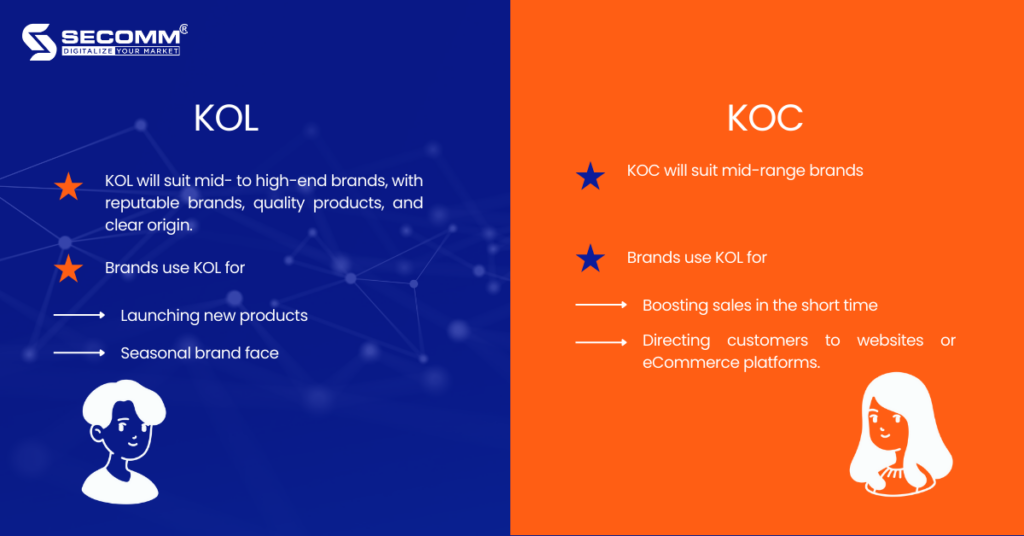
Some famous KOLs in Vietnam: Helly Tong, Giang Oi, Dino Vu, Co em Trendy, Chau Bui, Khanh Vy, Khoai Lang Thang,…
Some famous KOCs in Vietnam: Ha Linh, Call Me Duy, 1m88, Ong Giao Review, Chau Muoi, Hoang Viet, Pu Met 7,…
BOPIS – Buy Online Pick-up In Store is one of the shopping trends that promise to explode in 2023. Customers won’t have to be concerned about shipping costs, extended delivery times, or the risk of receiving unexpected goods when using BOPIS.
Businesses all around the world are pushing up their BOPIS implementation to meet customer expectations when merging online buying with in-person pickup. This is the ideal approach to boost store visits and close the gap between the offline and online buying experiences.
According to GlobeNewswire, the global BOPIS market is projected to reach $703 billion by 2027 with an estimated CARG of 19.3% between 2021-2027.
In addition, the following BOPIS trend statistics can help businesses consider implementing in 2023:
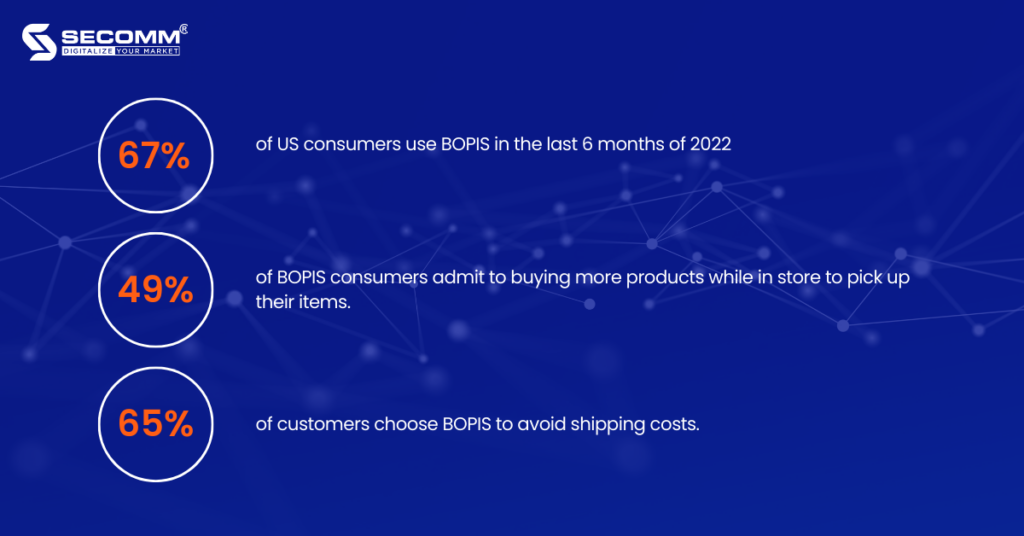
The BOPIS model also aids businesses in cutting expenses, expediting deliveries, boosting demand for retail goods, and lowering the risk of product returns.
User Generated Content, also known as UGC, includes text, photos, video and reviews. Because people are becoming less and less engaged in the brand’s message over the past ten years, UGC has grown in importance.
According to a recent Salesforce survey, 53% of Millennials think user-generated content (UGC) influences their shopping decisions, and 92% of consumers prefer content created by friends and family over that created by brands. The reason for the above numbers is trust.
Therefore, user-generated content (UGC), such as photos, videos, and customer evaluations, is trustworthy social proof and aids in the development of a company’s reputation.
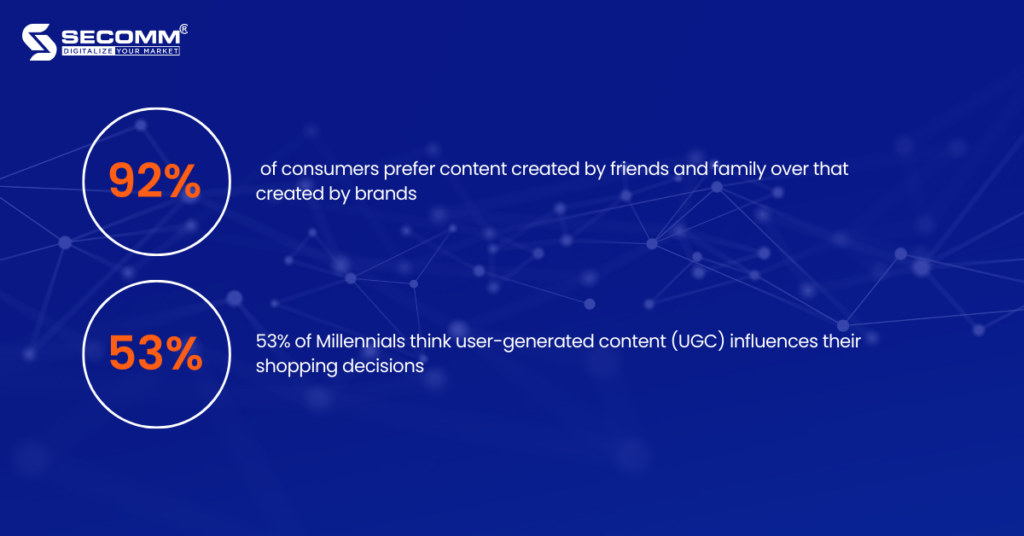
In a nutshell, businesses must quickly adapt to evolving eCommerce and digital technology trends in order to avoid falling behind and being driven out of the market. By reading 10 eCommerce trends that stated and analyzed above, businesses will have an overview to be ready for the new journey.
With many years of experience in successfully implementing eCommerce for many customers in many countries, SECOMM specializes in providing consulting services with comprehensive and professional eCommerce implementation solutions.
Contact SECOMM today for free support and advice.
 2
2
 5,373
5,373
 0
0
 1
1
Over time, the Covid-19 pandemic has greatly damaged the world economy, with significant consequences for investors and business owners across a wide range of sectors, including the wine sector.
Sales of alcoholic beverages have decreased dramatically as a result of the closure of hotels, restaurants, and nightclubs as well as the postponement of big events and festivals.
Despite the global economic issues, eCommerce must be considered among the industries that perform very well. Some companies across multiple areas have enthusiastically embraced eCommerce to weather the downturn.
Also, wine firms follow that wave of change, making eCommerce shine in the new era – the era of digital transformation.
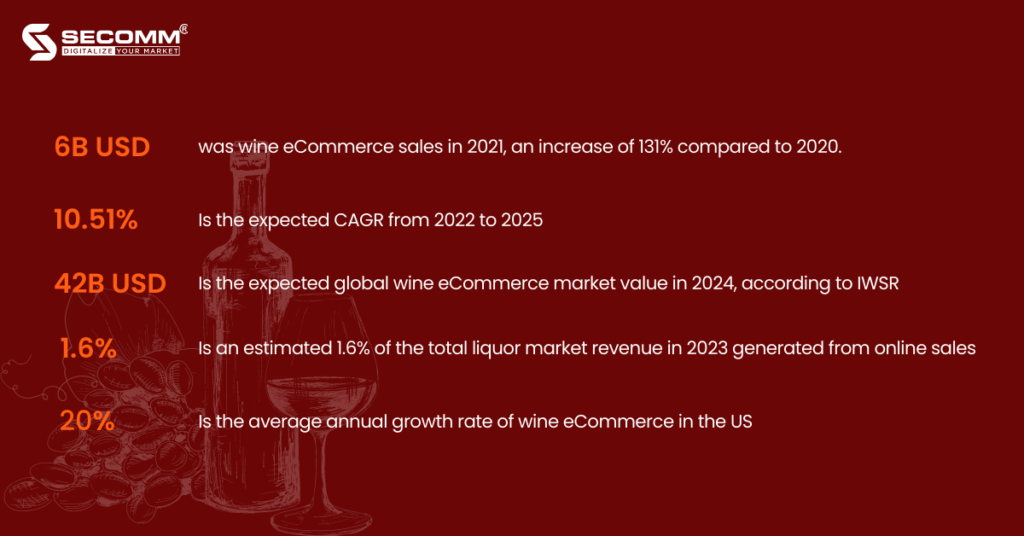
Global Pandemic
In the midst of the global pandemic-related crises, the wine business, like many others, saw a breakthrough in the speed of online purchasing.
When the pandemic breakout occurred, 44% of American consumers placed their first-ever online wine and liquor orders.
The year 2020 saw a 42% increase in wine eCommerce as a result. Online wine sales increased from just $1 billion in 2018 to $6 billion by 2021.
Young wine consumer
In the US, according to Avalara, Millennials and the legal drinking age population are steadily increasing.
By 2023, the Millennial generation is estimated to account for nearly 45% of the LDA (Legal Drinking Age) population under the age of 80. By 2030, this number is projected to be 54%.
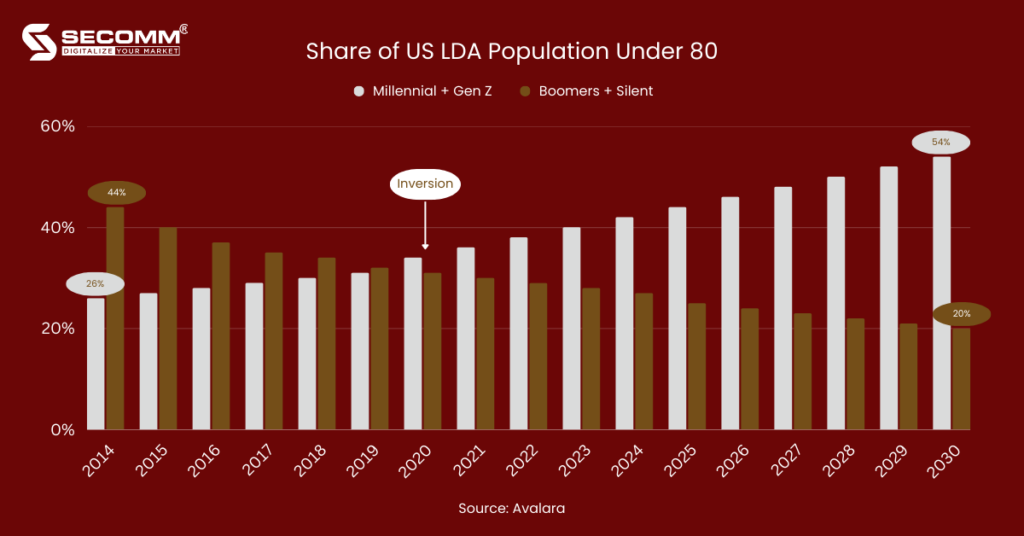
In Vietnam, Millennials (25–38 years old) and Gen Z (18–24 years old), often known as MillennialZ, currently make up 47% of the population or about 45 million people who are of drinking age. The population structure of the MillennialZ generation is expected to keep growing.
The primary factors influencing the growth of the eCommerce sector as well as the digital economy of Vietnam will also be the young people’s awareness of and keeping up with new trends in digital technology compared to previous generations.
The Duty Free Shop Group (DFS) and Changi Airport Group (CAG) collaborated on the iShop Changi Wines eCommerce online project, which offers world-renowned and premium wines and spirits with exclusive discounts to visitors to Changi Airport, particularly those who are CAG members.
The iShop Changi Wines website is cutting-edge and exquisitely styled, showcasing the distinctive qualities of the wine industry as well as the aesthetics from page layout, color, font text, logo, and banner, all of which are guaranteed to optimize the purchasing experience while also, and this is crucial, emphasizing the identity and brand-development elements for both CAG and DFS.
Due to the fact that this is a project of well-known companies, the iShop Changi Wines website has consistently received a lot of traffic, averaging approximately 592 thousand views each month since its introduction.
Therefore, to combat the unexpected surge in traffic and orders during the busiest shopping seasons of the year, the eCommerce system must be continually enhanced and optimized.

The fact that major corporations CAG and DFS both started and developed successful wine eCommerce websites shows the enormous potential of this industry now and in the future.
Previously, the business scope of wine businesses was quite limited, but now that limit has been broken thanks to the dominance of the Internet and the rise of eCommerce.
Moreover, the government’s assistance in lowering legal restrictions has given wine producers the assurance to confidently market their goods to a significant number of potential buyers in several nations across the world.
The Warehouse, established in 2001, is renowned as a top supplier of wines and spirits in Vietnam, offering more than 16 different varieties of wine from numerous nations.
In addition, along with Annam Gourmet Market, Yves Rocher, and Flormar, this is another well-known retail brand of the Nam Group. Before being formally put on the market, products at The Warehouse are consistently inspected and carefully chosen to fulfill quality criteria.
The company has so far increased the reach of its distribution network across the nation, including Ho Chi Minh City, Hanoi, Da Nang, Nha Trang, Hoi An, Quang Ninh, and Phu Quoc.
The Warehouse achieved its objective of serving the wine market with B2B and B2C business models by utilizing the Magento platform.
This implies that the business will broaden the retail channel to include private customers in addition to distributing wines to restaurants, hotels, resorts, pubs, and lounges.
A series of symbols, logos, and banners created especially to fit the characteristics of the wine industry are combined with Bordeaux red to create a website interface that is focused on UI/UX perfection.

The Warehouse is flexible, secure, and has quick ordering, payment, and delivery options. Therefore, customers can place orders through phone, mobile app, or eCommerce website.
Customers can then pick up their purchases from the store or, in major cities like HCM, Hanoi, and Da Nang, the company will deliver them quickly within 2 to 3 hours. In other places, conventional courier delivery takes 2 to 5 days.
The Warehouse has been successful in raising brand recognition, expanding its customer base, and increasing both offline and online sales as a result of the timely growth of its business model and digital transformation
Long-standing Australian company Trentham Estate Winery, founded in 1988, focuses on the manufacture and distribution of wine.
After many years in business, the company is well regarded for its creativity in the wine-making process, which resulted in a variety of wines with different delicious flavors. Also, the brand has received hundreds of medals, titles, and other industry awards.
In the beginning, the business created and ran a WordPress website system for branding purposes.
Trentham Estate, however, has been forced to increase its company scale by making a substantial investment in an entire eCommerce website system due to the growth of eCommerce and the increasingly varied purchasing needs of potential clients.

In the beginning, the business created and ran a WordPress website system for branding purposes. Trentham Estate, however, has been forced to increase its company scale by making a substantial investment in an entire eCommerce website system due to the growth of eCommerce and the increasingly varied purchasing needs of potential clients.
That is what led to the creation of the website trenthamestate.com.au, which has a modern interface while still accurately capturing the distinctive features of the wine industry.
Similar to The Warehouse, Trentham Estate likewise creates an eCommerce website based on the Magento platform with a variety of features that satisfies eCommerce requirements and wine industry specifics.
Therefore, businesses can access and serve a wide range of large customer files not only in Australia and internationally thanks to effective marketing and branding strategies, towards a sustainable business model along with the changes of the digital age.
It would be hard to believe that an industry as sensitive as wine could be traded online so easily and efficiently. In that efficiency and convenience, there is a great contribution of the trend of eCommerce and the comprehensive National Digital Transformation program that is committed to supporting by the Government. This is an extremely appropriate time for wine businesses to confidently deploy eCommerce because of the support from the Government and the push from the market.
However, planning to implementation are two completely different categories. Businesses are required to have a practical strategy and technical assistance from highly skilled firms to hasten the success journey and help advance the National Digital Transformation goal.
SECOMM has many years of expertise in effectively executing eCommerce for numerous customers in various countries. We specialize in offering free consultation services with qualified eCommerce implementation solutions.
Contact us right away for free counsel and assistance.
 2
2
 4,773
4,773
 0
0
 1
1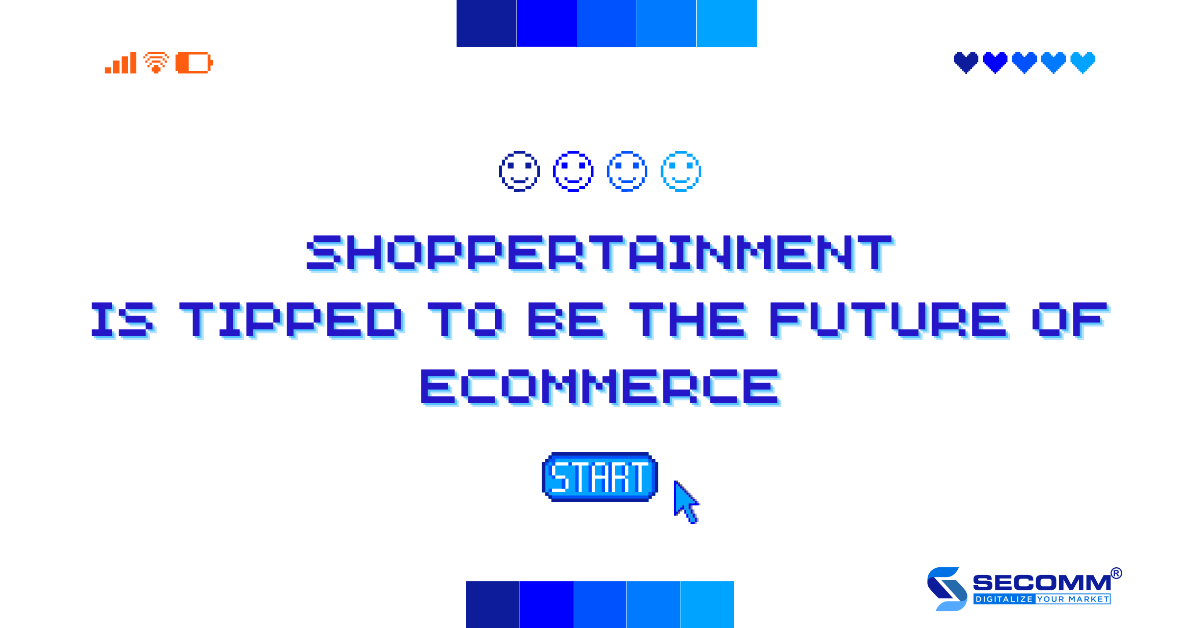
The Covid-19 pandemic not only encourages the tremendous growth of eCommerce but also helps shift consumers’ priorities from in-store to online buying. However, instead of just buying, consumers frequently prefer to seek out novel, inspiring experiences.
Therefore, every company should strive to implement the approach of shopping combined with entertainment (Shoppertainment) in order to improve marketing effectiveness and boost sales.
Shoppertainment is a combination of two elements “shopper/shopping” and “entertainment”.
Shoppertainment is described as “the provision of recreational or leisure facilities within or next to a retail store or shopping center, as part of a marketing strategy, which is designed to attract customers and stimulate purchasing” in the Oxford Dictionary (1990).
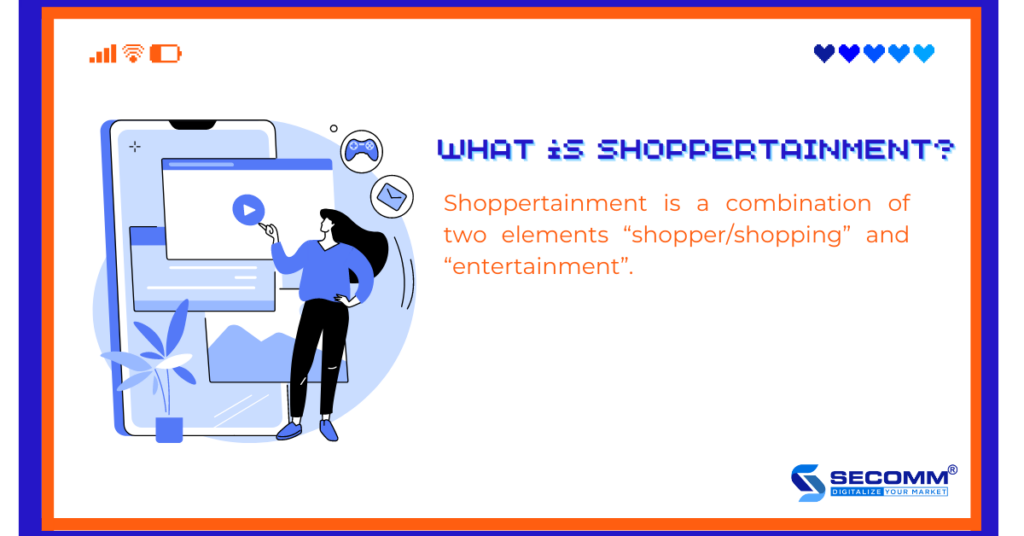
Many companies, notably IKEA, the biggest furniture retailer in the world, have used shoppertainment with success in the past. IKEA launched a campaign in 2019 called “IKEA nightclub – Tonight is to sleep” for 100 lucky individuals.
During this campaign, customers can partake in activities like manicures, massages, snacks, and tea instead of cocktails before spending the night in rooms with IKEA furniture that is soon to be released.
The brand has had remarkable sales success thanks to the campaign’s resonance in North America.
The shoppertainment trend, however, is no longer just restricted to stores or other physical locations thanks to the growth of eCommerce and digital marketing but has instead gained popularity and taken over online shopping activities.
In comparison to the prior definition, shoppertainment has been enlarged and changed. Shoppertainment is a trend that combines online shopping with entertainment, allowing buyers to engage with merchants in addition to purchasing products as usual.
In Vietnam and in the Asia-Pacific region, certain forms of entertainment-infused shopping are very common. Examples include live streaming, shoppable videos, and gamification.
According to the Vietnam eCommerce White Paper 2022, the size of the retail eCommerce market in Vietnam will increase from $11.8 billion in 2020 to $13.7 billion in 2021 and is estimated to reach 16.4 billion USD in 2022.
Meanwhile, the percentage of consumers shopping online on eCommerce websites is 78% in 2021, up 4% over the same period last year.
Because of the urgency, lack of options, and social isolation, the effects of the epidemic have actually contributed to a change in consumption tendencies from in-person purchases to online purchases.
Since that time, it has seen the quick decline of the conventional commerce model and the rise of eCommerce. By 2026, Statista projects that eCommerce sales will total $8.1 trillion.
Additionally, it is not surprising that consumers like shoppertainment. Although this combination is not novel, it promises to set the consumption trend in the years to come as eCommerce takes center stage.
The demand for online shopping will be higher there, and expectations for the best shopping experience—including both online shopping and fascinating experiences will also be higher.
Retail businesses around the world have seen a significant rise in sales during the outbreak by combining online shopping with live streams, entertainment videos, and video games to create real-time digital interactions with customers.
For instance, Taobao Live, which Alibaba introduced in 2016, saw a 150% surge in sales in 2020 when the epidemic first appeared in China.
“Shoppertainment is now a basic expectation. You really have to leverage engaging tools so the shopper gets to learn about the product, its superiority, and has fun along the way,” notes Alex Vogler, senior director and head of marketing, eBusiness, Procter & Gamble (P&G) Asia, Middle East, and Africa.
The Covid-19 pandemic has had a significant negative impact on the human psyche, causing issues including depression and anxiety. On the other hand, a portion of the populace said that the social connections they were unable to have prior to the epidemic significantly improved their psychological well-being.
People need to connect with the community and others like them more than just for amusement. Brands have therefore concentrated on improving the consumer experience by transforming personal experiences into shared ones that bring communities together.
As an example, consider the hashtag #TikTokMadeMeBuyIt. Through the TikTok platform, users can easily and amusingly share their shopping experiences, resulting in videos going viral and receiving more than 4.5 billion views.
Shoppertainment will result in emotional and impulsive purchasing decisions since it emphasizes entertainment and connection. According to a recent TikTok research:
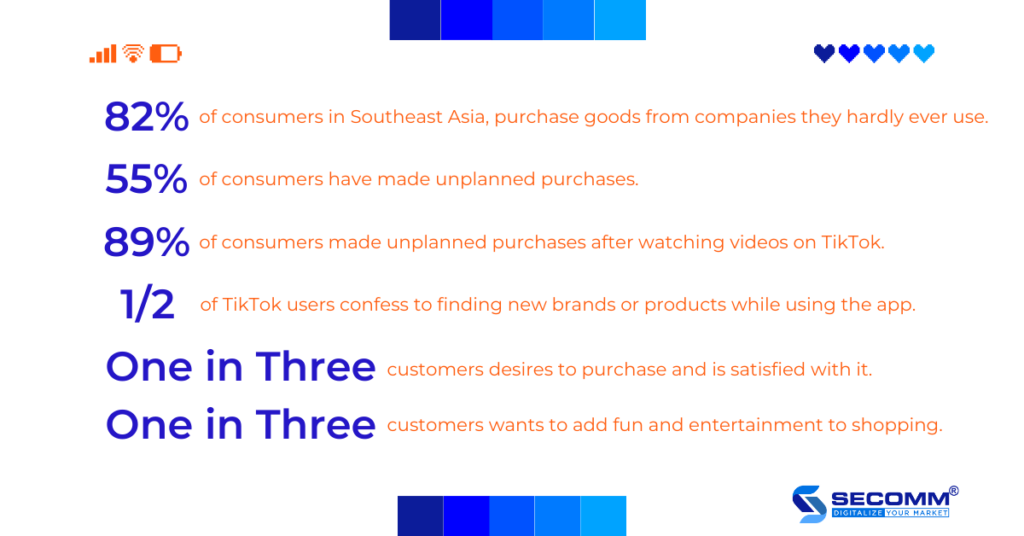
The studies mentioned above demonstrated the enormous influence that social networks and online shopping trends have on consumer decisions.
Because of this, Vietnamese retail companies have prioritized shoppertainment in their marketing plans.
Customers demand a more social and engaging online shopping experience, as well as the ability to connect and converse with one another while buying, which is the reason for any of this.
In recent years, both buyers and sellers in the Asia-Pacific (APAC) area have grown accustomed to live selling. Live selling is less common in the US and Europe than it is in APAC, but businesses there are nonetheless keeping an eye on this trend.
For instance, AliExpress initially introduced the live selling feature in France in May 2020, and since then, more than 3,000 live programs have been launched, with the involvement of more than 100 vendors.
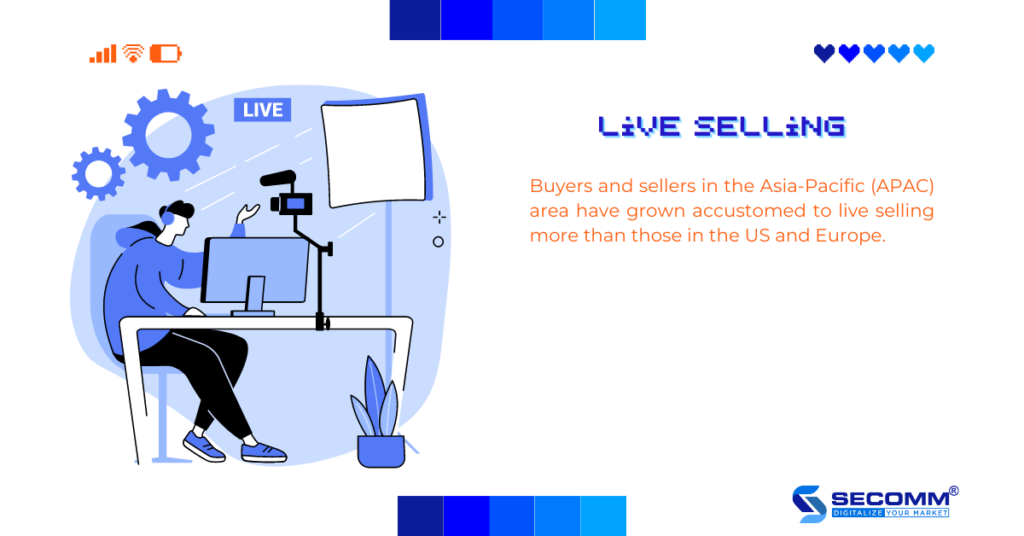
The combination of sales, interaction, and entertainment makes this one of the top social selling strategies. Customers can interact with vendors directly, view actual product photos, and make decisions by pushing their shopping emotions.
Plus, the engaging social interactions that take place throughout live streaming help retailers make an impact on customers, resulting in a high return rate.
Due to the growth of the Shoppertainment trend and the effectiveness of live streaming in generating sales through social networks, eCommerce marketplaces have started to put more of an emphasis on investing in producing engaging entertainment material for users on their apps, particularly through live streaming.
The customer buying experience is improved by several well-known live stream channels, like TaobaoLive, LazLive, Shopee Live, TikiLive, etc.
These companies have the resources to develop this feature for themselves, but lower-budgeted companies can still try the live-selling concept by integrating Facebook or YouTube live stream with an eCommerce website.
Live-streaming videos will be effectively replaced by shoppable videos. One of the joys of using this type of video is that companies may produce videos in their own distinctive styles that quickly introduce customers to their products, explain how they operate, and demonstrate how to use them. These videos can be attached to an eCommerce website. Users can always click the product link in this kind of short video to find out extra details or to make a purchase. The short-form video has overtaken popular platforms like TikTok, Instagram Reels, and Youtube Shorts as the go-to method for branding, cultivating customer trust, and influencing purchasing decisions.
83% of people, according to Nielsen study, prefer watching videos of advertisements to GIFs or text. Short-form videos have gained popularity as a result of global digital transformation and consumer preference, and many brands now opt to use those as part of their video marketing strategies due to their useful advantages, which include the following:

Gamification or Gamification Marketing is the skillful incorporation of a video game’s mechanics into promotional operations in a unique and impressive method to meet marketing objectives.
Gamification’s primary advantage, similar to live selling, is engagement, which keeps people on the site, drives conversions, and boosts sales.
Users are actually more likely to return for more shopping if a business can convince them that engaging with it is an interesting experience rather than a transaction.
A study by Bazaar Voice demonstrates the impact of gamification on businesses’ marketing strategies as follows:
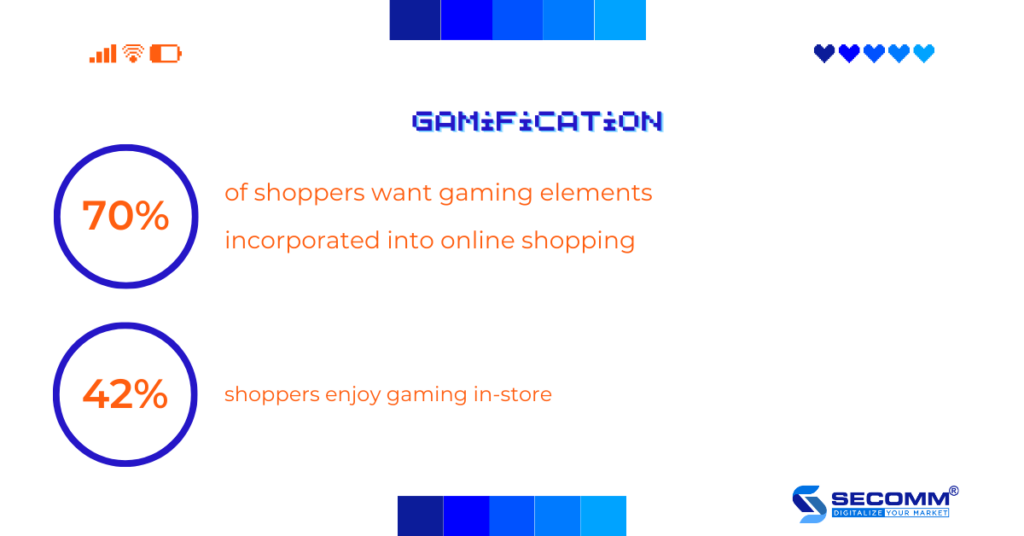
For instance, take Bajaj Finserv’s Indian financial company’s Gamification Marketing campaign. The game was created by this firm to encourage people to use its travel loan services.
Users will complete tasks and respond to questions about their preferred travel destinations. Customers adored the campaign, and it immediately trended on Twitter with more than 75 million impressions.
Thus demonstrating Bajaj Finserv’s efforts to develop engaging experiences and provide them to customers in line with its marketing strategy. Brands attract more potential customers, enjoy the better engagement, and increase conversions as a result of the viral impact.
Shoppertainment has been around for a while, but it wasn’t until Covid-19’s effect that this trend truly took off. Businesses should take advantage of this trend to improve the online shopping experience for customers and increase sales in the era of eCommerce.
Due to the growing demands of customers for a better shopping experience and the ongoing changes in the market, achieving this goal is difficult and labor-intensive. As a result, companies must work with expert agencies to plan the proper eCommerce deployment from the start.
With many years of experience in successfully implementing eCommerce for many customers in many countries, SECOMM specializes in providing consulting services with comprehensive and professional eCommerce implementation solutions.
Contact SECOMM today for free support and advice.
 3
3
 5,904
5,904
 0
0
 1
1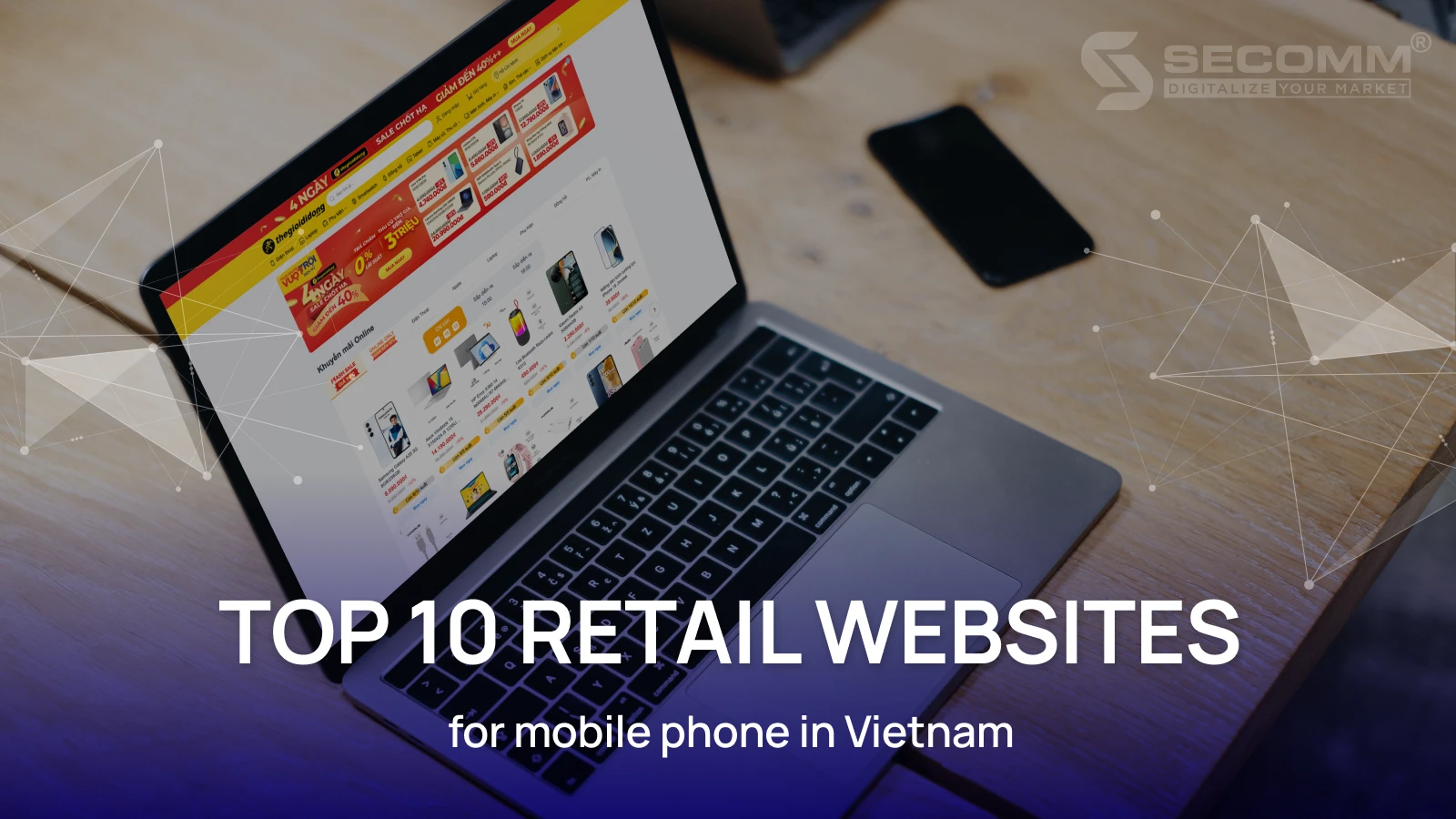
The retail market for mobile phones in Vietnam is booming like never before! With 61 million users, Vietnam is currently among the top 10 markets with the highest mobile phone usage in Asia. Furthermore, this market is predicted to grow in 2022 by 47.5% (according to Trendforce).
Taking advantage of this opportunity, many retail businesses in Vietnam have achieved tremendous success and continuously expanded their scale, such as The Gioi Di Dong, FPT Shop, Viettel Store, etc.
To contribute to this success, one cannot ignore e-commerce. Online sales channels such as websites, mobile apps, and e-commerce platforms play an increasingly important role for retail businesses in the mobile phone industry, especially post-pandemic.
According to Debasish Jana, an expert from the market research company Counterpoint Research, online sales of mobile phones have increased compared to the same period last year, accounting for 14% of the total market share. Not stopping there, the growth rate of online mobile phone retail is projected to increase even further shortly, reaching 29% by 2025 (according to Google, Temasek, Bain & Company).
E-commerce helps retail businesses develop their business models and contributes to revenue growth for enterprises.
The Gioi Di Dong is a brand under the company The Gioi Di Dong Joint Stock Company, established in 2004. According to Euromonitor International, The Gioi Di Dong is the largest online retail company in Vietnam, holding a 10% market share. It is also the leading retail chain for mobile devices in Vietnam, with approximately 1,000 stores present in all 63 provinces and cities nationwide.
Currently, this retail business is heavily investing in online sales systems such as websites and apps.

CellphoneS is a retail system for well-known technology products in Vietnam. Currently, the business has a presence in Ho Chi Minh City, Hanoi, Binh Duong, Hai Duong, Hai Phong, Bac Ninh, Vinh Phuc, Thai Nguyen, and Vung Tau.
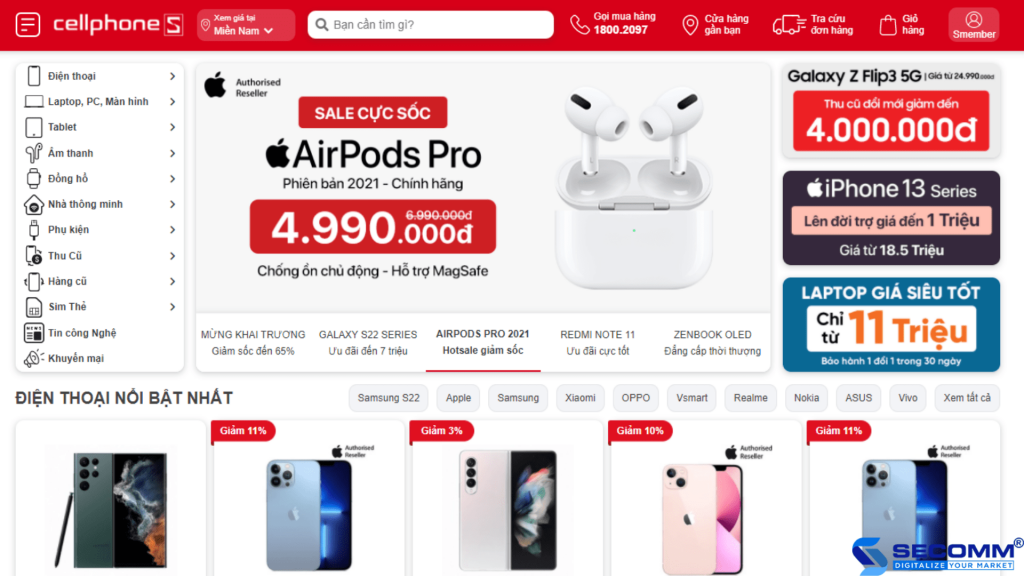
FPT Shop is under the ownership of FPT Corporation Vietnam, established in 2012. It is an officially authorized dealer of Apple in Vietnam at the highest level, specializing in providing genuine electronic products. Currently, the retail chain system spans across the country with stores in all 63 provinces and cities.
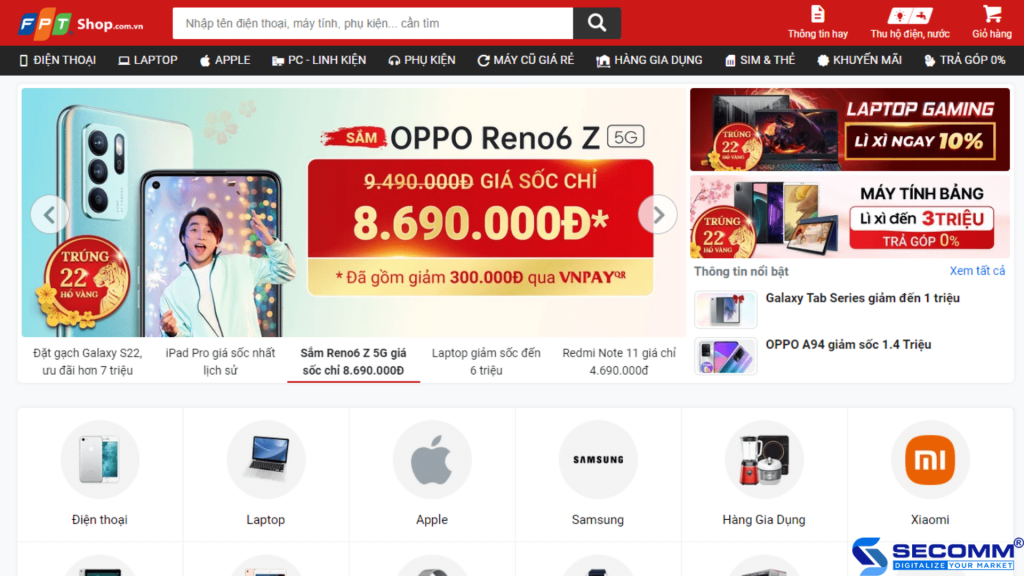
Hoang Ha Mobile is a retail system specializing in providing genuine technology products and well-known mobile phones in Vietnam, established in 2014. Currently, the business has over 90 branches spanning from the North to the South.

The Mobile Technology Company Limited operates the Didongviet.vn retail chain, established in 2009 as a reputable system specializing in genuine technology products, notably mobile phones, tablets, laptops, accessories, and components.

Viettel Store was launched in 2009 with thousands of continuously updated products to meet the online shopping needs of customers nationwide. With over 200 stores, Viettel Store’s retail system provides a wide range of high-tech devices and products, including mobile phones, laptops, tablets, and medical equipment.
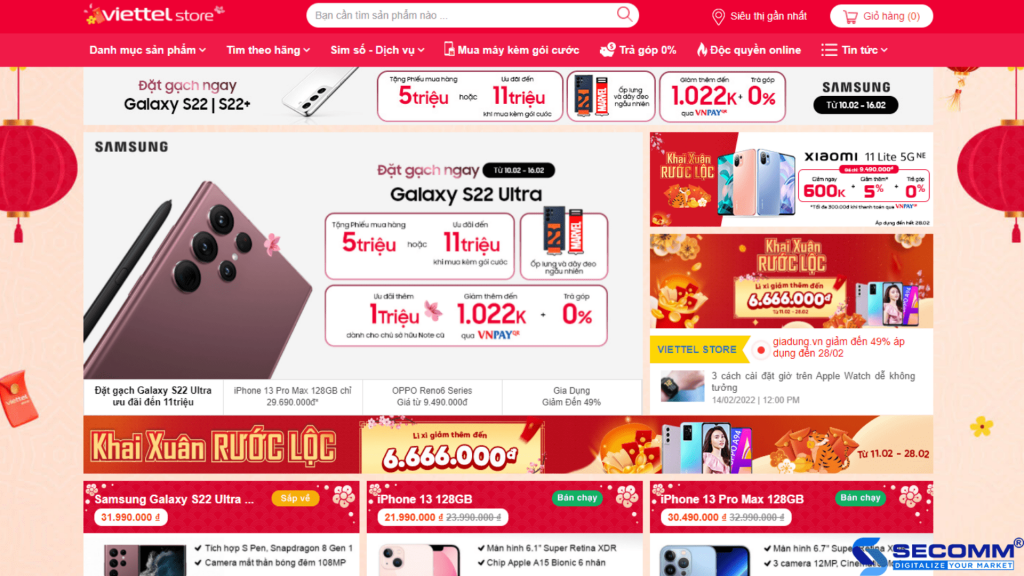
Sony is one of the most globally renowned brands in consumer electronics, thanks to its revolutionary innovations and product quality. After 21 years in Vietnam, Sony has established a retail system consisting of 11 Sony Shops and Sony Centers, over 160 official dealers, and 70 authorized service stations spread across the country.
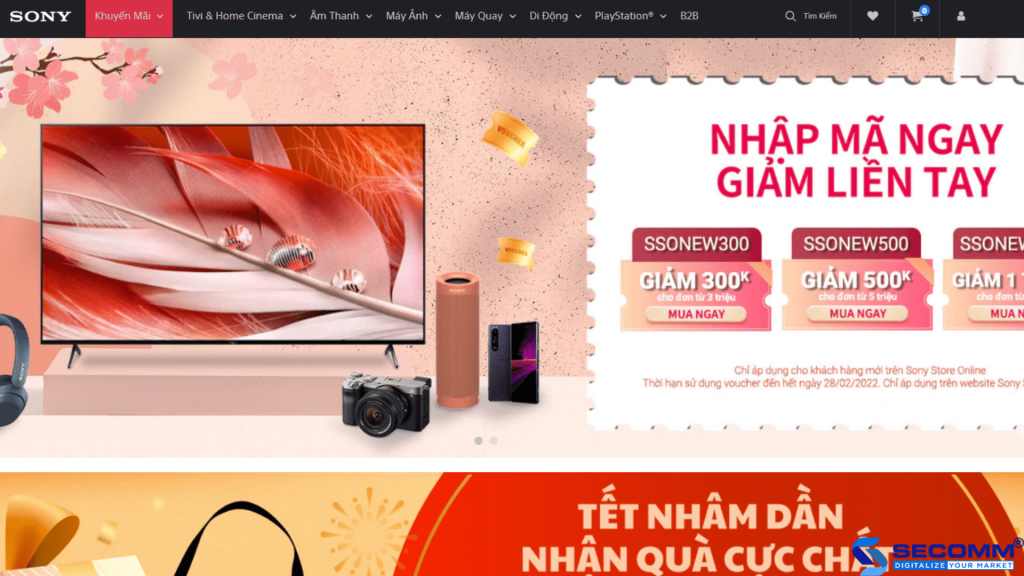
Phong Vũ is known as a long-established and reputable retail unit in Vietnam since 2007, with over 30 stores nationwide. Specializing in the business of information technology products, gaming and entertainment devices, office equipment, and high-tech devices from various major brands.

Mobile City is one of the popular retailers of smartphones, tablets, and technology accessories in Vietnam, with over 10 years of experience.
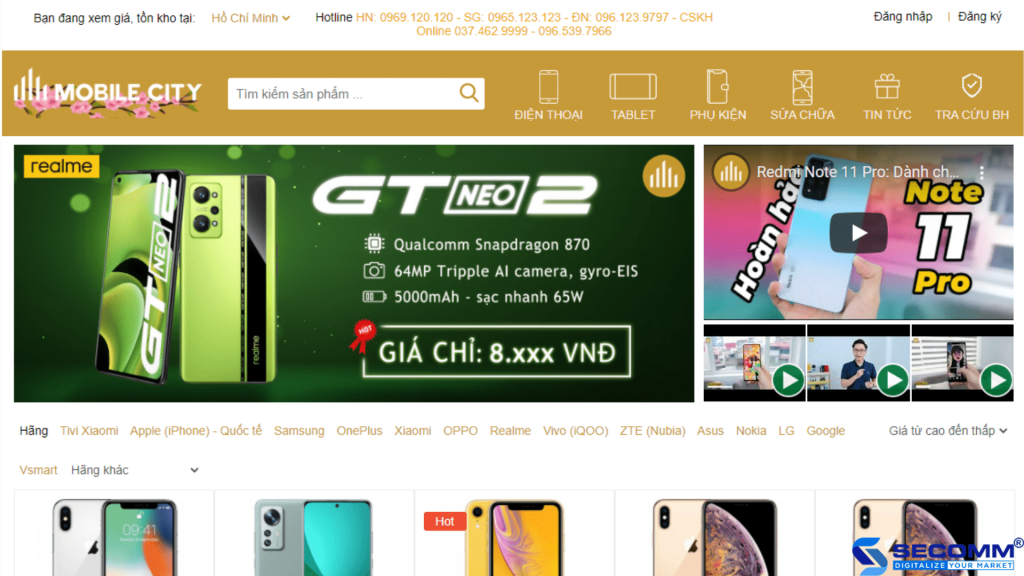
Clickbuy is a retail system offering well-known technology products in Vietnam, established in 2012. Currently, Clickbuy has expanded to include 5 stores and 2 modern service centers in Hanoi and Ho Chi Minh City.
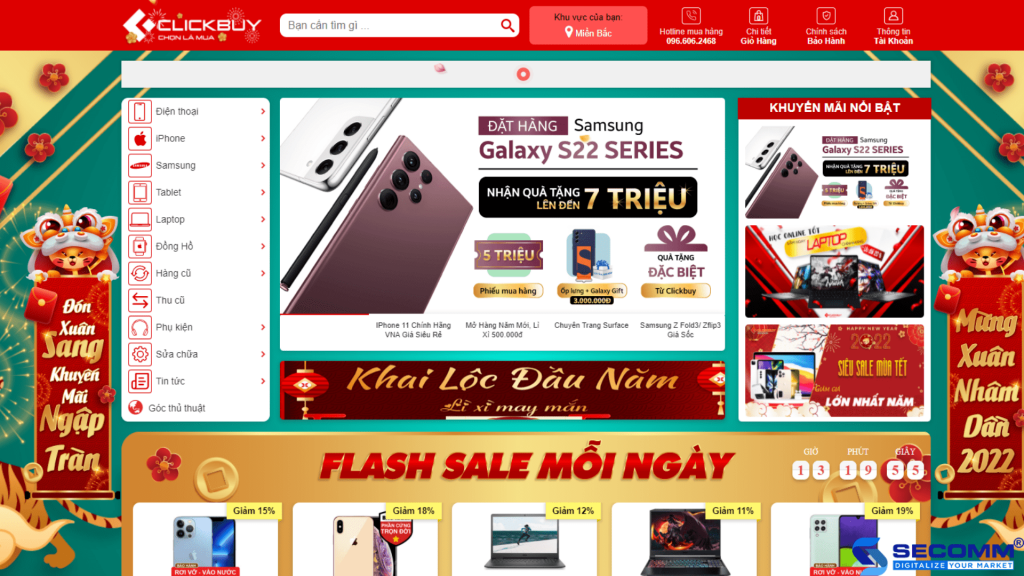
Online business in the mobile phone industry presents numerous growth opportunities. However, to succeed, businesses need a partner with extensive experience in the e-commerce landscape.
With a successful track record in implementing complex e-commerce systems, SECOMM understands the challenges that businesses face.
Contact us now for a free consultation on comprehensive e-commerce system development solutions!
 45
45
 40,648
40,648
 0
0
 13
13
Many businesses have promoted winery eCommerce in the context of the Covid-19 pandemic, which has been described as a “nightmare” for many economic sectors but appears to be “luck” for eCommerce.
According to Rabobank, eCommerce sales in the wine industry will reach USD 6 billion in 2021, up 4% from the same period in 2020. As said by Forbes, the percentage of online wine orders increased significantly compared to previous years before the pandemic.
Recognizing the potential of this field, many wineries in Vietnam have begun to develop eCommerce websites in order to quickly establish a market position.
Nam An Market is a retail chain of healthy food stores that Nam An International Investment Co., Ltd. invested in in 2012. Its eCommerce website, which receives over 100,000 visits per month, was built successfully on the Haravan platform.
Aside from fruits, vegetables, meat, and fish, alcoholic beverages, particularly wines, are popular on Nam An’s website. Furthermore, the online shopping experience focuses on safety, convenience, speed, reasonable prices, and various appealing incentives.
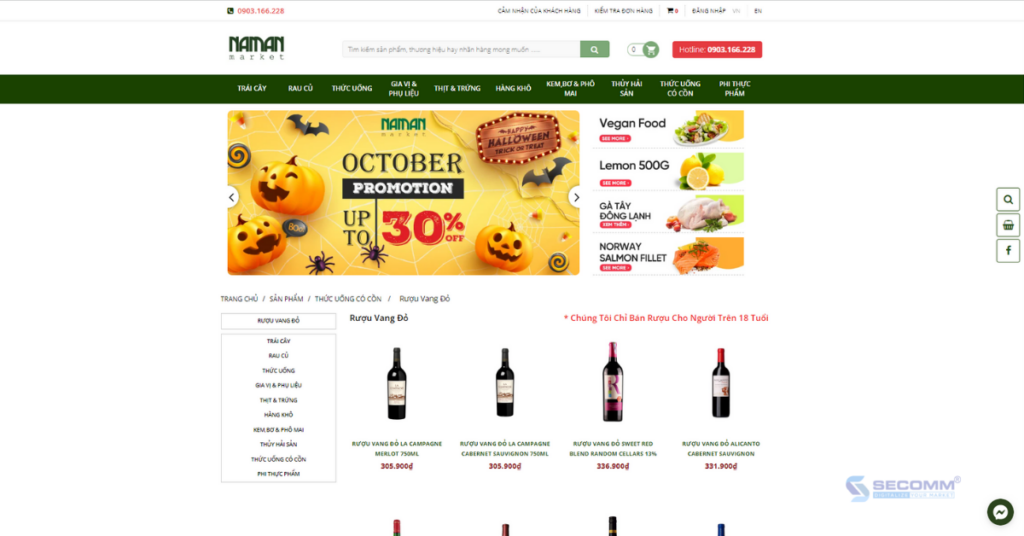
Winemart was founded in 2015 to provide consumers with the best services and products possible. Currently, Winemart operates in two main areas:
Winemart’s eCommerce website receives over 60,000 visits and is regarded as one of Vietnam’s most prestigious online wine suppliers.
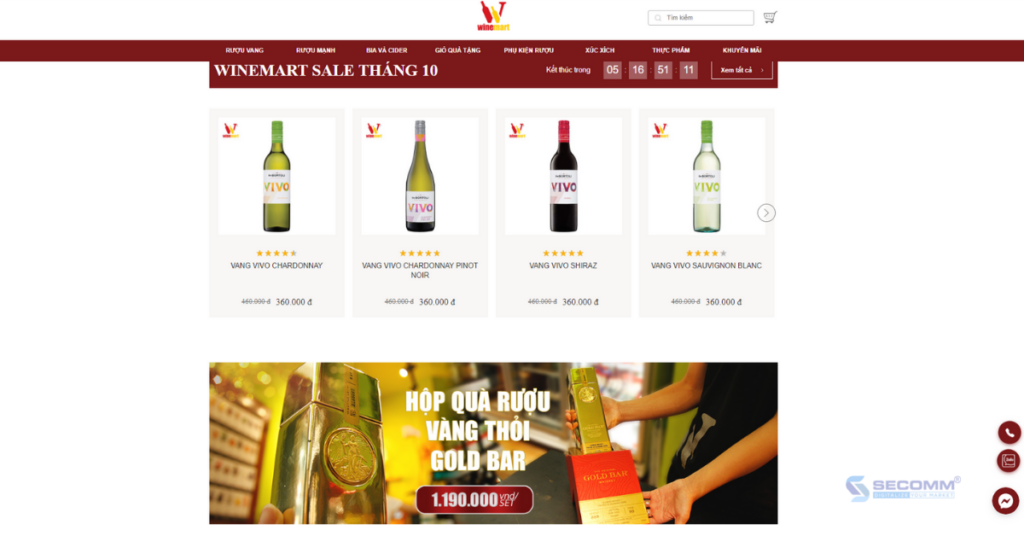
Sieu Thi Ruou Ngoai is not only an eCommerce website that sells imported foreign wine but also a knowledge system about culture, history, and how to choose, preserve, and enjoy wines from around the world, allowing people who are passionate about or want to learn about wine culture to share and improve their understanding.
Sieu Thi Ruou Ngoai now has its own eCommerce website system, which receives over 50,000 visits per month and is highly regarded by customers for both product quality and online shopping experience.
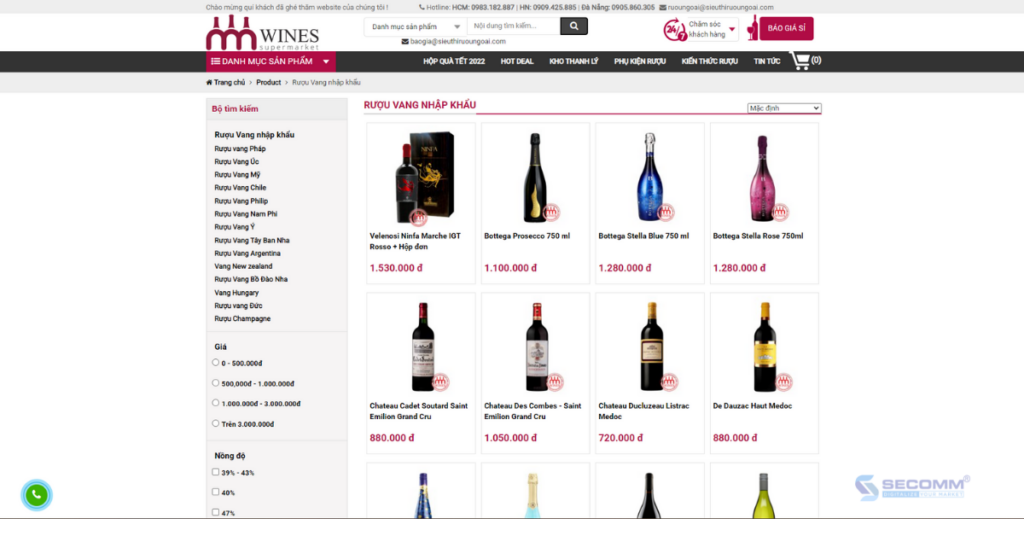
Cao Minh was founded and developed by CEO Thanh Dung, a wine enthusiast who is passionate about learning about wine culture. After many years of research, learning, and improving service quality, Cao Minh has fully converged all the factors to become Vietnam’s leading wine supplier.
Cao Minh’s website is written in PHP and includes all the necessary features and an easy-to-use interface. Cao Minh Wine has become a household name among customers who prioritize online wine shopping.
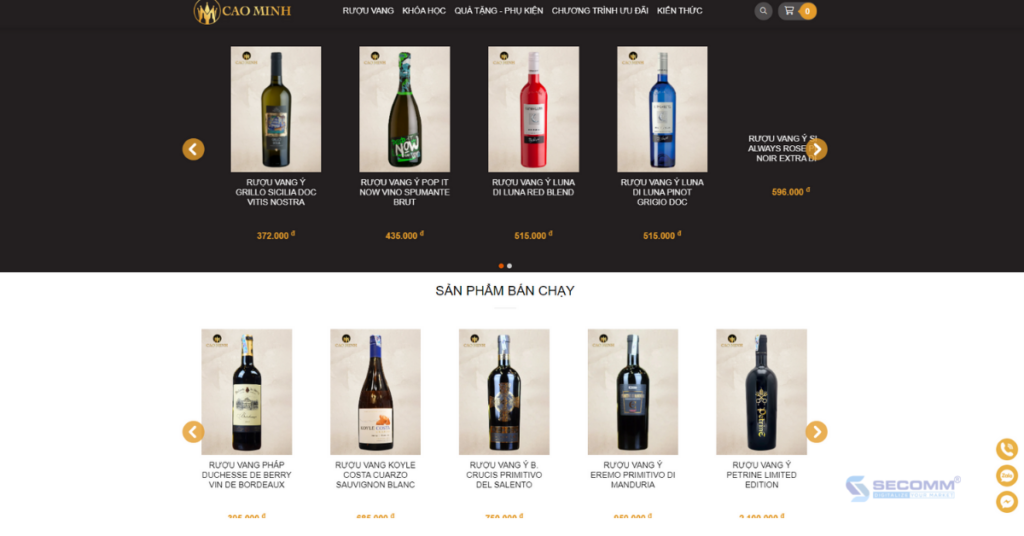
Kho Ruou, also known as Kho Ruou Co., Ltd., is Vietnam’s leading importer and distributor of foreign wines and spirits, with over 3000 products of wine, spirits, beer, Japanese sake, and genuine high-end accessories.
Kho Ruou pursues an eCommerce business model by investing in developing a website using the WooCommerce platform. As a result, the company can easily reach a large number of potential customers both online and offline.
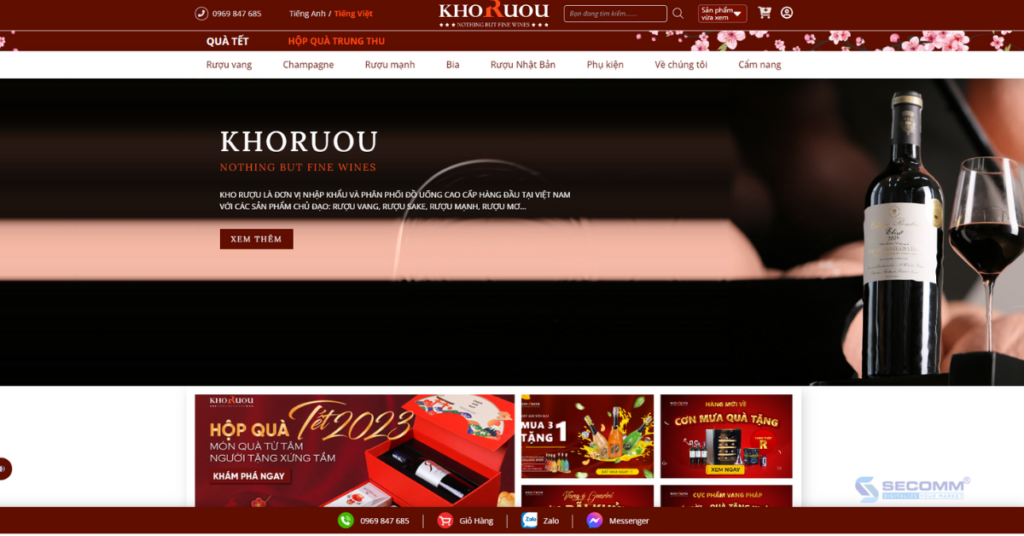
When eCommerce is a new trend widely praised by the Covid-19 pandemic. To keep up with that trend, Wine Tot built an eCommerce website with WooCommerce, which helped to increase brand coverage and reach a large number of potential customers on the Internet.
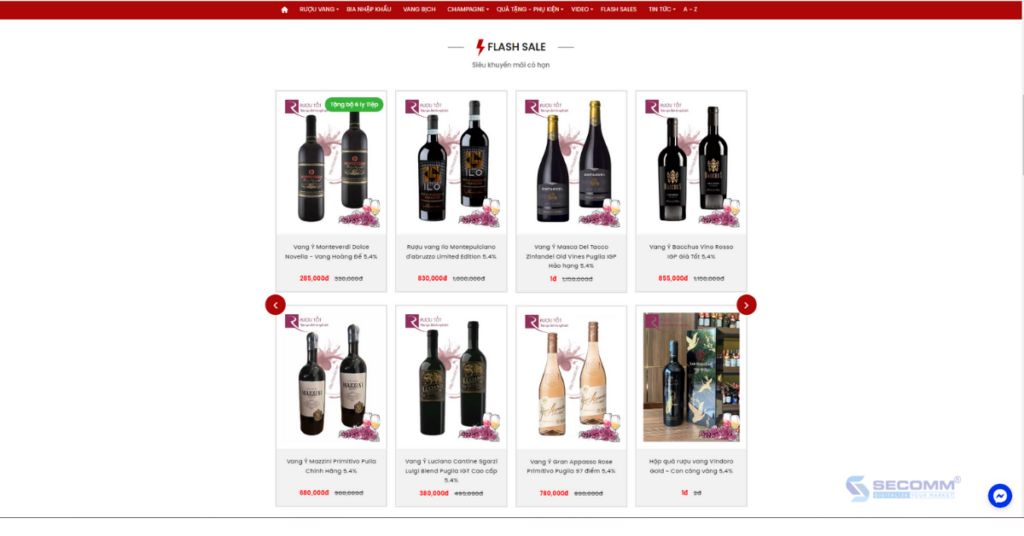
Ruou Nhap Khau is a wine eCommerce website operated by Ham Ruou Vietnam Co., Ltd, one of Vietnam’s leading import and distribution businesses.
Ruou Nhap Khau creates an e-commerce website with the PHP programming language. With an easy-to-use interface and good product quality and service, the company has gradually gained customer trust for its imported wine product lines ranging from popular to high-end.
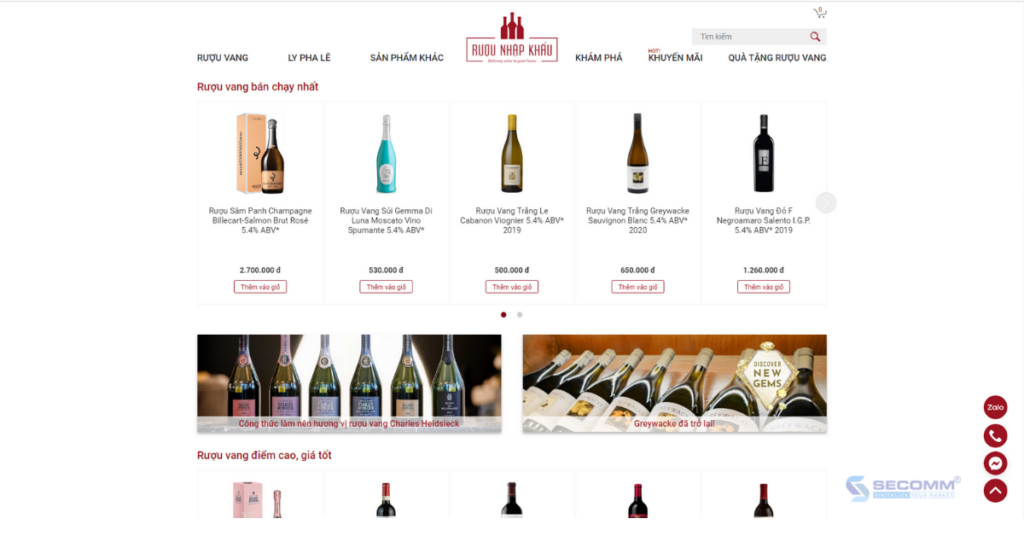
Sanh Vang is a wine distribution brand founded in 2015 by Saigon Hoang Kim Investment and Trading Company Limited. Sanh Vang has expanded its branch network to many provinces, including Ha Noi, Ho Chi Minh City, Bien Hoa (Dong Nai), and Buon Ma Thuot.
Furthermore, Sanh Vang’s eCommerce website receives over 25,000 visits per month, and the brand receives many positive reviews from customers due to its wine quality, competitive price, available stock, and variety.
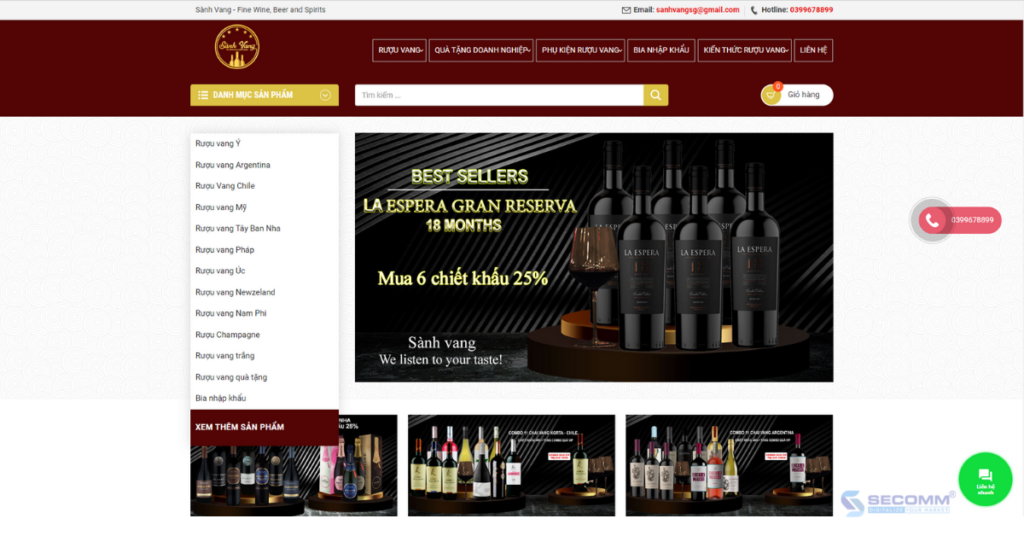
Winecellar, founded in 2007, is one of Vietnam’s largest wine companies, specializing in high-quality wine, beer, whiskey, food, mineral water, tea, and ceramic products. Winecellar, like Kho Ruou and Sanh Vang, uses the WooCommerce platform to implement eCommerce.

The Warehouse is a wine and spirits distributor in the Vietnamese market, as well as one of An Nam Group’s retail brands.
With a long-term and sustainable eCommerce business in mind, this brand has decided to invest in developing its own eCommerce website on the open-source Magento platform and continuously upgrading this system to provide a better eCommerce experience for customers.
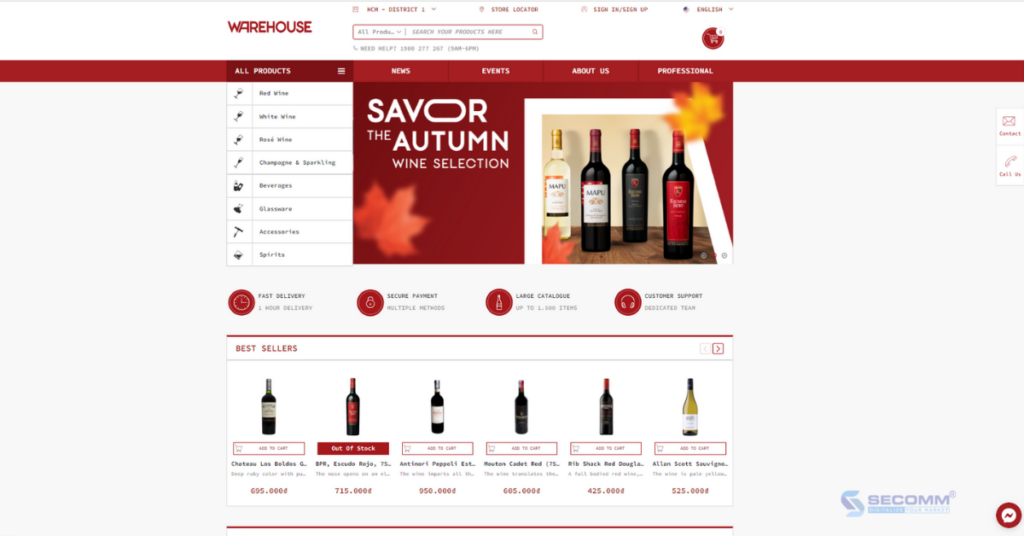
In general, Vietnamese wine brands are reaping numerous market successes after successfully developing their own eCommerce websites. However, the wine eCommerce business necessitates careful consideration of tactics to take the most effective steps not only in the short term but also in the long term.
Furthermore, wineries need to find a support unit or build a highly qualified in-house team to help them to achieve a common goal.
With many years of experience implementing eCommerce in many countries, SECOMM provides free consulting services with professional eCommerce solutions.
Contact us today for free support and advice!
 2
2
 5,134
5,134
 0
0
 1
1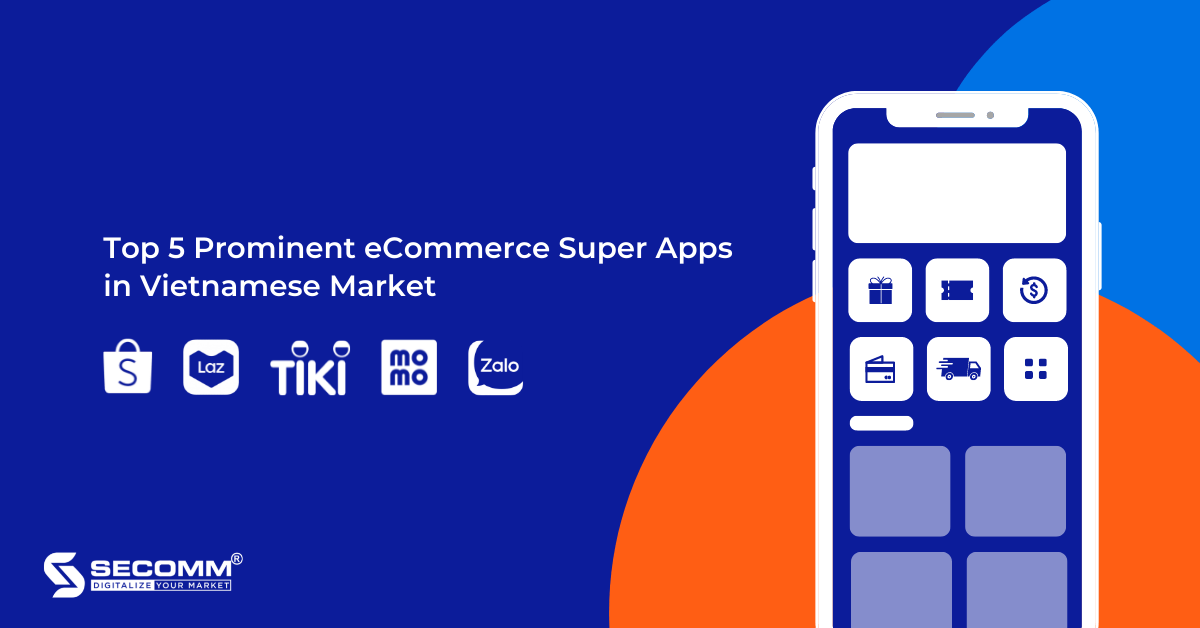
According to the latest of Ministry of Industry and Trade of the Socialist Republic of Vietnam in 2022, the eCommerce industry’s revenue is estimated at 13.7 billion USD, increase 16% compared to 2020 and accounting for 6.5% of the total retail revenue of Vietnam. Due to e-Commerce SEA, Vietnam’s eCommerce will grow by an average of 25% per year from 2022 – 2025, possibly reaching 35 billion USD in 2025.
The impact of the Covid-19 epidemic and social distancing orders, as well as changes in consumer behaviour, are driving the growth of this industry.
Thanks to super apps, such as Shopee, Lazada, Tiki, MoMo, and Zalo, it’s easier to deploy mini apps, creating a premise for inexperienced brands to build eCommerce systems to enter this billion-dollar market.
Shopee is the most popular eCommerce market in Southeast Asia and Taiwan. Shopee was founded in 2015 to provide people with an easy, safe, and quick online buying experience.
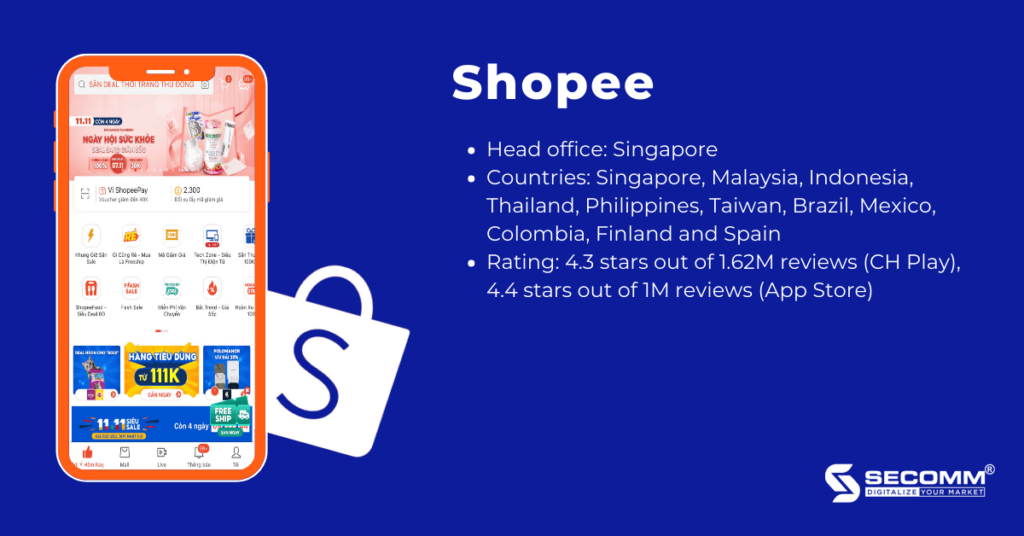
Shopee is gradually becoming an eCommerce super app, not only offering online shopping services but also owning various mini-apps such as Shopee Food, Shopee Mart, Shopee Wallet, insurance services from banks, booking flights, hotels and so on.
Lazada, founded in 2012, is one of Southeast Asia’s biggest eCommerce marketplaces. This brand has always been a pioneer in fostering regional development via commerce and technology, intending to service 300 million consumers across Southeast Asia by 2030.
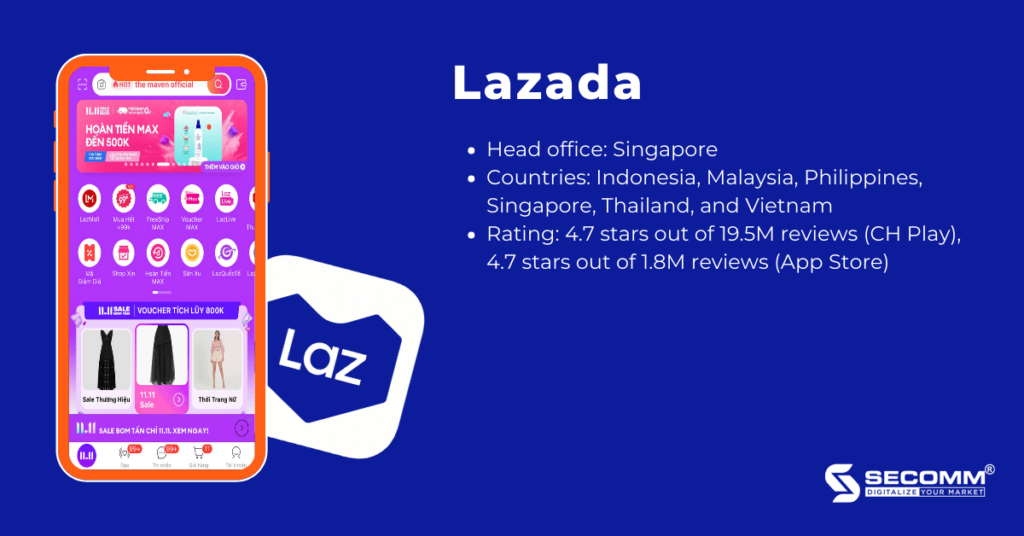
Like Shopee, Lazada has many mini apps and utilities for its own e-commerce business strategies, such as eM wallet, card and eVoucher recharge, online shopping, etc.
Tiki is one of Vietnam’s most successful eCommerce marketplaces. Tiki was founded in March 2010 as an online English book-selling site. Since then, Tiki has evolved into an eCommerce super app, focusing on delivering hundreds of thousands of goods from a variety of product categories.
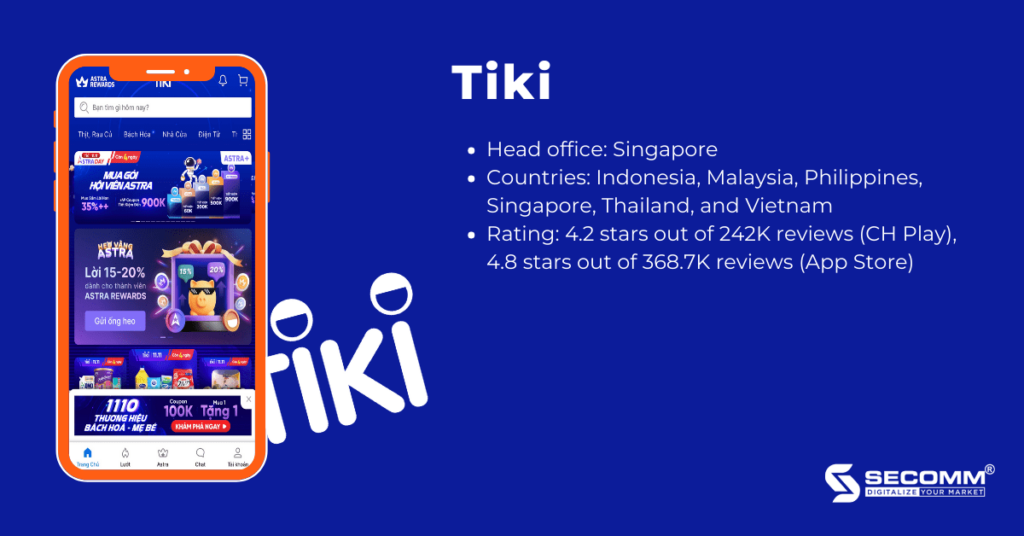
Tiki has been a pioneering marketplace in applying digital currency to business concepts, as proven by the launch of Astra, to boost up eCommerce. At the same time, Tiki refined its ecosystem by creating a series of extensions with mini apps from brands in various industries, including finance, gaming, food, shopping, health, insurance, entertainment, lifestyle, tourism, and community.
MoMo is an e-wallet created by Online Mobile Services Joint Stock Company (M Service) that allows users to make mobile payments and transactions. Through partnerships with more than 90% of Vietnam’s banks and 10,000 local businesses, the company dominates more than 80% of the market for digital payments. As of 2022, MoMo e-wallet has more than 31 million users.
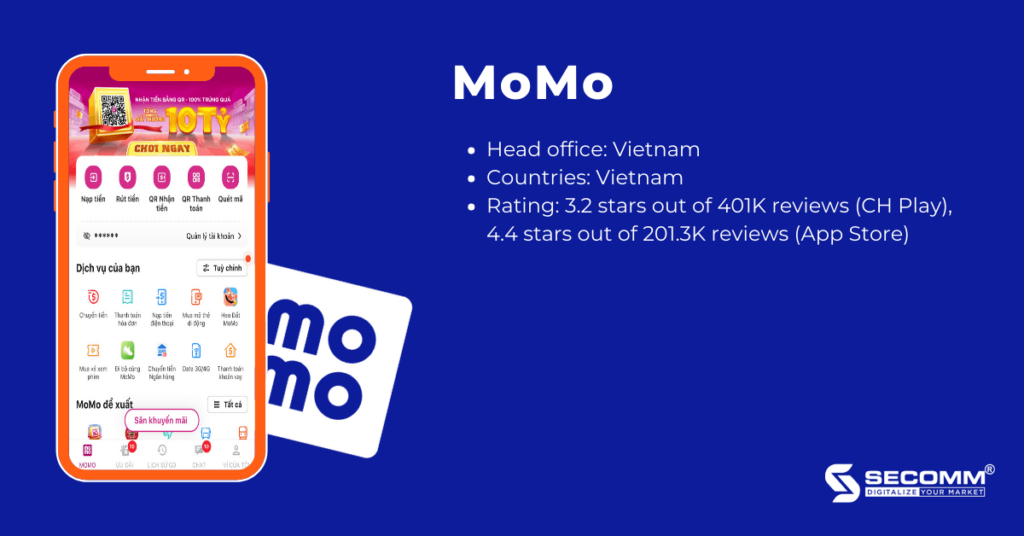
Since 2022, MoMo has developed a mini app technology, formally identifying itself as a super-payment app, helping small and medium companies to “climb on the shoulders of giants,” and construct an ecosystem for MoMo. In particular, utilities from businesses such as online shopping, restaurants, transportation services, tourism and hotels, investing and banking, medical services and so on.
Zalo was formally launched in December 2012, with the essence of a cross-platform instant messaging software built by the Vietnamese startup VNG. Zalo is a blend of Zing (a VNG-created social network) and alo (a phrase used to pick up a phone in Vietnam). Zalo has progressed to become a multi-functional, multi-platform social networking super app.
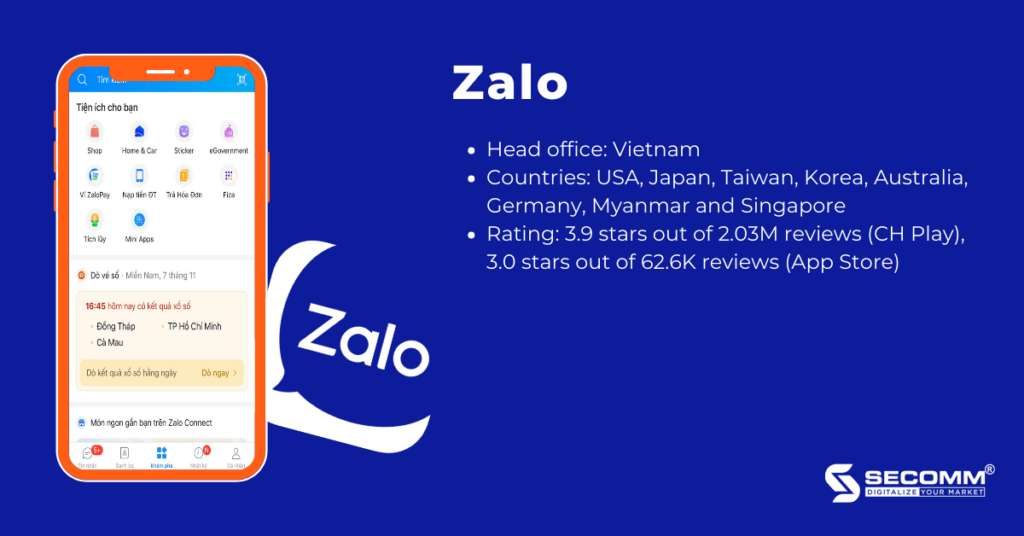
Like MoMo, Zalo created a new brand named Zalo Mini App to help other brands reach 65 million regular users on Zalo, and make diversity for this messaging platform. Since then, Zalo has also supported other services, primarily through partnerships with brands in finance, eCommerce, entertainment, games, restaurants and hotels.
As can be seen, the future of Vietnam’s eCommerce industry will continue to rely on these “giants,” thus businesses should incorporate eCommerce super apps into their business models as soon as possible to reap the full advantages of these applications. However, companies should not rely on these apps for long periods of time since it will result in a loss of customer data, income from commission per order, and so on.
With more than 8 years of experience in consulting and deploying eCommerce systems, SECOMM understands the challenges businesses face in implementing eCommerce business effectively.
So we provide a free eCommerce consultation to help businesses catch on to this industry!
 2
2
 7,977
7,977
 0
0
 1
1
Fashion eCommerce is growing increasingly influential, particularly in markets with a young population, such as Vietnam, where demand for fashion and lifestyle is diversified.
Recognising this, several fashion brands have begun developing their own eCommerce websites to join this lucrative business swiftly.
Coolmate is a men’s fashion business started in 2019. With a D2C eCommerce strategy as the centre for business development, after only 2 years of implementation, Coolmate had a successful capital call on Sharktank with Nguyen Hoa Binh for 500,000 USD. By 2021, Coolmate’s sales may reach VND 139 billion, an increase of 3.5 times compared to 2020, setting the 2022 revenue expectation at 440 billion.

Hai Trieu, which was founded in 1991, has over 30 years of expertise in the watch industry. To adapt to the changing industry and consumers, Hai Trieu has incorporated an eCommerce strategy into its business model with the objective of becoming a dominant watch retailer in Vietnam. Hai Trieu’s eCommerce website has received over 1 million monthly visits and is ranked among the top sites in the fashion eCommerce industry in Vietnam. (according to iPrice).
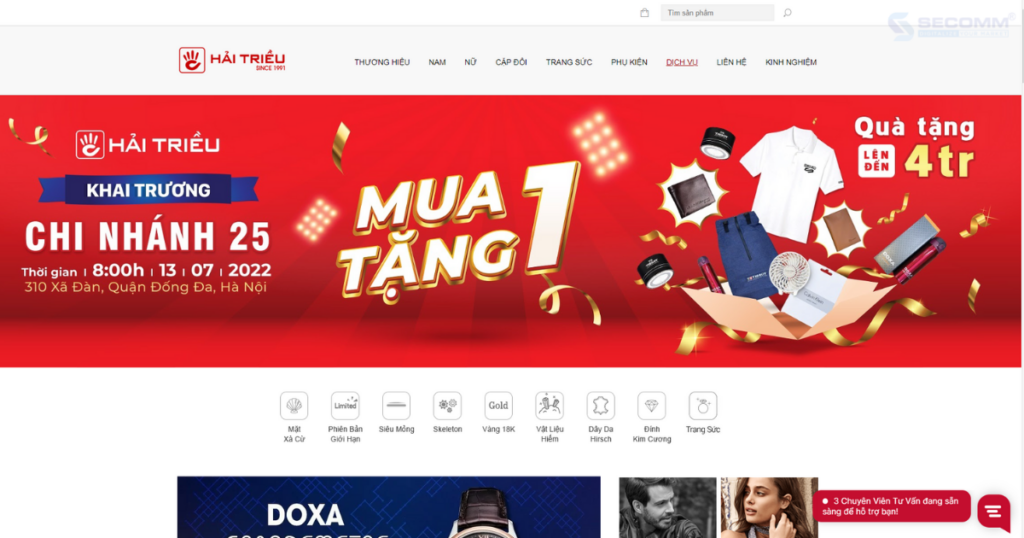
The official name of PNJ is Phu Nhuan Jewelry Joint Stock Company, which was founded in 1988. PNJ has spent a long time developing a fashion eCommerce website to apply the omnichannel sales strategy. Because of the early adoption of eCommerce, PNJ has surmounted the tumultuous year of 2021 with net sales of over VND 19,547 billion, an increase of 12% over 2020.
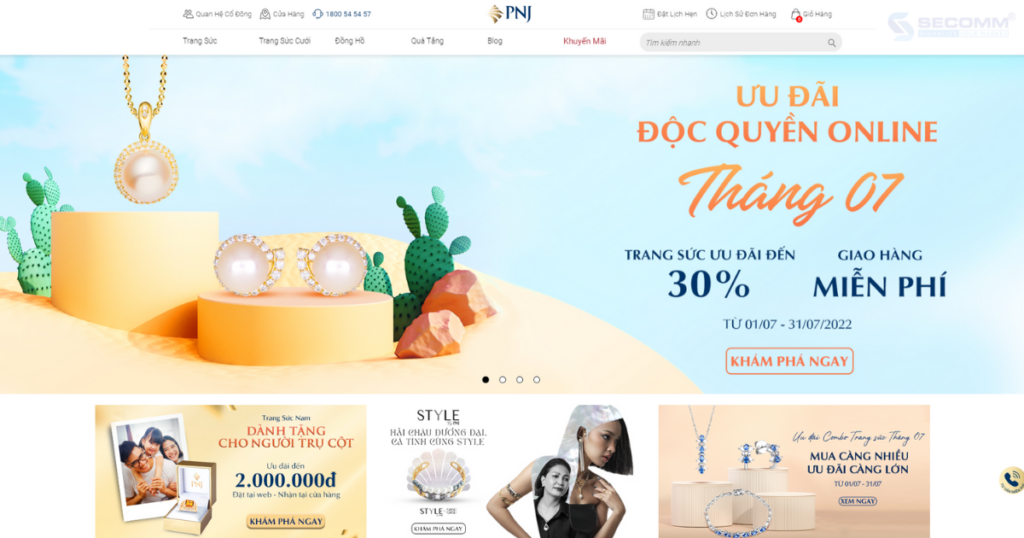
Founded in 2005, Juno is a brand known for its line of women’s fashion shoes and bags. Juno saw the enormous potential of the e-commerce sector and invested early in technologies to make the online company more efficient. As a result, the eCommerce website of Juno is currently the highest-visited website in the fashion line of shoes and bags in Vietnam.
Juno has usually cultivated the clothes and accessories area to suit its clients’ increasingly broad consumer demands.

Canifa is a family fashion brand established in 1997, under Hoang Duong Service and Trading Joint Stock Company – a large fashion retailer in Vietnam. Canifa has built an eCommerce business with a reputation achieved in traditional fashion since 2012. Because of its long-term and sustainable eCommerce business strategy, this company opted to invest in establishing its own eCommerce website on the open-source platform – Magento and regularly upgrading this system to provide clients with the better eCommerce experience possible.

Hoang Phuc International (Hoang Phuc) was established in 1989 as a luxury fashion retailer of Kappa, Ecko Unltd, Superga, Replay, and Staple. This brand has decided to enter the eCommerce industry after three decades of using traditional strategy. Hoang Phuc has utilised and changed numerous platforms to create the successful eCommerce website that it is now. This business is currently employing the Magento platform – an open-source platform specialised in eCommerce.
This firm utilizes KOL and Livestream strategies to boost market penetration, besides constantly improving its own eCommerce website for selling apparel online.
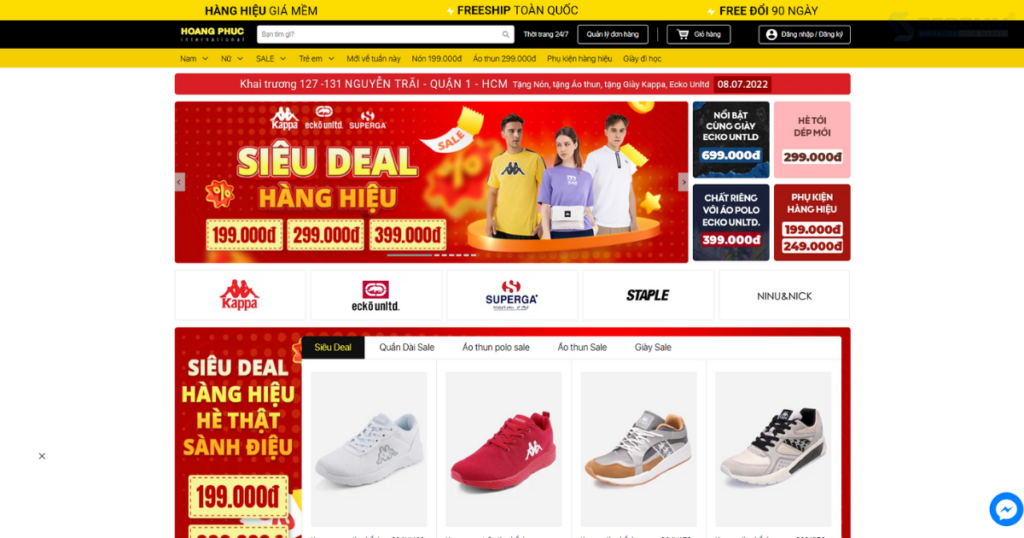
Bitis began as a small factory in 1982 and has grown to become the market’s top shoe and footwear brand. However, when user behaviour changes and new “players” enter the market, this business appears to fall behind. After a long period of lagging, Biti’s new CEO, Vuu Le Quyen – the eldest daughter of Mr. Vu Khai Thanh – chose to change strategy, focusing on investing in eCommerce business model to accelerate and catching up with the market.
Bitis’s has made a dramatic recovery due to this new strategy, vying directly with worldwide brands such as Nike, and Adidas in the Vietnamese market after a number of years of losing market share.
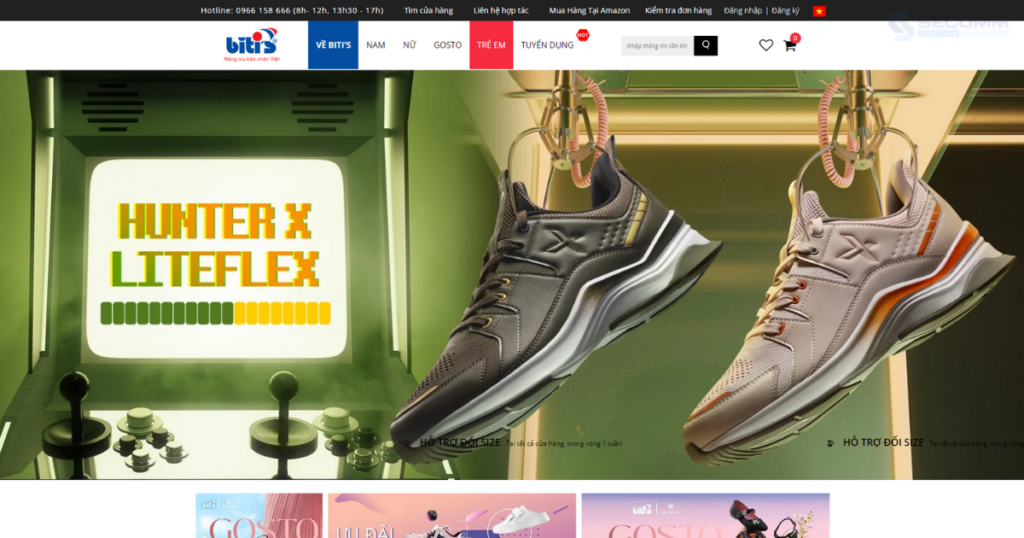
Orchard, which was founded in 2004, is a supplier of more than 200 luxury perfume brands from across the world. Orchard has implemented eCommerce promptly to tap the “gold mine” of this industry and become the No. 1 perfume retail brand in Vietnam. Orchard’s eCommerce website is now the favorite destination for customers who want to buy perfume online.
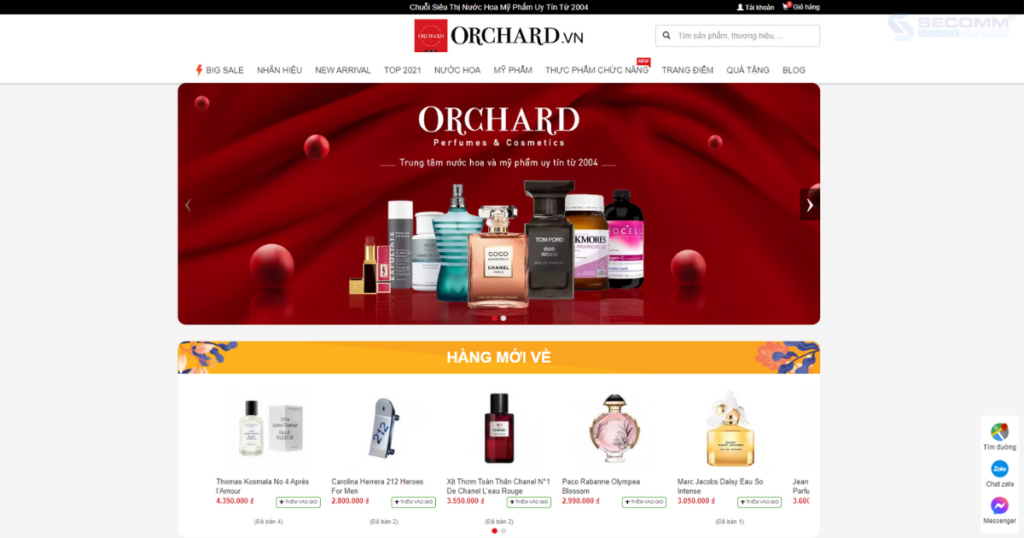
ONOFF was established in 2005 with the goal of providing daily comfort to everyone. ONOFF has advocated for adopting an eCommerce strategy by investing in building Magento websites like Canifa in 2016. As a result, the brand is gradually synchronizing on online and offline channels, with a customer loyalty rate of 80% maintained at all times, allowing ONOFF to more firmly believe in its goal of becoming the leading lingerie brand in Vietnam and a chance to conquering the ASEAN market in the next three years.

Rabity is a children’s fashion brand that was launched in 2000. Currently, Rabity is the sole Disney and Marvel partner with image rights for children’s fashion lines ranging from 0 to 14 years old. Rabity is pleased to have been the pioneer in deploying the first eCommerce for children’s fashion in Vietnam. Rabity is now present on all eCommerce channels and has its own eCommerce website.
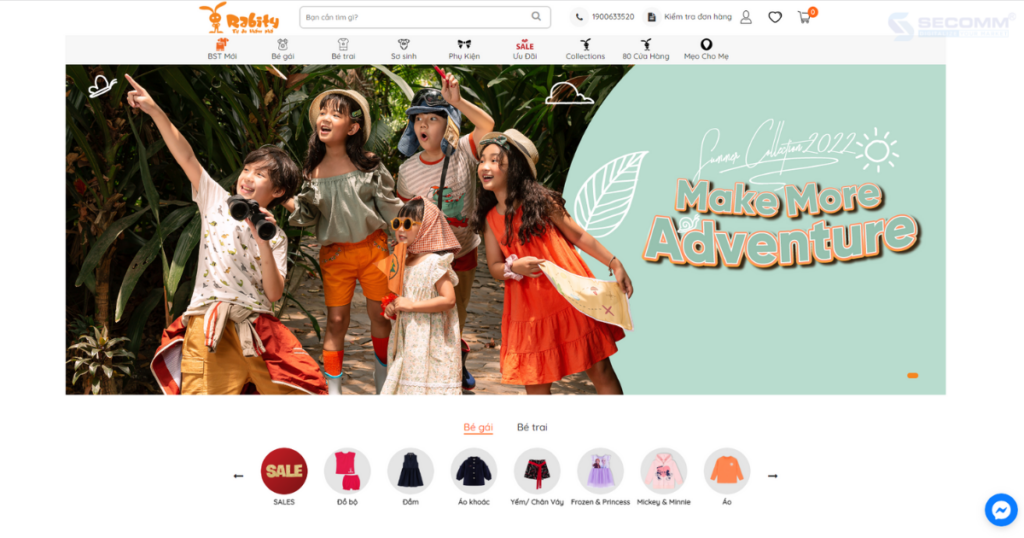
Overall, fashion businesses are achieving several successes after developing their own eCommerce websites. However, the fashion eCommerce industry needs careful consideration of tactics to take the most successful actions in the short term and in the long run. Of course, to do that challenging task, fashion companies must find a well-known or build skilled IT team.
 2
2
 9,006
9,006
 0
0
 1
1
eCommerce has become an essential business model that fashion brands must utilize not only to survive during the COVID-19 pandemic but also to assist companies in adapting to changing customer behavior, providing competitive advantages for future breakthroughs.
As a result, fashion eCommerce has become a crucial business trend for many fashion businesses today, from start-ups to “giant” corporations.

According to Statista, the compound annual growth rate (CAGR) of the fashion eCommerce market is predicted to be 14.2% from 2017 to 2025. The CAGR is forecast to reach a value of USD 1 trillion by 2025, in which the US market accounts for about 20%, equivalent to 204.9 billion USD.
In the Vietnamese market, fashion eCommerce is the second most important sector, just after eGrocery (The Vietnam eCommerce White Paper in 2021).
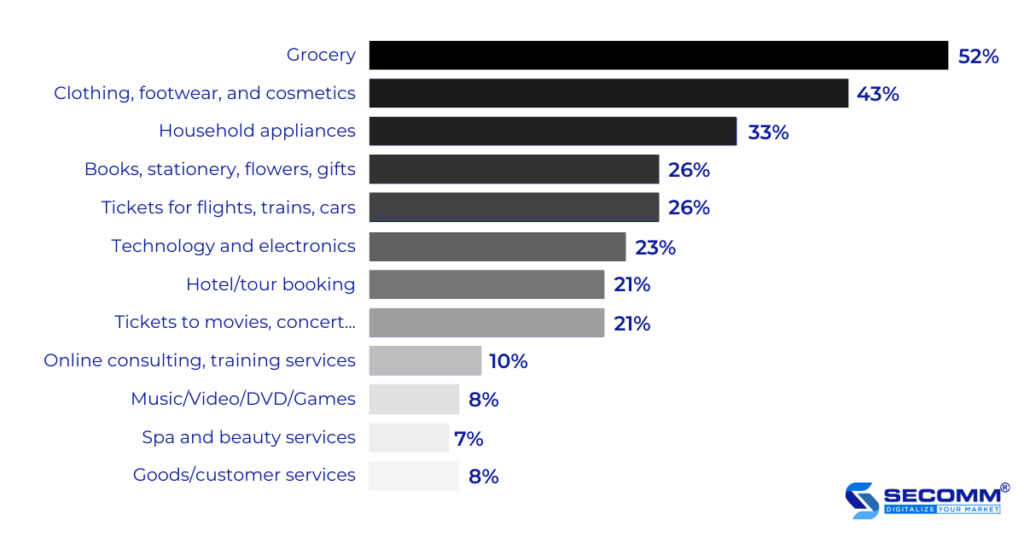
The use of eCommerce will provide fashion firms with a new sales channel, along with offline commercial activity in showrooms. For geographical factors, eCommerce transcends place and time to allow customers to purchase whenever and wherever they choose.

Simultaneously, eCommerce is a prominent avenue for reaching customers, particularly in the sphere of fast fashion for women. Marketing activities such as Livestream, Shoppertainment (Shopping with entertainment), Affiliate, and so on are more effectively carried out, leading to the extension of the commercial scope for enterprises.
Following the COVID-19 epidemic and the social distancing order, consumer behavior has shifted dramatically, with the transition from physical to online buying rising over time in all categories. In the fashion business alone, the percentage of online customers climbed from 18% to 48% in 2020–2021. As a result, it is critical for fashion businesses to implement eCommerce.
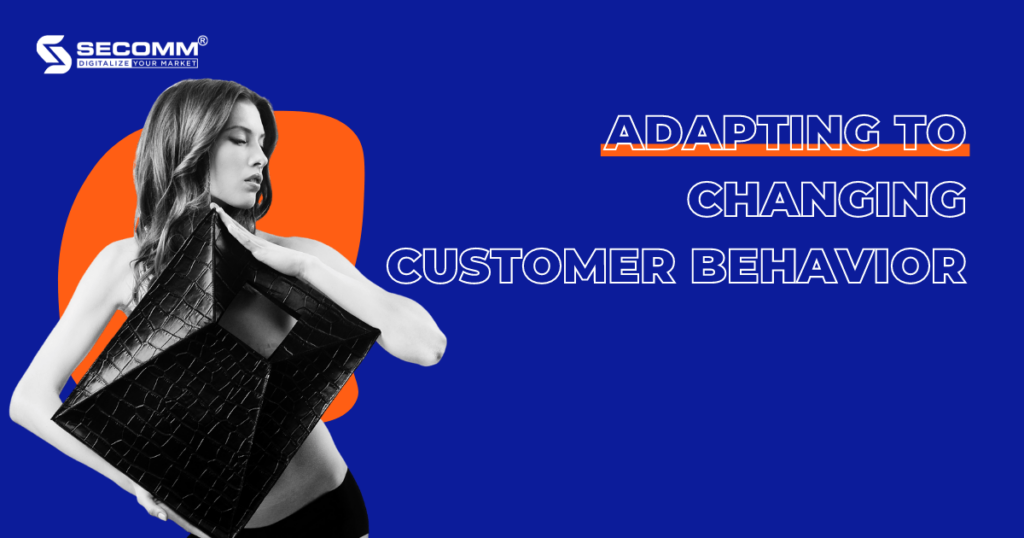
After the epidemic, consumer behavior altered drastically, such as waiting until D-Day to purchase items. Furthermore, by utilizing eCommerce technologies, organizations can follow, analyze, and synthesize the consumption behavior of each target group, something offline purchasing cannot accomplish. This ensures that businesses always have enough aggregated and forecasted data to implement business plans.
When technologies that improve user experience in e-commerce are used, customer purchases will be made faster.
Visual experiences such as photos, movies, virtual reality experiences, and so on provide customers with full product information and expertise, enabling a speedier purchasing process. VR / AR technology enables people to shop for garments, accessories, and shoes online in the same way they would in a store.
For example, the American Apparel company has used AR to show shoppers more product information, like detailed descriptions, availability, colors, and buyer reviews.

eCommerce allows businesses to tailor the experience for consumers by collecting, evaluating easily, and summarizing the consumption habits of each target group, often with the following features: Recommend products, Products seen, and so on.
eCommerce provides a seamless experience for customers across many channels such as social media (Facebook, Instagram, Tiktok, Zalo, etc), eCommerce marketplace (Shopee, Lazada, Tiki, Sendo, etc), eCommerce website, and mobile app.
Shein is a Chinese eCommerce site created in 2008 that specializes in apparel and accessories. With the motto “everyone can enjoy the beauty of fashion,” the company pushes to give consumers a diverse selection of product options. Shein is currently regarded as a fashion “empire” with a valuation of $ 100 billion – more than Zara ($ 69 billion) and H&M (23 billion) combined.

Shein focuses on the youthful client sector of Gen Y and Gen Z, who use the Internet often. As a result, this brand has used technical components to reach more consumers in an appropriate and exact manner.
Shein created an eCommerce system that included a website and a mobile app to target overseas markets such as Europe, America, Australia, and the Middle East. Shein then advocated Social Commerce, Ecommerce Marketing, Affiliate Marketing, KOC, and other tactics to improve brand awareness and engagement.
In 2021, Shein’s mobile app exceeded 7 million monthly active users in the US alone (Airnow Data), and the hashtag #Shein garnered more than 10 billion views on TikTok (Jing Daily). Revenue reached $15.7 billion in 2021, up 60% from 2020 ($9.8 billion). It can be seen that Shein is a clear example of the effective application of eCommerce to capture market share in the fashion industry.
Coolmate is a menswear startup that was established in 2019. Coolmate is a mix of the words “cool” and “mate,” which means that the brand’s major purpose is to be a fashion buddy for customers. After barely two years of operation, this company received a $500,000 funding call from Sharktank Vietnam.
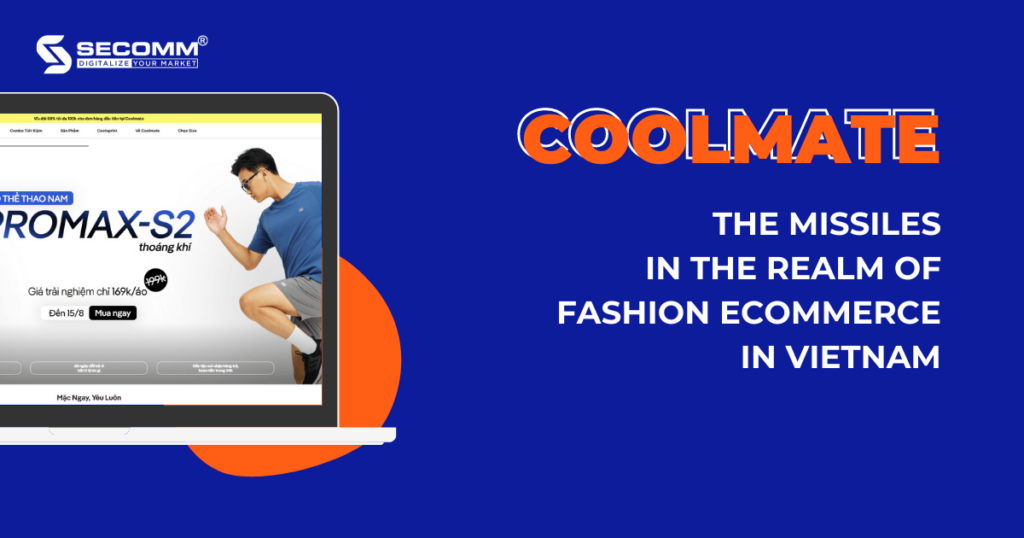
Coolmate utilizes the Direct to Customer Ecommerce (D2C eCommerce) model and concentrates on developing its own fashion website to provide a quick and cost-effective buying experience. At the same time, this brand prioritizes product quality, which is 100% made in Vietnam and meets export standards at low costs. Furthermore, to implement e-commerce faster, Coolmate advocates thoroughly apply the strategy of Ecommerce Marketing, Affiliate Marketing, Email Marketing, etc.
Aside from the $500,000 agreement for a 12.5% interest, 2.5% of the consultancy shares pledged, this fledgling business has other noteworthy statistics. Coolmate’s sales will reach VND 139 billion in 2021, up 3.5 times from 2020, with revenue expected to reach VND 440 billion in 2022 and an IPO (Initial Public Offering) by 2025. In general, eCommerce has considerably contributed to Coolmate’s development, as well as providing the groundwork for fashion businesses to follow to grow by market trends.
Yody (previously Hi5) is a family apparel label that was founded in 2014. To provide Vietnamese fashion goods made of high-quality materials to customers in various regions of Vietnam and throughout the world. Yody now employs over 700 people and has 90 outlets around Vietnam.
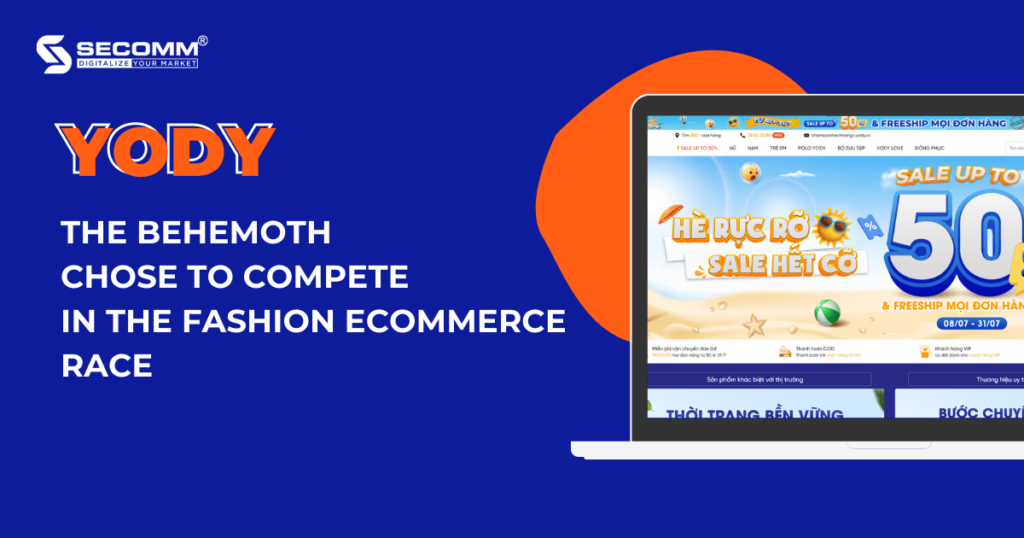
This fashion brand prioritizes the “tripod” of human resource development, product quality, and technology investment. Yody focuses on talent recruiting and culture training to engage employees in human resource development. In terms of products, Yody designs for comfort and convenience, and can be utilized in various situations, such as going to work, going out, attending meetings, and so on.
Regarding technology, Yody focuses on implementing an online sales strategy across Omni-channel such as eCommerce marketplaces, an eCommerce website, Facebook, Livestream, and so on to compete in the eCommerce race, as well as adapting to changing consumer behavior.
In 2016, Yody was selected as one of the ten outstanding young start-ups in Vietnam. By 2021, Yody’s physical sales will have dropped by 65%, but the internet segment has increased by more than 10%. Therefore, the company continues to aim to increase online revenue by 20% in the next year.
In a nutshell, how to apply fashion e-commerce will depend on the size and strategy of each company, but eCommerce is a prerequisite for successful business in this industry.
 2
2
 6,836
6,836
 1
1
 1
1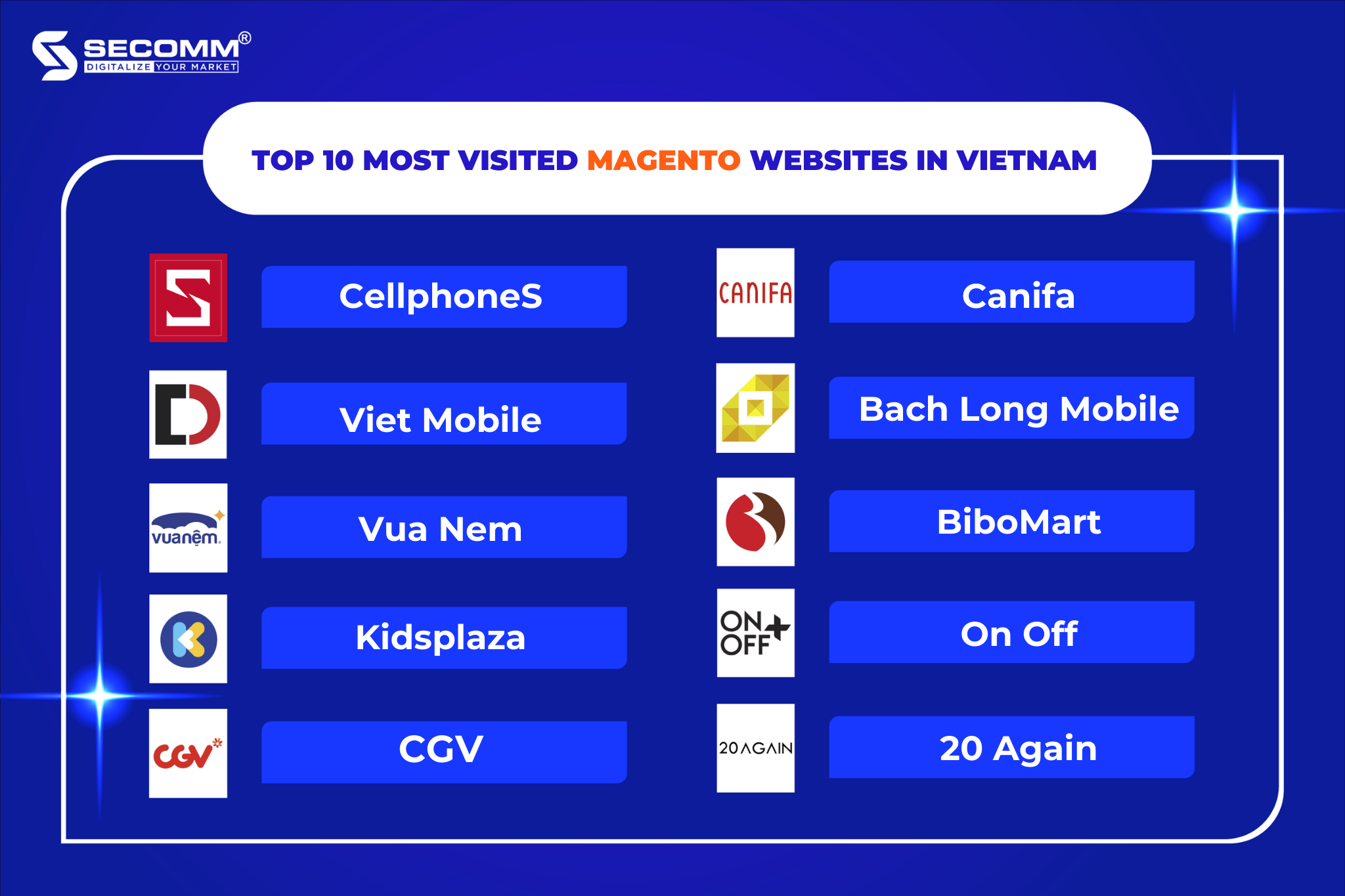
Magento is the leading open source eCommerce platform, powering over 186,000 websites worldwide. However, this platform has not been widely used in Vietnam, particularly among the community of new businesses entering the eCommerce market.
Magento is an open-source eCommerce platform written in the PHP programming language. Magento currently has two versions: Magento Open Source (free) and Magento Commerce (paid).
Inheriting outstanding advantages of open source eCommerce platform:
In Vietnam, CellphoneS is a well-known retail system for technological products. The company is currently operating in Ho Chi Minh City, Hanoi, Binh Duong, Hai Duong, Hai Phong, Bac Ninh, Vinh Phuc, Thai Nguyen, and Vung Tau.
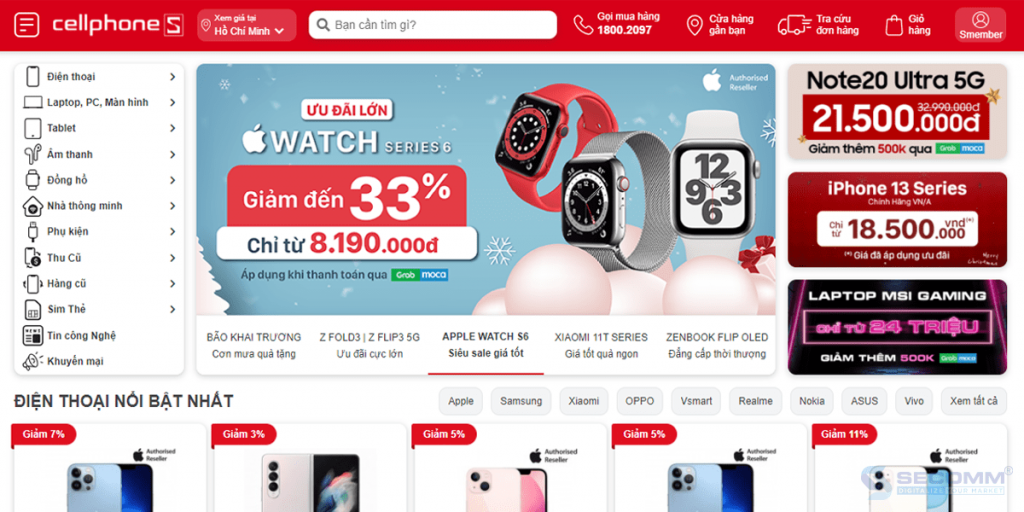
Viet Mobile is a reputable electronics brand and a strategic partner of global technology corporations such as Apple, Samsung, Apple, OPPO, Sony, ASUS, and others.

Vua Nem is a leading retail chain of mattresses, blankets, sheets, pillows and accessories with more than 100 stores spanning from North to South.

Kidsplaza is a big star in the mother and baby industry, with over 133 locations nationwide.\

CGV, along with Galaxy, Lotte Cinema, BHD Star Cineplex, and CineStar, is one of the top five largest cinema clusters in the world and a major distributor and cinema cluster in Vietnam.
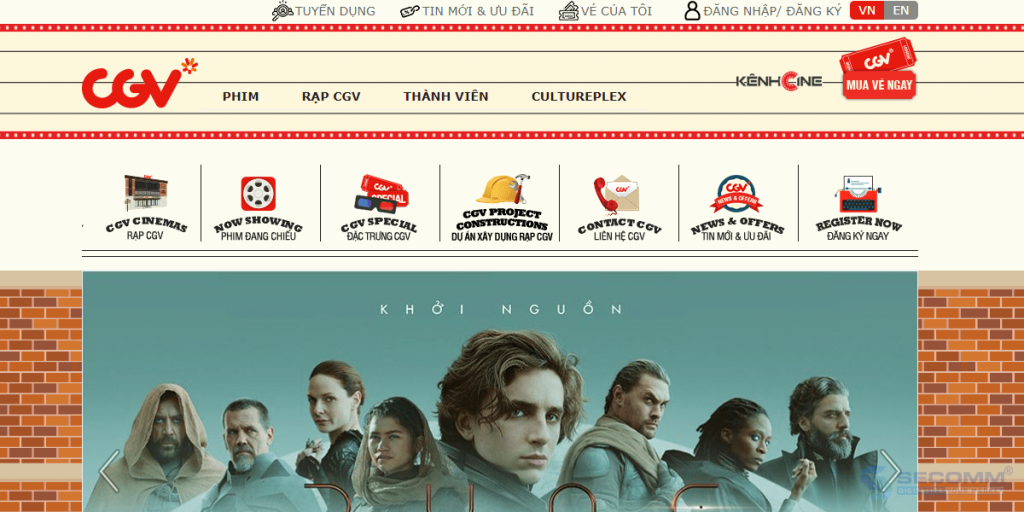
CANIFA is a fashion brand that specializes in designing clothes, accessories, and retailing casual wear for families. It is currently owned by the Hoang Duong Textile Group.
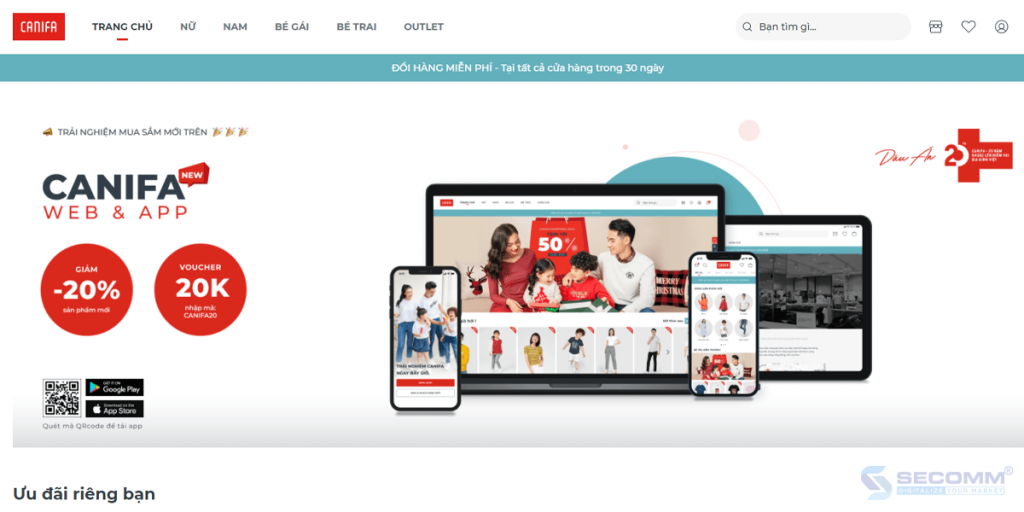
Bach Long is one of the popular retailers of smartphones, tablets, and technology accessories in Vietnam.

Bibo Mart is a Vietnamese supermarket chain that sells and services to mothers and babies. Bibomart used eCommerce in 2019 to reach customers and expand its online business.
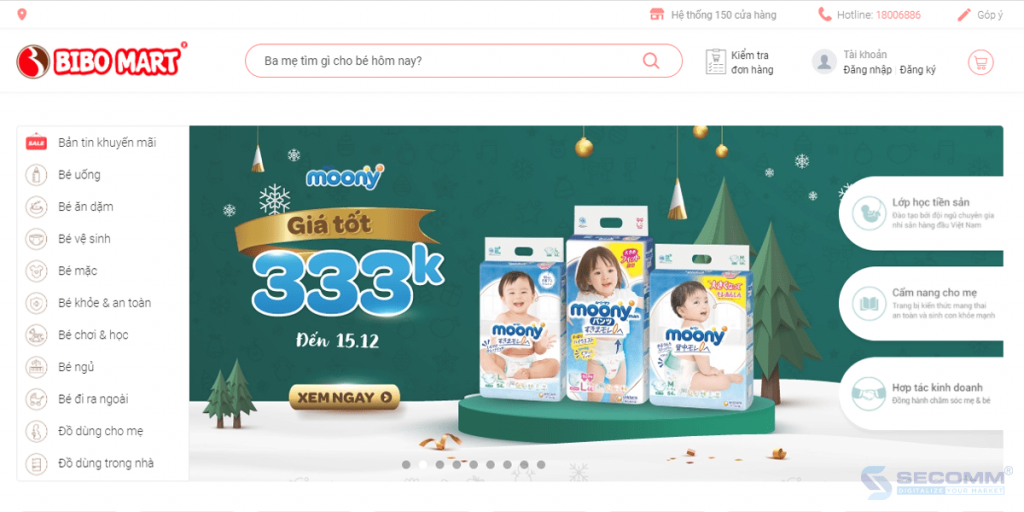
On Off is a lingerie brand founded in 2005 to bring everyone comfort every day.

20 Again is a women’s fashion brand with 3 main product lines: Office Wear, Dress Design, and Street Wear.
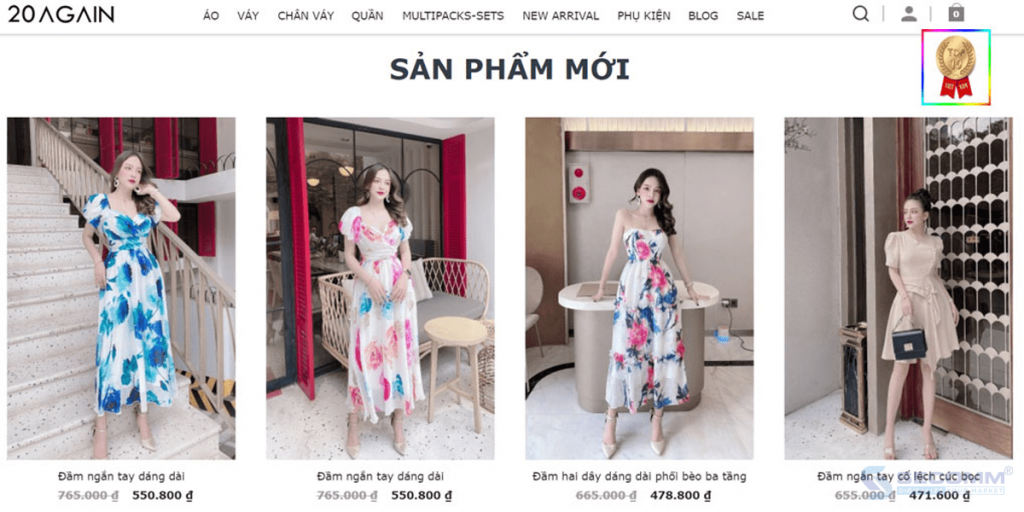
Contact SECOMM now for a free consultation on eCommerce development roadmap on Magento platform.
 3
3
 5,213
5,213
 0
0
 5
5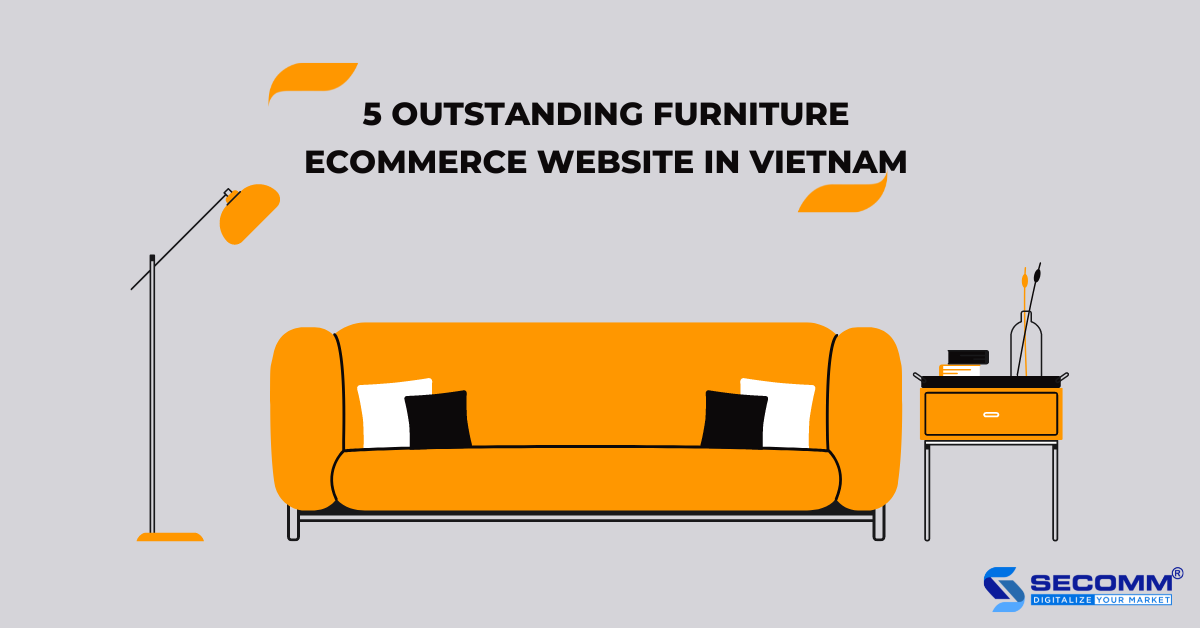
Businesses may quickly detect a change in consumer behavior throughout the course of the pandemic as online purchasing steadily expands from basic necessities like food and medicine to a variety of other industries like fashion, wine, and furniture.
Also, customers’ awareness of a pleasant, modern, and healthy lifestyle has grown dramatically, which has given the furniture business a chance to go online and serve as a catalyst for Vietnamese eCommerce furniture to see breakthrough growth.
Realizing the great potential of this field, Vietnamese furniture enterprises have been embarking on building an eCommerce website system, which is considered an important factor leading to the success of this modern business trend.
Initially founded in 2006 under the name Sieu Thi Noi That Uma, the business has only recently (in 2019) changed its name to Sieu Thi Noi That Trang Tri Baya.
Although the brand’s name has changed, its essential values haven’t. It still offers clients high-quality furniture with a clean, sophisticated, trendy design in a neutral tone, and each piece is beautiful in its own right.
Thanks to the wise investment in developing a professional eCommerce website with the Magento open-source platform with an attractive and user-friendly interface, Baya’s website currently receives more than 100,000 visits each month.
In order to give clients the best eCommerce experience, this furniture manufacturer is constantly improving the system.
In addition, the company demonstrated its awareness of market trends by creating an app called My Baya with a QR payment method and positioning it as one of the primary categories on an eCommerce website to draw consumers’ attention to the website.
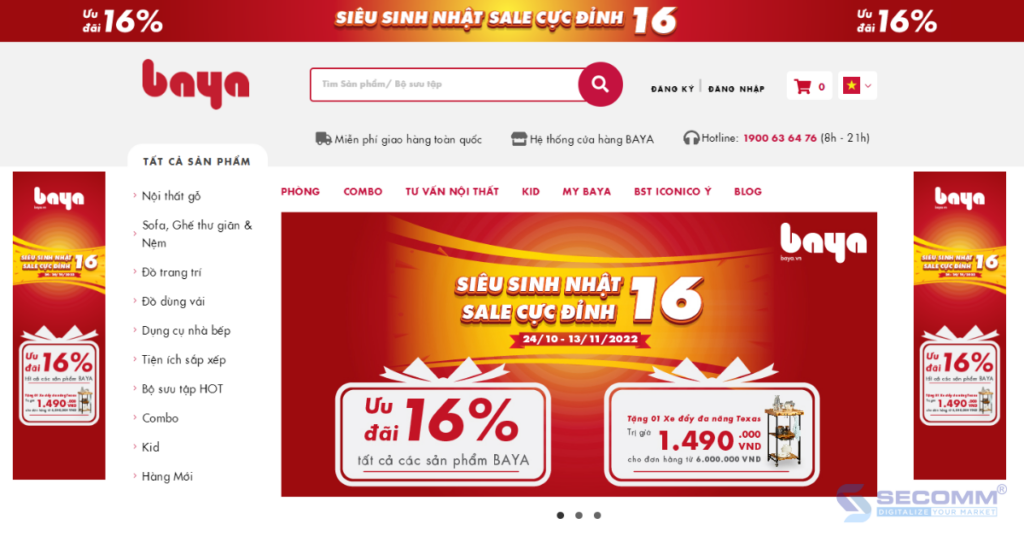
With nearly 30 years of market experience and a wide range of clients, Hoa Phat Furniture is one of the top furniture suppliers and manufacturers in Vietnam.
All of Hoa Phat’s items are designed with a contemporary, opulent, and refined aesthetic in mind. In addition to a business strategy that is flexibly adjusted to the changes in the market, the company fully exploits the potential of eCommerce by building a professional and well-organized website on the BigCommerce platform.
From there, businesses increase their coverage and brand awareness on the Internet and reach more customers thanks to effective marketing methods.
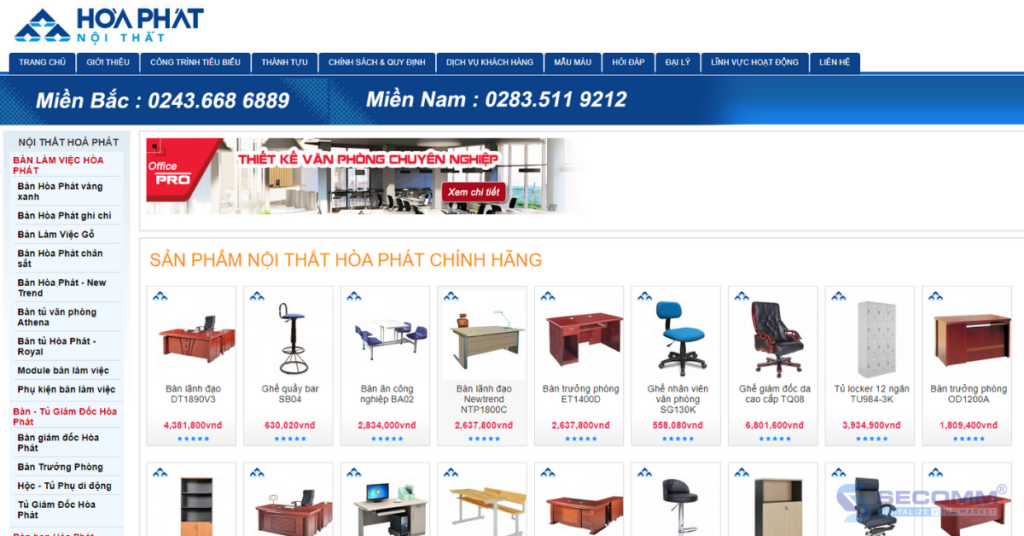
The Moho furniture brand was established in March 2020 and is a subsidiary of Savimex, a company with over 35 years of expertise in the production and export of furniture. In order to fulfill the goal of sustainable development, Moho has kept offering clients furniture goods with affordable pricing and quality in accordance with international standards.
With more than 50,000 monthly visitors and a popular Haravan platform, Moho’s eCommerce website is well-liked by customers for their online buying experience.
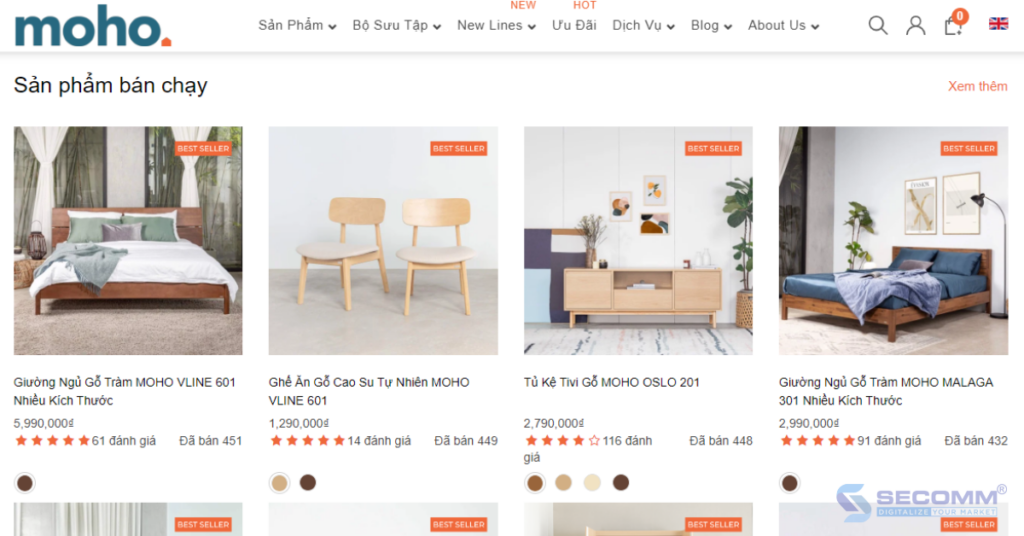
COZY is a famous furniture brand present in the market since 1995 with high-class Italian-style designs. All products distributed by COZY are subjected to quality checks. With more than 25 years of establishment and development, COZY is one of the leading prestigious units in Vietnam in importing furniture from high-end brands from Europe.
In order to increase sales channels and reach a large number of potential customers online, COZY invested in developing an eCommerce website using the Shopify platform in addition to the showroom system dispersed around the districts of Ho Chi Minh City.
Because of the website’s elegantly crafted, opulent, and smart user interface, it receives an astonishing 45,000 visitors each month.
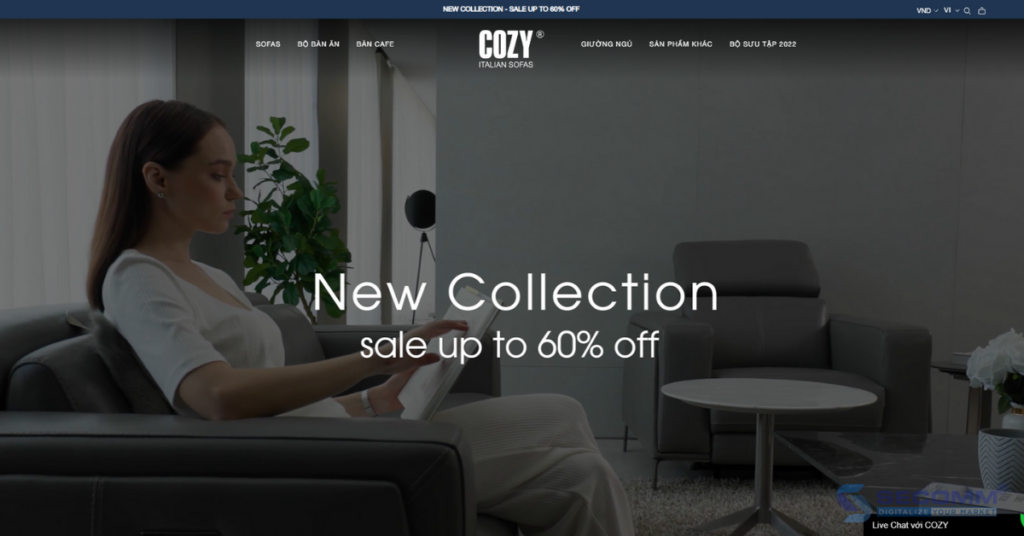
Nha Xinh chooses a simple and intimate interior design style for each of the company’s products. The WooCommerce platform’s straightforward and user-friendly design of Nha Xinh’s eCommerce website’s interface amply illustrates this.
Furthermore, Nha Xinh’s website uses 360-degree technology to enable buyers to experience the company’s interior items from a distance in an accurate manner, providing information and a complete price list for each item from every angle of the room and product.
The eCommerce website now receives more than 40,000 visitors each month because of its painstaking attention to every last detail.
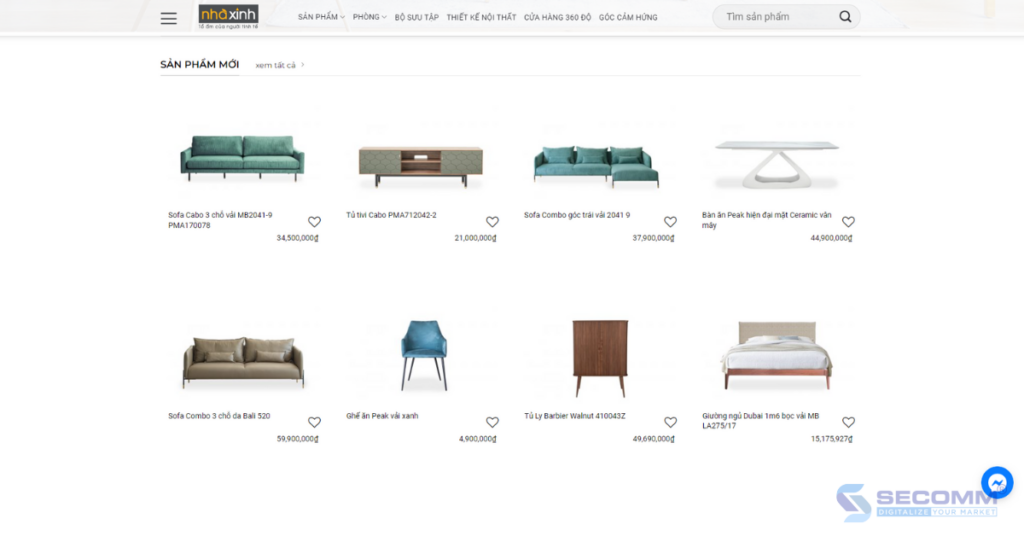
Customers can save a ton of time and money when shopping online, especially when purchasing furniture. However, there are a lot of potential hazards associated with this type of business, particularly with regard to product quality and information security, and safety during the shopping and payment processes.
The furniture eCommerce sites discussed in this blog post are well-known destinations that have been active on the market for a long time and have serviced and satiated the wide range and expanding needs of clients.
These companies demonstrate their efforts to create the technological infrastructure that will enhance customers’ online shopping experiences, and they take priority on the development of a professional, well-invested supply chain that will expedite shipments while maintaining the quality of the goods until they are received by the customer.
When Vietnamese furniture businesses launch their own fully-functional eCommerce websites, professionalism, adaptability, and speed are the key success criteria.
Nevertheless, in order for the furniture eCommerce firm to succeed, business managers must carefully and comprehensively take into account the growing client wants and the continuously shifting market trends.
In particular, the task is to lay out a solid and methodical company plan so that the best short- and long-term actions can be taken. Completing that difficult task will take a lot of time and resources. As a result, many furniture companies opt for a more straightforward approach to the issue, enlisting the assistance of a highly qualified and dependable unit.
With many years of experience in successfully implementing eCommerce for many customers in many countries, SECOMM specializes in providing consulting services with comprehensive and professional e-commerce implementation solutions. , repertoires.
Contact SECOMM today for free support and advice.
 2
2
 6,898
6,898
 0
0
 1
1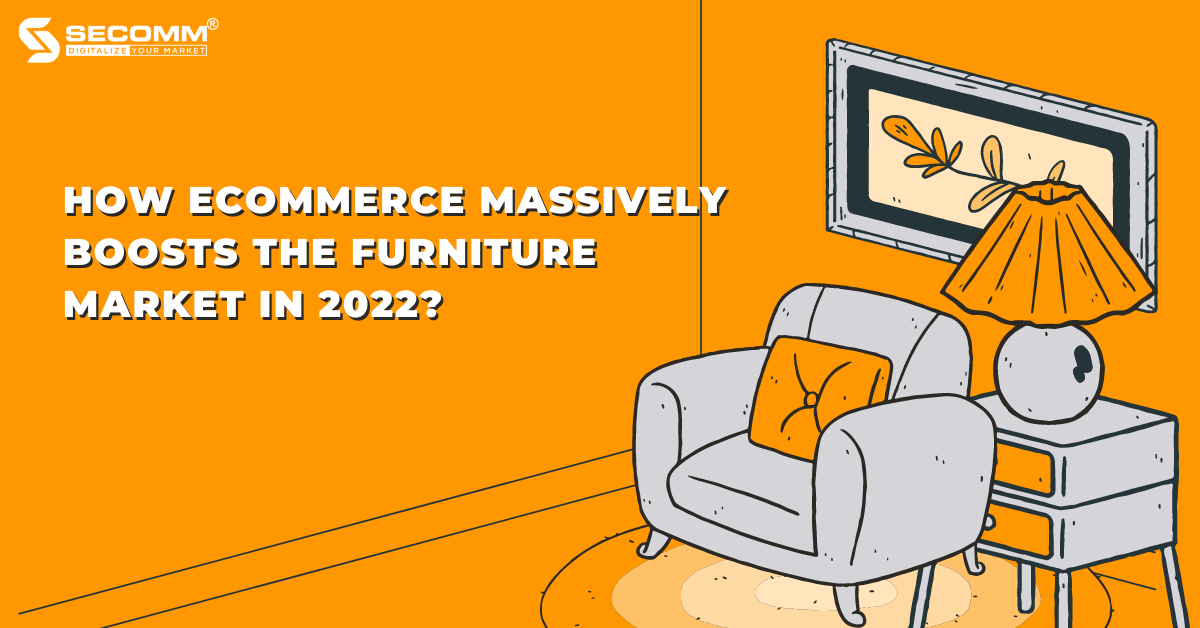
The desire for home furnishings and design among consumers has significantly increased as life gets better and better. The majority of consumers still prefer to choose and purchase products in physical stores and showrooms, but online furniture shopping is an increasing tendency. Additionally, the impact of the Covid-19 pandemic on consumer purchasing habits has changed how people purchase, which has greatly aided the development of the furniture eCommerce market.
BusinessWire estimates that the size of the furniture eCommerce market in 2021 was valued at USD 27.74 billion and that it would increase at a compound annual growth rate (CAGR) of 4.4% from 2022 to 2030 to reach USD 40.74 billion.
Recent findings made by Maddyness include the following intriguing details:
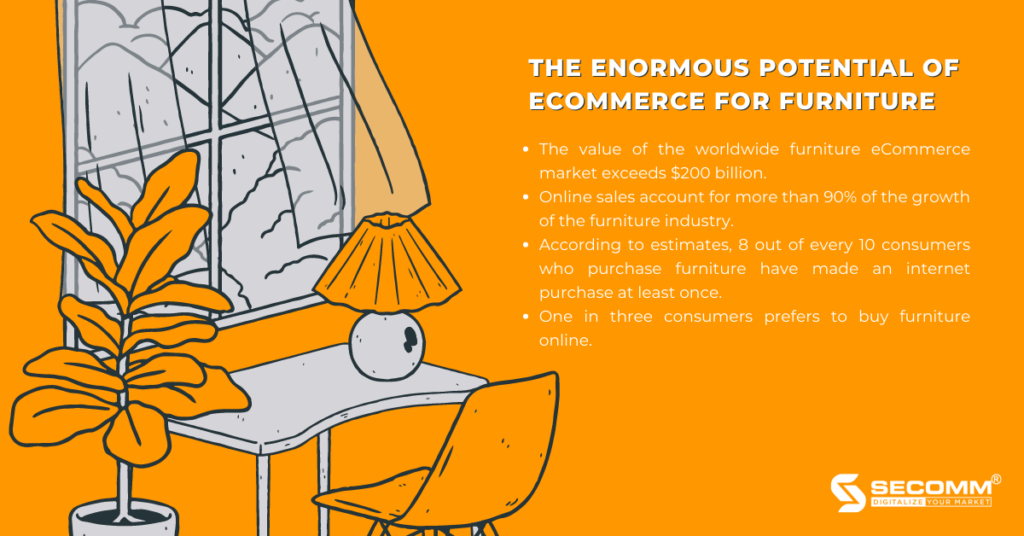
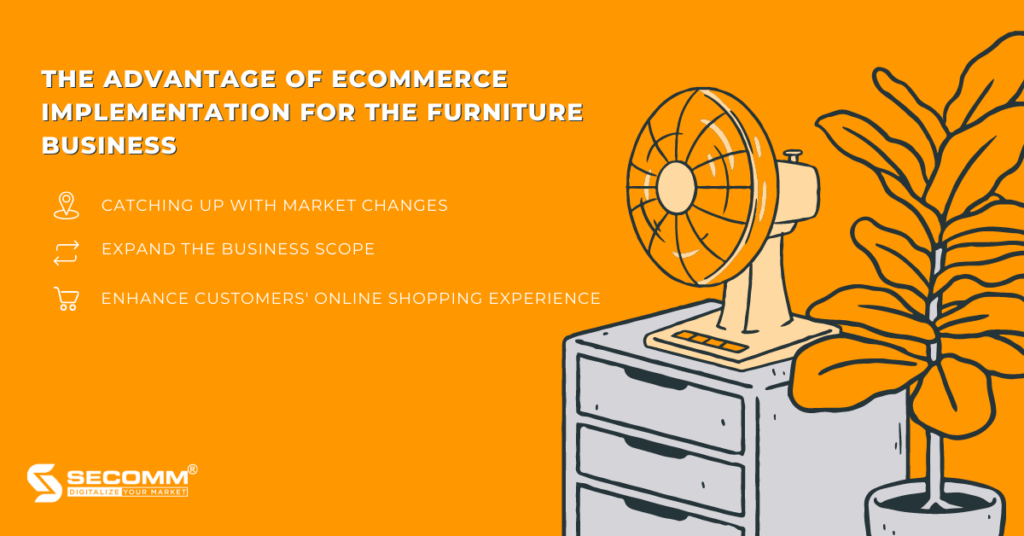
The furniture sector has experienced a significant decrease in sales over the past few pandemic years, along with many other industries.
People are compelled to reduce their social interactions during the social withdrawal period. They now spend more time working, living, entertaining, and teaching at home. In light of the unpredictable changes of the pandemic, the necessity to clean and renovate the dwelling has therefore substantially increased.
Due to limits on leaving the house, online shopping at the time had become not only a need but also an urgent method of purchasing in place of in-person purchases. That serves as the springboard that gives eCommerce its spectacular development and propels it into other industries like fashion, grocery, wine, and even furniture.
These two elements highlight the “cake’s” enormous potential and aid many furniture companies in realizing and swiftly implementing eCommerce for market revolution and sustainable development.
Due to the Internet’s rapid expansion and the burgeoning online shopping trend, which is gradually replacing traditional offline shopping, the adoption of eCommerce will benefit furniture manufacturers by providing a new sales channel and attracting a big number of potential clients (at stores, and showrooms).
eCommerce implementation will also help to broaden the market for businesses by improving the circumstances for marketing campaigns to be more successful.
When firms use technology to improve customer experience in eCommerce, furniture shopping will happen more quickly.
In the digital age, for instance, visual experiences from VR/AR technology, 3D product visualization, and 360-degree photography are very popular, gradually replacing in-store shopping while still being fully informed and realistic visualization of products, thereby increasing customer satisfaction during online shopping.
eCommerce enables businesses to quickly and effortlessly tailor the experience for customers by gathering, evaluating, and synthesizing the consumption behavior of each target group. Typically, this is done with the capabilities listed below: Products have seen, similar product recommendations, etc.
eCommerce provides clients with a seamless experience in addition to an intuitive one across a variety of channels, including social networks (Facebook, Instagram, Tiktok, Zalo, etc.), eCommerce platforms (Shopee, Lazada, Tiki, Sendo, etc.), eCommerce websites, mobile apps, etc.
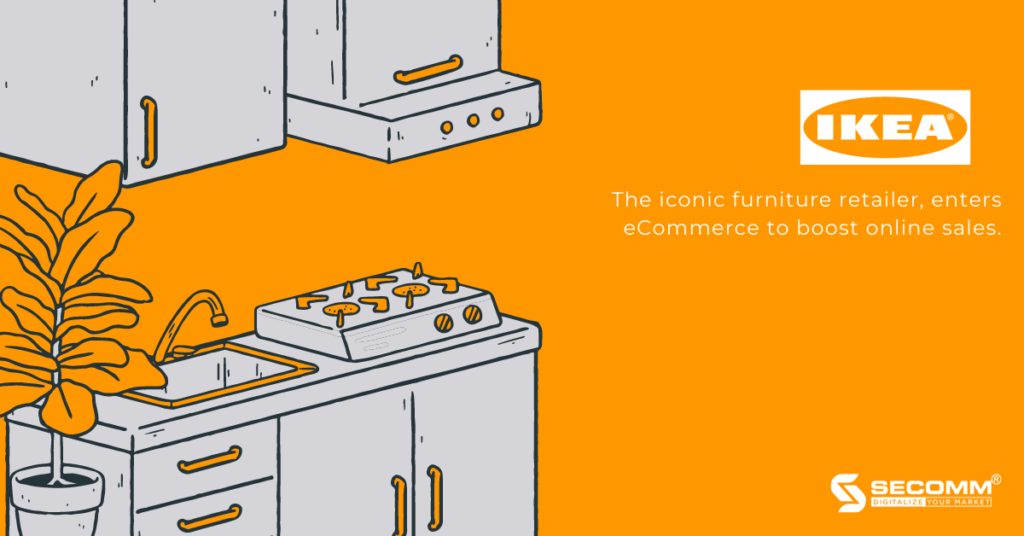
IKEA, or Ingvar Kamprad Elmtaryd Agunnaryd, is the world’s largest furniture retail enterprise and specializes in delivering minimalist-styled assembled furniture, household appliances, and accessories.
IKEA was established in 1943 in Sweden by Ingvar Kamprad, who started his business at the age of 17. IKEA swiftly gained global dominance with 392 locations across 48 nations.
With the goal of offering furniture with a lovely style and wide application while keeping the price low so that as many people as possible can purchase the goods. The majority of the departments, from marketing and sales to supply chain and warehouse, share this goal.
Everybody works together to keep IKEA’s “vital” competitive edge intact so that the company can publish catalogs with thousands of products offered at long-term stable prices.
Despite being the largest furniture retailer in the world, IKEA has lagged behind eCommerce trends, according to the Financial Times. This well-known retailer started “renovating” its sales technique only when it encountered numerous internet rivals.
The biggest barrier that makes it difficult for IKEA to adjust its previously successful business model is the maze-like arrangement of store layouts to create an engaging experience of sightseeing, interior shopping, or requiring customers to drive to the store and assemble the components to make their own furniture.
But IKEA has unimaginably succeeded in launching an e-commerce website by fusing cutting-edge technology with a well-organized marketing plan. In particular, IKEA specifically uses VR/AR technology, which is seen as a new eCommerce trend and is favored by many firms, to improve users’ online purchasing experiences.
IKEA thereby covers the sales void left by the prior on-site furniture business model, but the gap won’t truly be felt until the Covid-19 pandemic and social separation restrictions are in place.
From this point, IKEA expands its consumer base both online and offline, and sales are progressively encouraged to increase significantly.
Additionally, IKEA’s eCommerce website incorporates Instagram posts of photographs of IKEA furniture goods that consumers customize, share, and tag with the hashtag #IKEA.
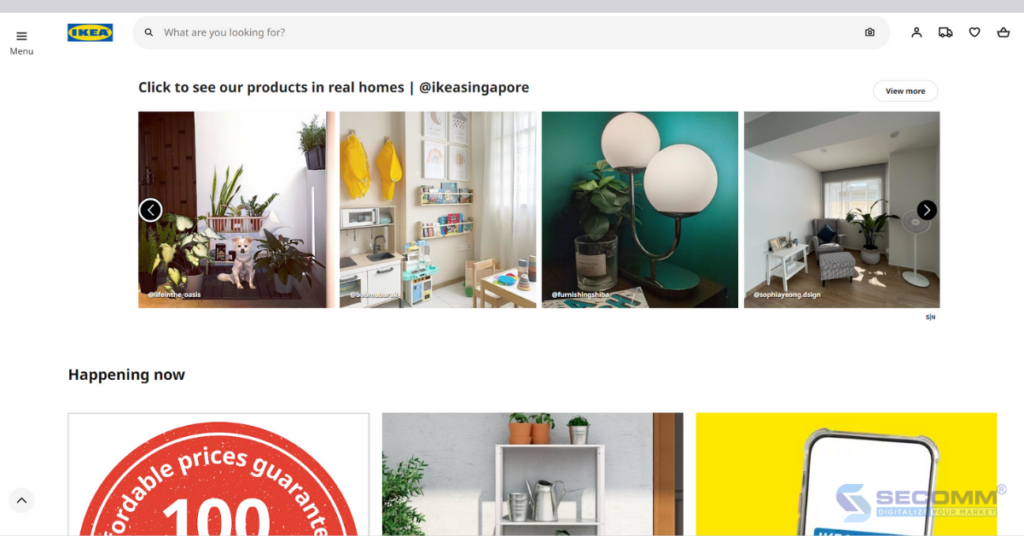
This not only helps this brand connect closely with Instagram users, increase its reputation and strengthen the loyalty of existing customers but above all, quick access to a large diverse customer base from the Internet in general and Instagram in particular thanks to the popularity and influence of this social network on young consumers.
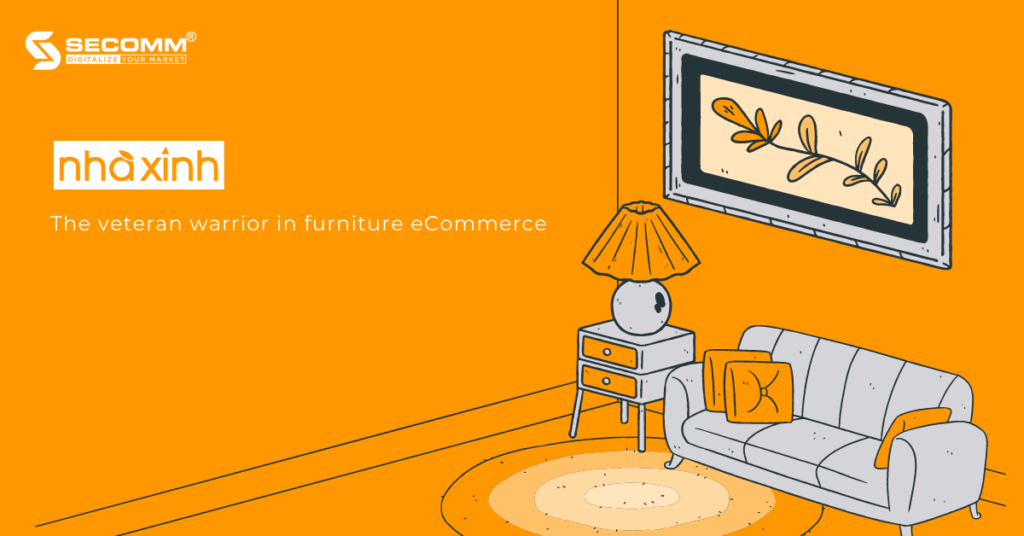
Established in 1999, Nha Xinh is a well-known furniture brand in Vietnam. It has two sizable showrooms, one each in Hanoi and Ho Chi Minh City.
As a manufacturer and supplier of living room, bedroom, dining room, and kitchen furniture with an Asian design aesthetic that favors coziness, friendliness, and simplicity above sophistication and luxury, Nha Xinh is a specialist in this field.
Nha Xinh’s website belonged to the “long-lived” row in the Vietnamese eCommerce village when it was created and launched in 2007, a period in which Vietnam was still getting used to utilizing the Internet to progressively integrate with the rest of the world.
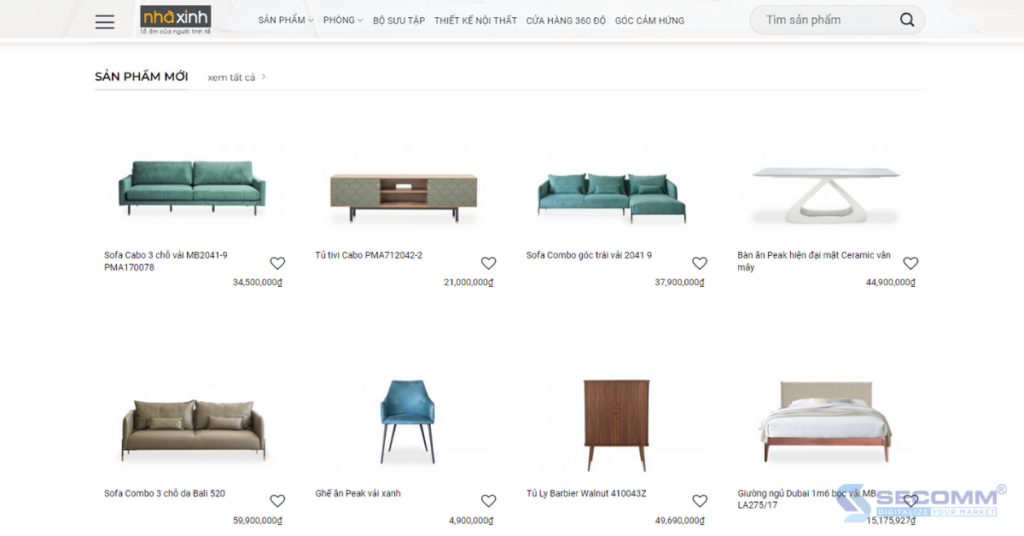
Nha Xinh’s eCommerce website has survived many years of market ups and downs while maintaining its inherent simplicity, intimacy, and sophistication.
Product categories are arranged clearly and harmoniously in each room to make it easy for customers to search, choose products that suit their needs, and get a sense of the room’s overall layout.
Customers can choose from a variety of options because the room’s layout is available with furniture and includes a detailed price. If they prefer, they can even select a combination of the interior and decor of the room without having to spend a lot of time figuring out how to combine each item because Nha Xinh already did it.
Additionally, Nha Xinh’s website has a unique section called “360-degree store” that uses 360-degree technology to let customers view the company’s interior products from a distance in an accurate manner from every nook and cranny of the room and every angle of the product, along with comprehensive information and price lists for each item.
Additionally, Nha Xinh’s “Inspiration Corner” catalog offers a wealth of thoughts and ideas to assist clients in designing their dream living space. Nha Xinh gives home design recommendations in a variety of styles, from elegant, and gentle to strong and personable depending on the individual’s preferences.
Therefore, Nha Xinh is more than just an eCommerce site that sells furniture; it is also a handbook that provides customers with never-ending design ideas.
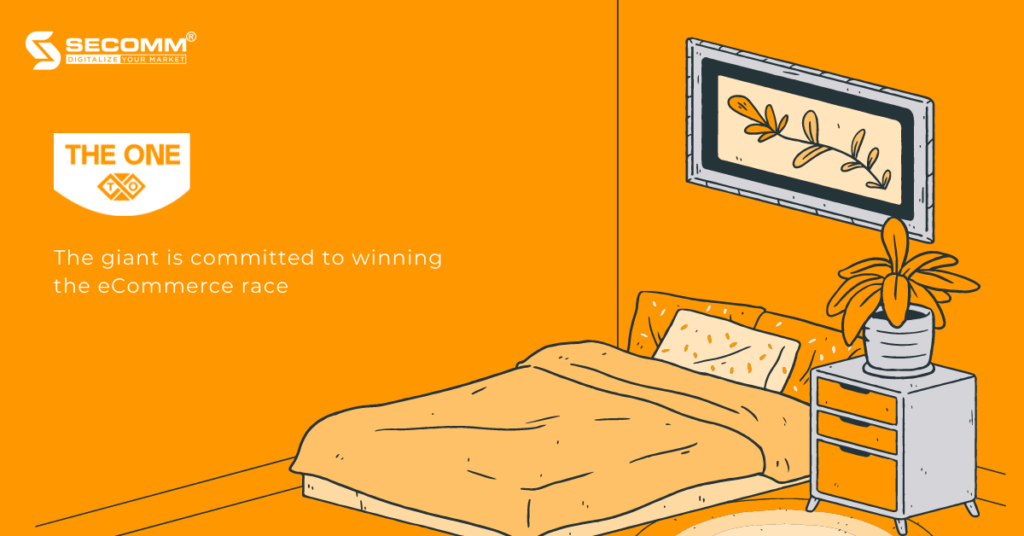
Hoa Phat Furniture was founded in 1995 and over the course of over three decades has made a positive impact on Vietnamese consumers’ perceptions of quality products and exquisite design while fulfilling a variety of needs for office furniture, home, household furniture, and medical furniture.
With a consistent growth rate of 20–25% each year, the brand is getting stronger and reaffirming its position as Vietnam’s top supplier and manufacturer of furniture.
When Hoa Phat Furniture changed its name to The One Furniture in the year 2022, it left a lasting impression on the industry. The brand name change is linked to adaptable changes in strategy. The company focuses on enhancing the stature, appearance, and image connected with the growth of the nation, helping to instill a variety of ideals into society.
Hoa Phat Furniture (now The One Furniture) invests extensively in technology infrastructure to streamline the production and supply process at the same time as it aspires to expand throughout the area and the world. One might say that The One Furniture has carried on the brand’s good core principles and improved upon them in order to better suit the current market trend.
One of Hoa Phat Furniture’s greatest successes to date is the effective use of 3D printing technology in production, which has helped the company create a number of new products like the Smart Safe; sofa and chair folding in the Italian style while also reducing production costs and speeding up prototyping and increasing product accuracy.
Hoa Phat Furniture concentrates on creating an eCommerce website to reach many potential clients that have a habit or preference for online buying, in addition to being adaptable and prompt with changes in strategy.
The firm creates websites using the WooCommerce framework, a well-known and dependable open-source platform used by many companies to implement eCommerce.
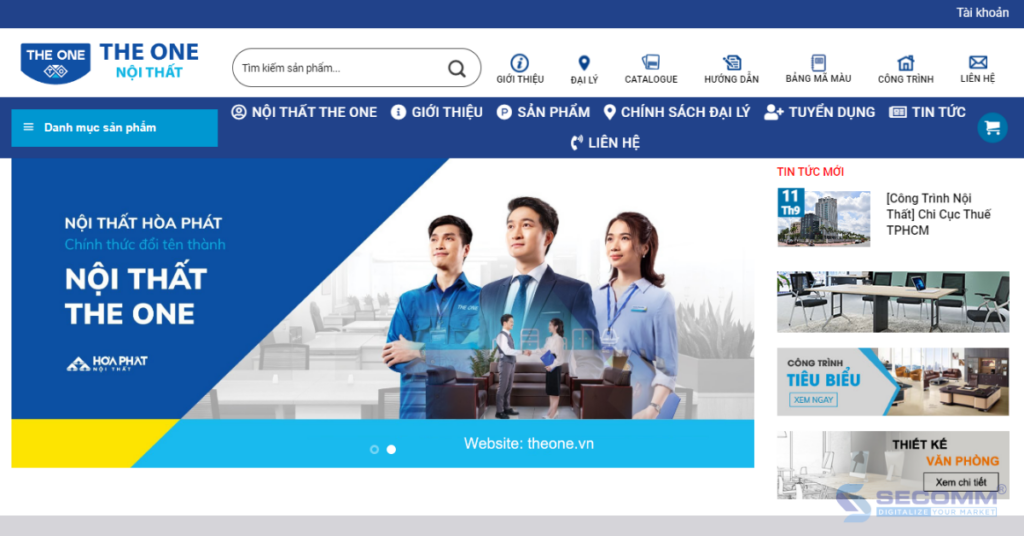
Compared to the previous version of Hoa Phat Furniture, The One Furniture’s new website (noithattheone.com.vn) features a more simplified, gorgeous, and contemporary interface (noithathoaphat.com.vn).
Additionally, the business supports the growth of well-known social media platforms like Facebook, Instagram, Youtube, and TikTok to broaden brand awareness, attract more customers, and enhance coverage.
Plus, the business offers a wide range of shipping and payment choices to accommodate the various needs of clients, making online buying at The One Furniture or Hoa Phat Furniture as convenient as it can be.
It is clear that the growth of the furniture market has been hastened by the speed at which eCommerce is developing.
Today, numerous local and international furniture companies participate in and offer the greatest shopping experiences to customers through the effective implementation of an eCommerce website, including IKEA (Sweden), Nha Xinh, and Hoa Phat Furniture (Vietnam).
From there, companies may quickly connect with a wider pool of Internet users and generate conversions through efficient marketing strategies.
However, business leaders need to carefully and comprehensively take into account the growing customer expectations and rapidly shifting market trends, not to mention specifically describe a systematic and precise business strategy for taking the most advantageous actions in the short and long term.
Completing that difficult task will take a lot of time and resources. As a result, many furniture companies opt for a more straightforward approach to the issue, enlisting the assistance of a highly qualified and dependable unit.
SECOMM has many years of expertise in effectively executing eCommerce for numerous customers in various countries. We specialize in offering free consultation services with qualified eCommerce implementation solutions.
Contact us right away for free counsel and assistance.
 2
2
 4,664
4,664
 0
0
 1
1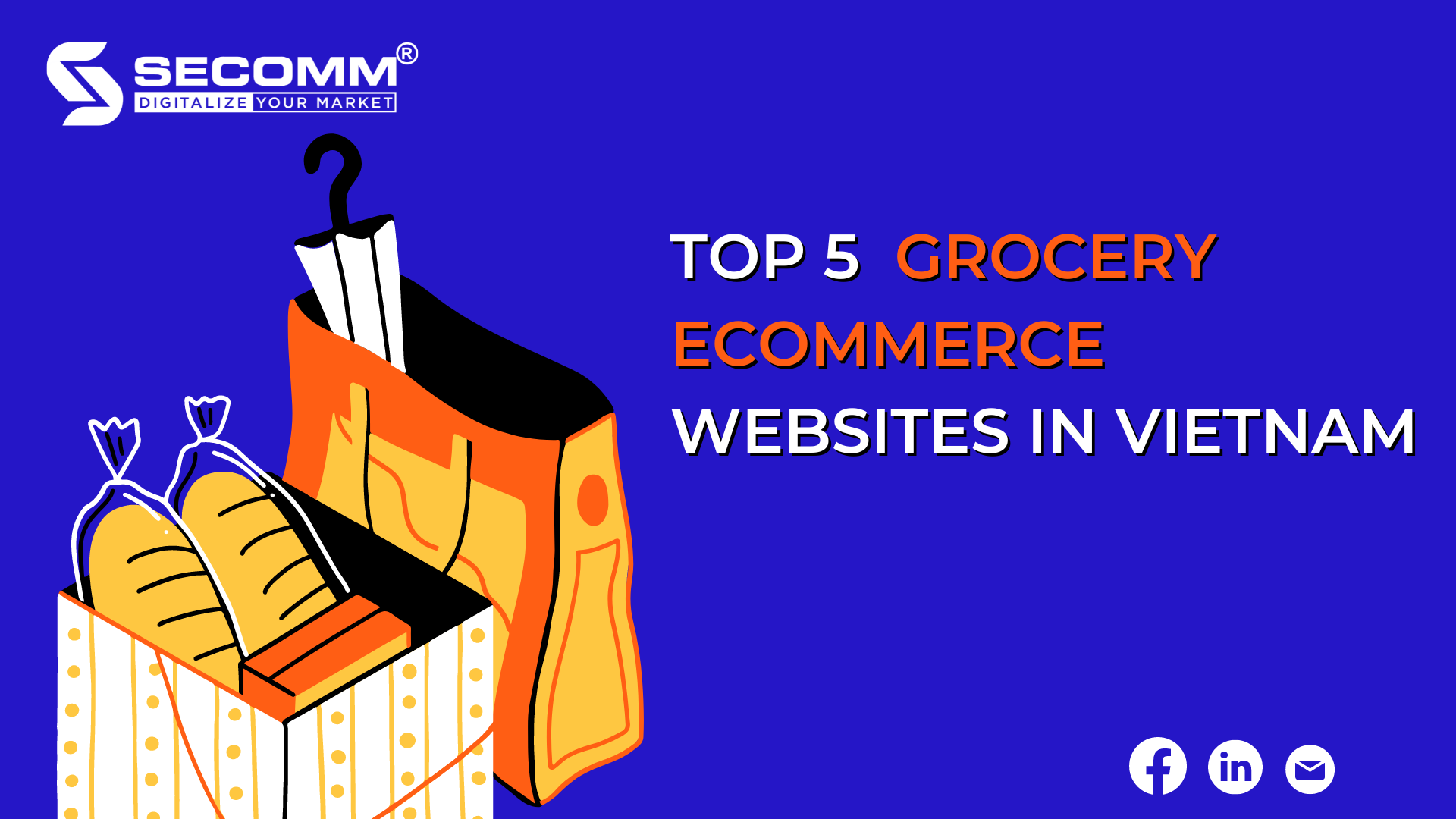
Grocery eCommerce is a trend in eCommerce that allows customers to buy goods online. This is regarded as the leading industry in the eCommerce market, particularly in Vietnam. According to an iPrice report, when people began staying at home to avoid the Covid-19 epidemic, traffic to websites specializing in the grocery business increased 45% faster than before. This trend remained stable after the social distancing was reduced, increasing by 10% at the end of the year. Online grocery is the only category that has seen consistent growth throughout the pandemic, with search demand continuing to rise.
There are some popular grocery eCommerce websites in Vietnam can be mentioned as:
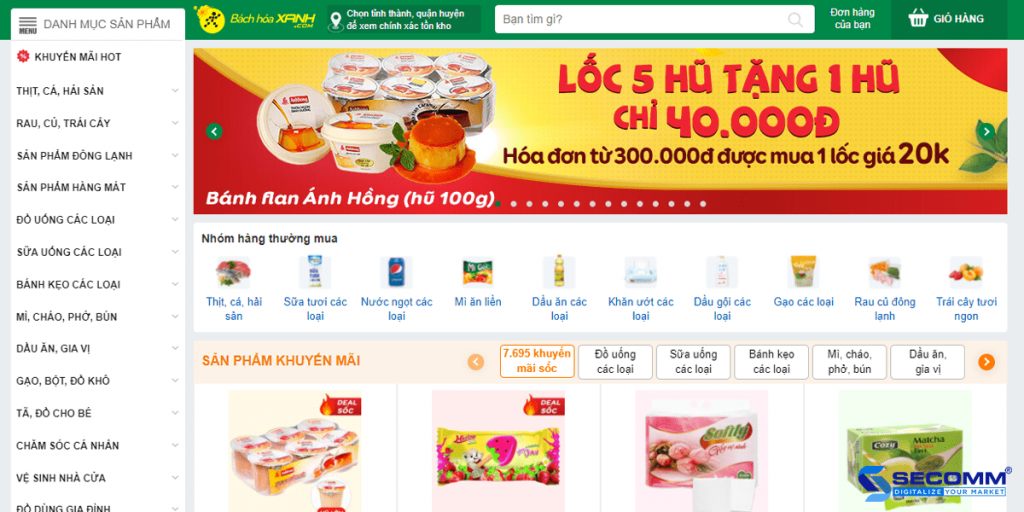
Bach Hoa Xanh is one of the most popular grocery store chain owned by Mobile World Joint Stock Company that specializes in selling fresh food and necessities. Bach Hoa Xanh currently operates nearly 2,000 stores in the South, East, and South Central provinces. This is the most visited website in the top five most visited websites in the Vietnam market, behind only the top four eCommerce platforms today, namely Shopee, Lazada, Tiki, and Sendo (According to iPrice).
– Website: https://www.bachhoaxanh.com/
– Traffic: 1.1M/month
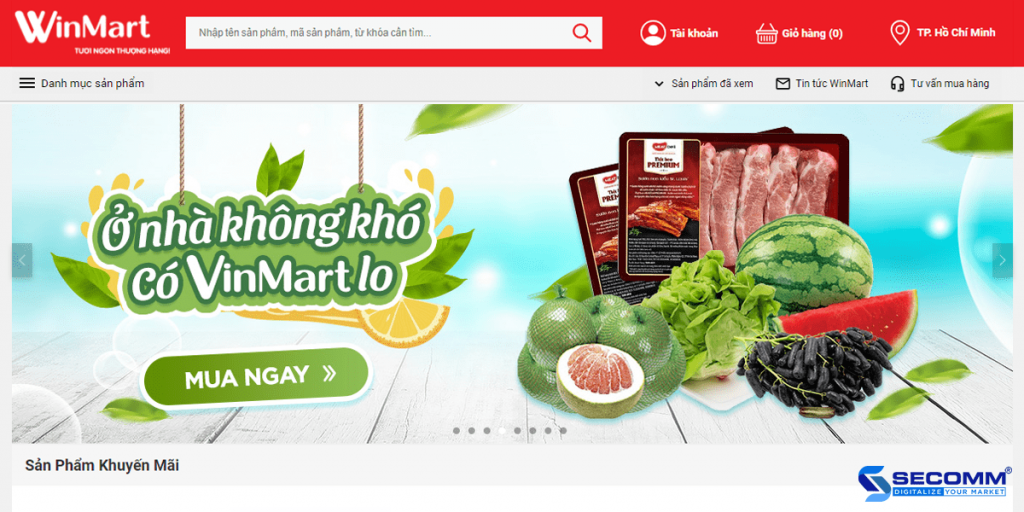
WinMart is a supermarket system and grocery store chain purchased by Masan Group from Vingroup. This brand was more commonly known as Vinmart at that time.
– Website: https://winmart.vn/
-Traffic: 209.5K/month
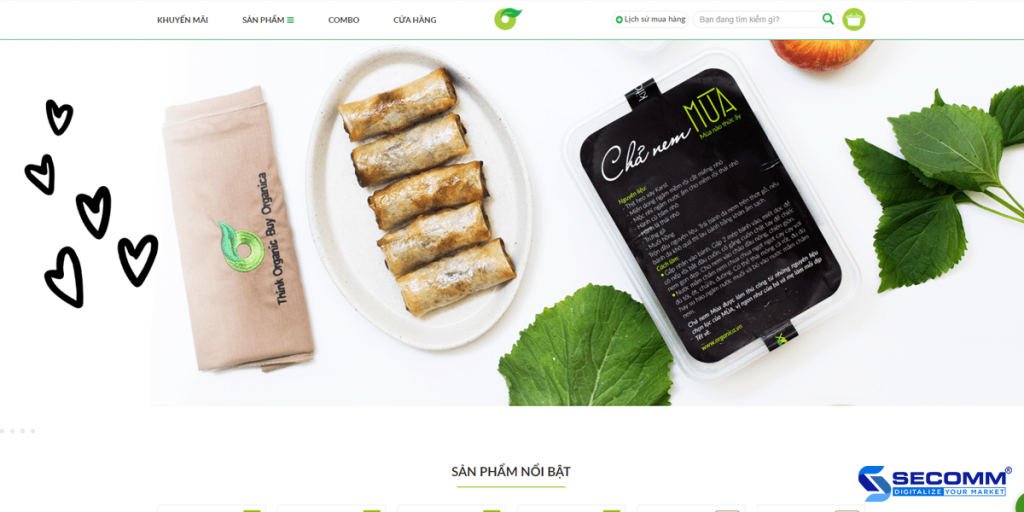
Organica is a natural and non-GMO certified organic food development and distribution system.
– Website: https://www.organica.vn/
– Traffic: 27.2K/month
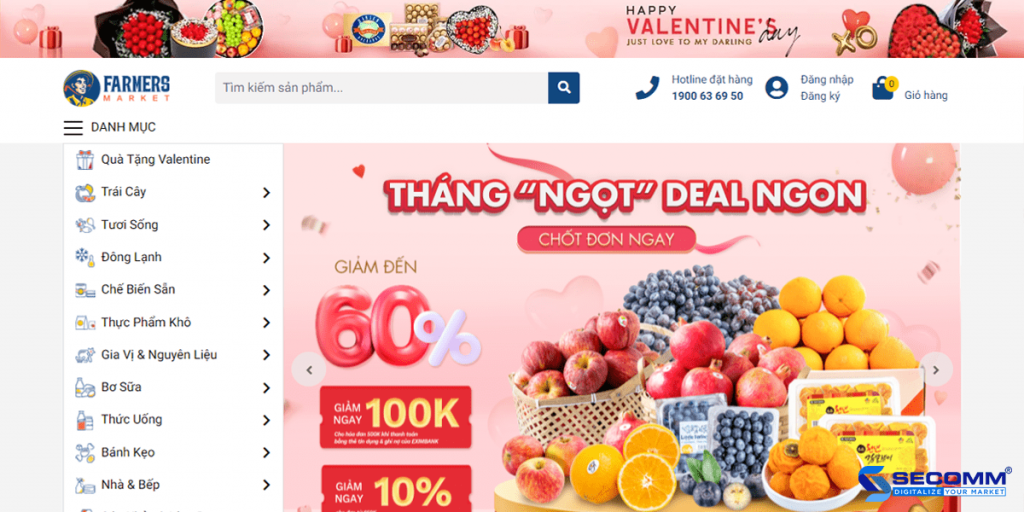
Farmer’s Market is a fresh food chain store brand managed by LARIA Trading Co., Ltd. To provide a seamless shopping experience O2O (online to offline), the company has built an omni-channel retail system serving over 4,000 customers daily.
– Website: https://farmersmarket.vn/
– Traffic: 17.5K/month
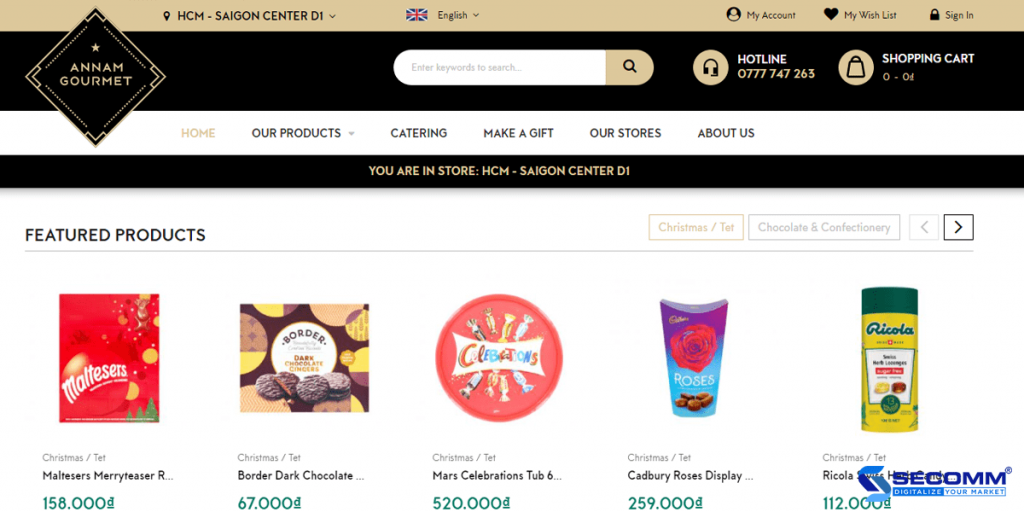
Annam Gourmet arose from the two Annam Group founders’ deep love of European cuisine. Annam Gourmet chain stores have been successfully operating in the Vietnamese market for over 20 years, offering high-quality imported product lines such as high-end food, wine, beverages, and cosmetics.
– Website: https://shop.annam-gourmet.com/
-Traffic: 8.7K/month
With a 200% annual growth rate, the future potential of grocery eCommerce in the Vietnamese market is undeniable (according to Statista). There are numerous opportunities in the eGrocery industry. Recently, many challenges have arisen, necessitating careful consideration of tactics by business managers in order to take the most effective steps.
The eGrocery businesses have opportunities and challenges, requiring business managers to consider tactics to take the most effective steps. Finding a partner is tricky and building an in-house team is tough. Businesses must incur significant opportunity costs and time to reach the goal.
Our company – SECOMM has been partnering with many big enterprises such as An Nam Group (Vietnam), Jasnor (Australia), and Changi Airport Group (Singapore). We are aware of the challenges and worries faced by firms while developing an e-commerce website system.
Get in touch with us now for FREE eCommerce consultancy and solutions in eGrocery businesses.
 2
2
 8,807
8,807
 0
0
 1
1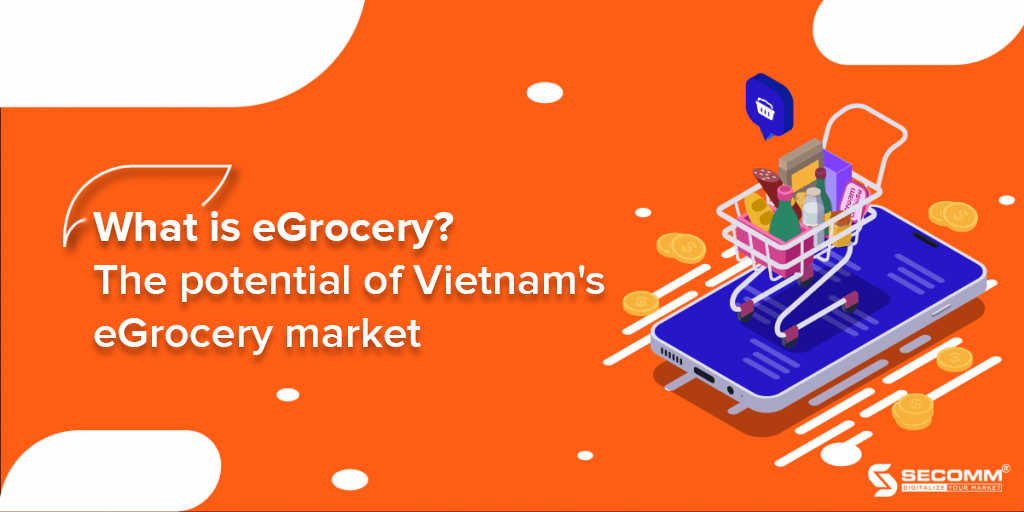
According to the VISA’s data in 2021 – the world’s leading electronic payment technology company, up to 87% of Vietnamese consumers surveyed are currently using home delivery services, of which 82% said that the first time they used this service was since the Covid-19 outbreak occurred.
That further confirms that social distancing and work-from-home models have led to significant consumer shopping behavior changes. In particular, the transition from the direct shopping experience to e-commerce has taken place rapidly in just a few months. One of the industries that have benefited the most from the boom in the e-commerce market is eGrocery.

eGrocery (or Grocery Ecommerce) includes online business activities of grocery products such as food (both fresh and prepackaged), household products, healthcare, personal care, etc. Product display, ordering to pay, and shipping are all done on the website of eGrocery businesses.
Some successful eGrocery businesses in the Vietnamese market are Bach Hoa Xanh, An Nam Gourmet, Organica, Farmer’s Market, etc.
Covid-19 is a powerful catalyst, one of the impulses to boost the grocery industry’s demand for shopping for essential products. According to a report from iPrice, websites specializing in the grocery business grew by 45% in traffic when people started staying at home to prevent the epidemic. After the social distancing eases, this trend remains stable, increasing by 10% by the end of 2021. eGrocery is the only industry that has maintained solid growth throughout the pandemic since the beginning of the pandemic, with search demand still increasing steadily.
Additionally, with revenue coming from the U.S, the worldwide eGrocery market is also highly active. The grocery e-commerce business is anticipated to surpass $20 billion in 2021 and $24 billion in 2023 (Statista). According to Redseer’s report, India’s eGrocery market is estimated to reach $10.5 billion by 2023.
Seeing the vast potential that the eGrocery market may bring, now there are many “big guys” not from the traditional grocery industry who also jump in to fight for this lucrative “piece of cake” like Con Cung, Kids Plaza, etc.
BigBasket was founded in 2011 by V.S. Sudhakar, Hari Menon, V.S. Ramesh, Vipul Parekh, and Abhinay Choudhari. In May 2021, Tata Group’s acquisition of 64% of BigBasket shares helped push BigBasket’s valuation to $1.85 billion.
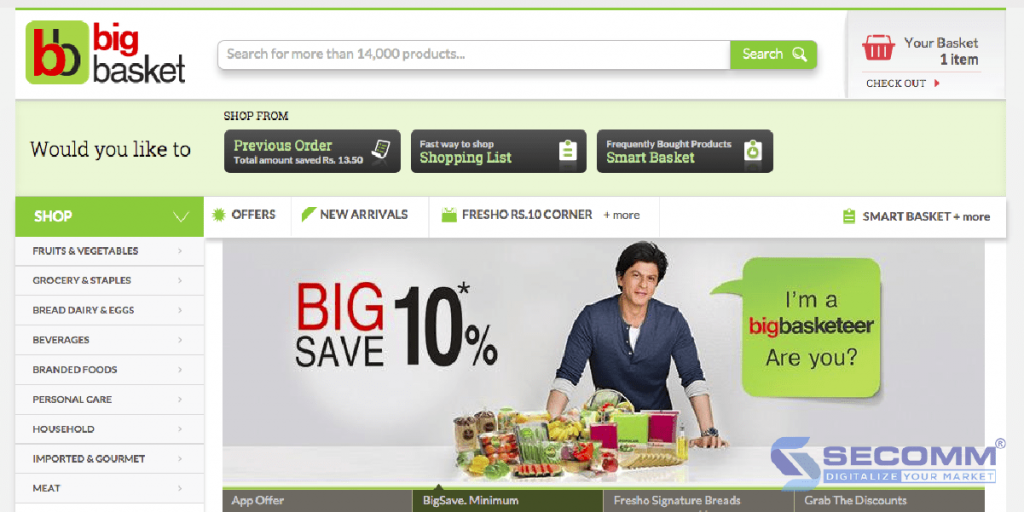
By promoting the research and development of transportation services and expanding the logistics function system in the enterprise’s e-commerce website, in 2016, BigBasket made fast deliveries within 60 minutes. In the same year, BigBasket also built a B2B delivery service to serve the food needs of restaurants and customers in major Indian cities. This business strategy has been a solid stepping stone for the BigBasket brand in the Indian online department since 2017
Grofers is India’s 3rd largest grocery e-commerce platform, with about 13% of the market share, behind only BigBasket (37%) and Amazon (15%). Founded in 2013 by two technology engineers, Albinder Dhindsa and Saurabh Kumar, after the two founders noticed a massive gap in the local logistics services.
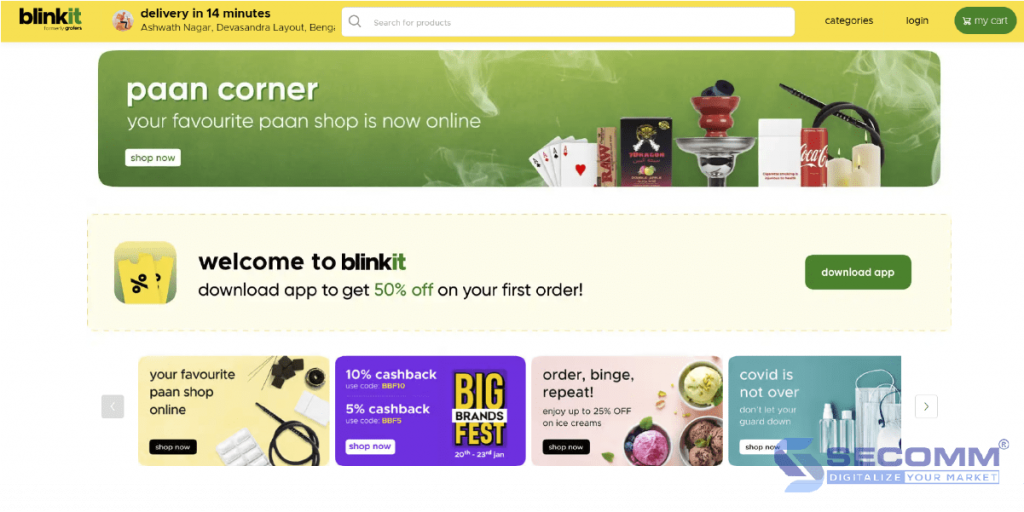
Initially, Grofers only specialized in supplying grocery products such as packaged food, bakery products, mother and baby care, pets, etc., to local grocery stores, medical, restaurants, or supermarkets. But thanks to the advancements in technology successfully applied in the e-commerce strategy, Blinkit has rapidly expanded its business successfully in 28 Indian cities.
On December 13, 2021, Grofers officially changed its brand name to Blinkit to deliver within 10 minutes. Like BigBasket, Blinkit also focuses on developing its logistics system and expanding its network of partner brands on its e-commerce website. Blinkit has more than 60 partners in New Delhi, more than 30 partners in Gurgaon, and many in Mumbai, Kolkata, Bengaluru, etc.
Bach Hoa Xanh is a mini supermarket chain selling fresh food and necessities under the Mobile World Joint Stock Company (MWG). Bach Hoa Xanh has nearly 2,000 stores across the South, East, and South Central provinces. According to iPrice, this website is in the top 5 most visited e-commerce websites in Vietnam, just behind four e-commerce platforms (Shopee, Lazada, Tiki, and Sendo).\
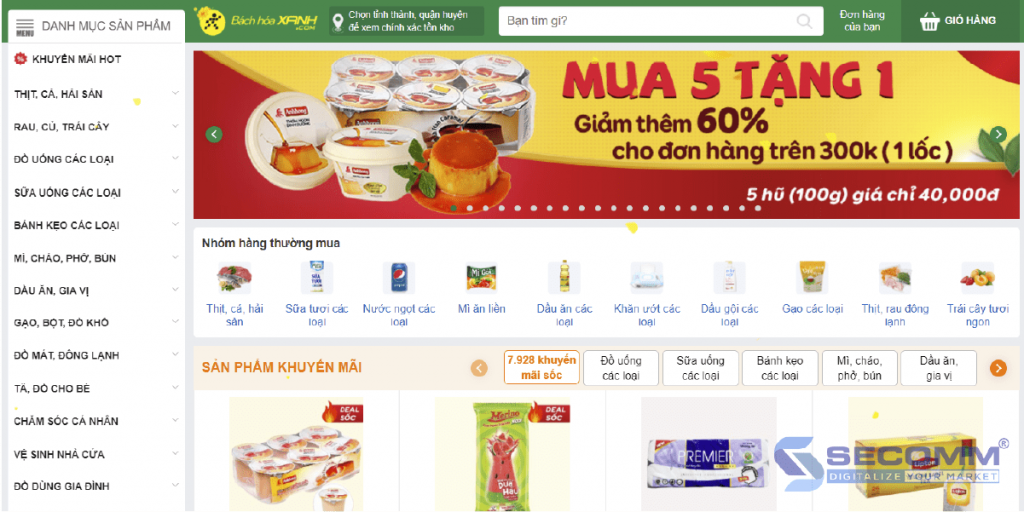
Since its establishment in 2015, Bach Hoa Xanh has advocated two key campaigns, competing with traditional markets and developing e-commerce websites. At first, Bach Hoa Xanh set up branches at selling points near the market, but in suburban areas and provinces, the space rental cost is much more affordable than in the central area. At the same time, the company creates a website system to boost online sales channels and draw in customers who enjoy making purchases online, particularly young people.
These days, the company has officially entered the Vietnamese retail “triad association” with Saigon Coop and WinMart (formerly VinMart), achieving a record of 26,300 billion VND in revenue in 2021 – an increase of 38% compared to the first 11 months of 2020.
Besides Bach Hoa Xanh, some other successful businesses have been applying grocery e-commerce, such as An Nam Market (specializing in serving foreign customers or former international students in Vietnam); Organica (focusing on offering customers from around the world ecologically friendly items), etc.
eGrocery is still in development and has not yet formally taken off. Thus the market’s growth potential is still tremendous despite the existence of several major companies. To confidently enter this lucrative market, grocery stores in Vietnam can use the lessons learned from their forebears and select a platform to construct a website system that fits the e-commerce business model.
Our company – SECOMM has been partnering with many big enterprises such as An Nam Group (Vietnam), Jasnor (Australia), and Changi Airport Group (Singapore). We are aware of the challenges and worries faced by firms while developing an e-commerce website system.
Get in touch with us now for FREE ecommerce consultancy and solutions in eGrocery businesses.
 2
2
 5,135
5,135
 0
0
 1
1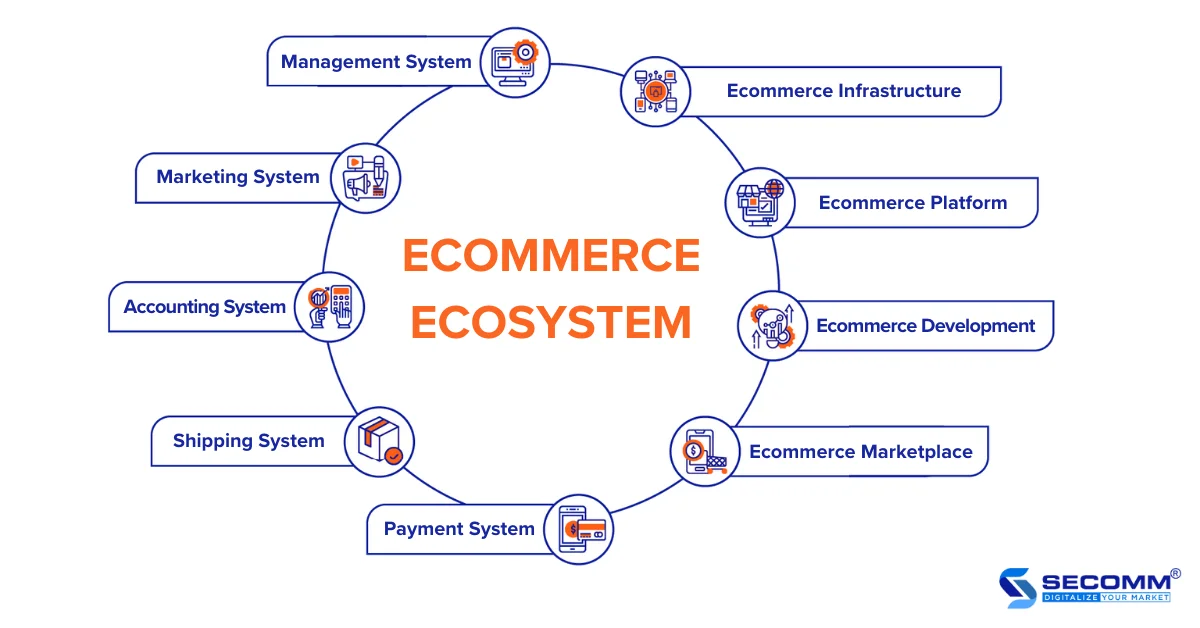
The ecommerce (Electronic Commerce) ecosystem is an open space that facilitates all interactions, connecting human factors, social elements, and information technology platforms with applications and services to provide value and efficiently operate components within the ecosystem. So, what are the components of the ecommerce ecosystem?
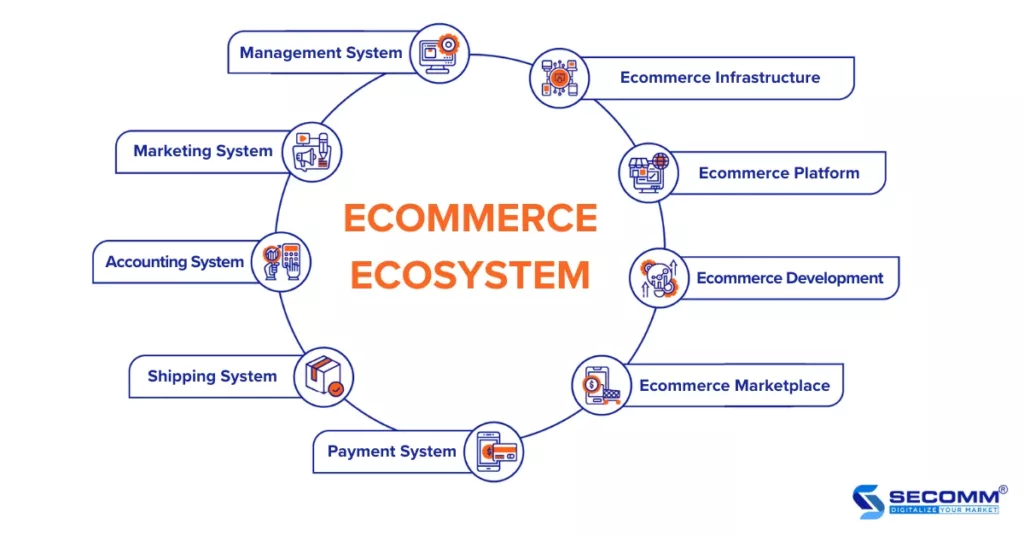
The system includes hardware (servers and devices), software (services/tools for management, and analysis), network systems, and physical facilities that form the foundation for the remaining components, ensuring smooth and efficient ecommerce processes.
Software applications are used to build and manage all activities within the system. Currently, businesses often use platforms such as Magento, Shopify, BigCommerce, WooCommerce, Haravan, and Wix to create ecommerce websites.
Provides services and solutions for developing websites, systems, and ecommerce processes. Some popular ecommerce solution providers in Vietnam include SECOMM, SmartOSC, Isobar, etc.
Provides an environment and all the services supporting ecommerce, allowing easy buying and selling between multiple sellers and buyers. Popular ecommerce marketplaces in Vietnam include Shopee, Lazada, Tiki, Sendo, etc.
Includes networks, systems, and devices processing all transactions within ecommerce. In addition to common payment methods such as cash, card payments (domestic cards, Visa, Mastercard, etc.), payment gateways (OnePay, PayPal, etc.), and e-wallets (Momo, ZaloPay, etc.) are developing in Vietnam.
The shipping system includes all processes for managing, distributing goods from warehouses, packaging, and delivering to customers. Popular shipping service providers in Vietnam include Giao Hàng Tiết Kiệm, Giao Hàng Nhanh, ViettelPost, J&T, Ahamove, etc.
Supports businesses in managing data related to invoices, sales revenue, and all financial flows in ecommerce activities. The emergence of e-invoicing software such as E-Invoice, MISA meInvoice, FPT.eInvoice, etc., has greatly supported accounting processes.
Marketing activities support effective brand and product development, reaching and personalizing customer experiences through strategies, channels, and supporting tools.
Uses resource management and operational process management software to enhance seamlessness and efficiency for the entire ecommerce system. Commonly used management systems include ERP, CRM, IMS, POS, OFM, etc.
In general, the components of the ecom ecosystem operate through a system of mechanisms, policies, and consistent laws to form a secure electronic data exchange system, ensuring the rights and responsibilities of businesses and consumers.
To achieve outstanding and sustainable growth, besides optimizing opportunities, businesses need to build a complete for themselves, creating a platform to enhance interactions between businesses, the market, and users more robustly. However, most Vietnamese businesses still face many challenges in building their ecommerce business plans. The majority of businesses have not correctly identified the necessary and appropriate components for their business models, leading to issues related to deployment time and budget constraints.
 2
2
 7,294
7,294
 0
0
 2
2Subscribe to get the latest eBook!
Hotline